How Fast Do Catamarans Go?

Catamarans are known for their speed, and some vessels are fast enough to break world sailing speed records.
Catamarans can go between 15 and 30 knots, with the fastest achieving speeds well in excess of 60 knots. Sailing catamarans are sometimes twice as fast as monohulls and cut through the water with greater efficiency.
In this article, we’ll cover how fast catamarans can go based on factors such as size, sail area, and design category. Additionally, we’ll compare catamaran speeds to monohulls and trimarans and cover the reasons why multi-hull sailboats blow monohulls out of the water.
We sourced the information used in this article from sailing guides and hull speed calculations. Additionally, we sourced information directly from the manufacturers of common catamarans.
Table of contents

Catamaran Speed by Type
Catamaran design can be split into different categories. After all, different vessels are designed for different tasks, as speed isn’t always the most important design consideration.
The fastest type of catamaran is the ultralight racing catamaran. These vessels have extremely narrow hulls and a remarkable planing ability. They’re designed to pierce waves and often achieve speeds in excess of 45 knots or greater, depending on conditions.
The second fastest catamaran variety is the sport catamaran. Sport catamarans often include a fairly good level of creature comforts in the cabin. They’re technically hybrid designs, because they are envisioned as a combination between a racer and a cruiser. Sport catamarans can achieve 30 knots or greater.
Cruising catamarans are designed primarily for safety and comfort. They’re often used for long offshore passages, where speed is important, but comfort is king. Despite their accommodations, cruising catamarans can still achieve a respectable 15 to 20 knots of speed—sometimes 50% faster than similarly-equipped monohulls.
Why are Catamarans So Fast?
Catamarans are remarkable vessels that can achieve amazing speeds. As a result of their unconventional design, typical calculations for hull speed (such as those used for monohulls) don’t always apply.
But what makes catamarans so much faster than equivalent monohulls? The first and most obvious speedy design element are the hulls themselves.
Catamarans don’t have a deep keel or a centerboard. This is because the second hull acts as a stabilizing device, and it helps the vessel track straight. The lack of a keel reduces weight (and equally important). It also reduces drag.
Additionally, catamarans behave in strange ways while underway. The hulls have a tendency to rise out of the water further the faster they go. This further reduces drag and makes it easier for the vessel’s speed to climb once it starts to move.
One additional characteristic is how the vessel’s sails point relative to the wind. Catamarans keep their sails perpendicular to the wind, which allows them to harness energy more efficiently. This is because, at a perpendicular angle, less wind energy is lost by spillage over the edge of the sails.
Are Catamarans Faster than Monohulls?
Yes, catamarans are typically faster than monohulls. They’re also a lot more stable, as their spaced-out hulls provide better motion comfort in rough seas. Catamaran hulls are narrower than monohulls, which also reduces drag and increases speed.
Catamaran vs. Monohull Speeds
We know that catamarans are faster than monohulls in most situations. But how much faster are they? Here’s a table of hull speeds for monohulls, which is a useful reference when comparing speed. Hull speed isn’t the absolute fastest that a boat can go, but it’s a good practical estimate for understanding the hydrodynamic limitations of single-hull designs.
Hull speed calculations for catamarans are more complicated. This is because catamarans have a greater length-to-beam ratio. And due to their narrow hulls and open center, they aren’t affected by the same hydrodynamic drag forces that monohulls are limited by.
For example, a 55-foot monohull sailboat with a waterline length has a hull speed of 9.4 knots or 10.9 mph. Its actual speed could exceed that in the right conditions, but rarely by more than a few knots.
Compare that to an efficient 51-foot catamaran, which can easily achieve speeds in excess of 20 knots in reasonable winds. That’s more than double the hull speed of a monohull with a similar waterline length and proves that catamarans operate under a completely different set of rules.
Wave Piercing
One aspect of catamaran design that makes them superior speeders is their ability to pierce waves. Specially designed catamarans have minimal buoyancy at the bow, which allows them to slice through waves instead of going over them.
This increases the speed at which catamarans can cover the distance. Think about it—a boat going over a wave has to use more energy to reach the same destination, as the height of the wave almost makes the distance further.
It’s like walking over a hill or on flat ground—you’ll take more steps walking up and down the hill than in a straight flat line. Wave piercing catamarans enjoy better stability, and they ‘take the flat road’ to a greater extent than monohulls.
Do Catamarans Plane?
Planing is when a boat’s hull rises out of the water due to hydrodynamic lift. This increases speed and efficiency, as there’s less drag but sufficient contact for stability. It also reduces rolling, as the bow only contacts the taller portions of the waves.
Catamarans have planing characteristics, but they generally don’t plane as dramatically as powerboats. This is still worth noting, as catamarans are specifically designed to use the phenomenon of hydrodynamic lift to gain speed and efficiency.
You’ll visibly notice a catamaran’s hull rising out of the water as it increases in speed. Compare that to a displacement monohull design (such as a classical cruising sailboat with a deep keel), which won’t rise out of the water in any significant way.
Are Catamarans Faster than Trimarans?
A trimaran is a catamaran with an additional hull in the center. Trimarans are usually less common than catamarans, but they have some of the same design benefits as other multi-hull sailboats.
At first glance, it would seem logical that trimarans are slower than catamarans. After all, they have an extra hull in the center, which likely increases weight and drag. However, there are more important factors at play here.
Trimarans are almost universally faster than catamarans. This has to do with weight distribution. Trimarans center their weight over the middle hull, using the outer hulls primarily for stability. This allows them to reap the benefits of a catamaran while increasing the efficiency of the wind power it captures.
Fastest Catamarans
Catamarans are popular for racing. There are several world records held by catamarans and numerous production boats with especially impressive speed-to-size ratios. Here are a few of the fastest racing and production catamarans ever built.
Fastest Sailboat Ever—Vestas Sailrocket 2
The Vestas Sailrocket is a specialized racing boat designed only for speed. This incredible vessel is actually the fastest sailboat ever built—and no wonder it’s a catamaran. A monohull simply can’t achieve record-breaking speeds when put head-to-head with a lightweight multi-hull.
The vessel, which earned the world sailboat speed record in 2012, has a modest 150 to 235 square feet of sail. Nonetheless, it managed to achieve a remarkable top speed of 65.45 knots in only 25 knots of wind. That’s about 72 miles per hour—in a sailboat.
Soon, a team of Swiss engineers will release their own version designed to beat the 65-knot speed record. Their vessel, which is a hydrofoil, will attempt to hit an incredible target speed of about 80 knots.
Outremer Catamarans
But what about production catamarans? How do they stack up, and how fast can they go? French boat builder Outremer Catamarans builds some of the fastest production catamarans ever built. These are not specialty racing boats—in fact, they’re average-sized cruising catamarans.
Let’s use the larger Outremer 51 as an example. This high-end cruising cat is known for its almost outrageous speed capabilities. In ideal conditions, owners of the Outremer 51 have reported speeds exceeding 20 knots for extended periods.
That’s a production catamaran with speeds that rival 20th-century warships. With such a fast boat, the world’s oceans start to appear a lot smaller. Plus, the genius design of the Outremer 51 allows it to be crewed by just two people.
But how do Outremer catamarans achieve such high speeds? The secret is in precise engineering and hull design, along with a sail plan that’s perfectly catered to the vessel. The hulls are sleek and narrow and designed to cut through the water with minimal drag.
From the bow, the Outremer 51 hulls look paper-thin. They increase in width gradually, which eliminates areas of sudden drag. These narrow hulls evenly distribute the vessel’s 21,825-lb displacement. Its low-buoyancy bows reduce drag and blast through waves instead of riding over them.
Related Articles
Daniel Wade
I've personally had thousands of questions about sailing and sailboats over the years. As I learn and experience sailing, and the community, I share the answers that work and make sense to me, here on Life of Sailing.
by this author
Learn About Sailboats
Most Recent

Dufour Sailboats Guide & Common Problems
October 16, 2024

What Does "Sailing By The Lee" Mean?
October 3, 2023
Important Legal Info
Lifeofsailing.com is a participant in the Amazon Services LLC Associates Program, an affiliate advertising program designed to provide a means for sites to earn advertising fees by advertising and linking to Amazon. This site also participates in other affiliate programs and is compensated for referring traffic and business to these companies.
Similar Posts

The Best Sailing Schools And Programs: Reviews & Ratings
September 26, 2023

Affordable Sailboats You Can Build at Home
September 24, 2024
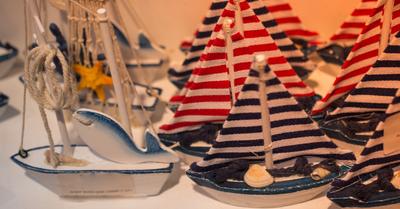
Best Small Sailboat Ornaments
September 12, 2023
Popular Posts

Best Liveaboard Catamaran Sailboats
December 28, 2023

Can a Novice Sail Around the World?
Elizabeth O'Malley
June 15, 2022

4 Best Electric Outboard Motors

How Long Did It Take The Vikings To Sail To England?

10 Best Sailboat Brands (And Why)
December 20, 2023

7 Best Places To Liveaboard A Sailboat

How Fast Do Catamarans Go? 5 Examples (With Pictures)
A catamaran is generally more balanced on the water and can be faster than a multi-hull vessel.
Unless you compare them to foiling monohulls like the new America’s Cup boats that sail at over 50 knots, they are not recreational vessels.
In this article, we will look at how fast each type of catamaran will go.
Table of Contents
Here are the numbers before we dive into the details:
| Sport Catamarans | 30 knots |
| Cruising Catamarans | 15 knots |
| Racing Catamarans | 45 knots |
| Power Cruising Catamarans | 70 knots |
| Swath Catamarans | 30 knots |
Average Speed For Sailing Catamarans
Catamarans can vary in size from 14 ft to over 100 ft. Catamarans can come in a wide variety of design types.
Sailing Catamarans have been attempting to make advancements over their mono-hulled counterparts.
These advancements include:
- Foils that assist with lifting the vessel out of the water.
- Stability advancements.
- Racers that can maintain their speed while out in the ocean.
3 Different Types of Sailing Catamarans:
1) sport catamarans.

One type of sailing catamaran is a sport catamaran, which is otherwise known as recreational. These are typically supposed to have a small crew and launch and land on beaches.
Sport catamarans do not normally have living quarters and are ideal for day trips. Resorts or other rental services often use these.
These can also be used for racing.
Sport vessels have been known to travel over 30 knots but can speed over 40 knots in the proper conditions.
2) Cruising Catamarans

Another type of sailing catamaran is a cruising catamaran. These often come with complete living accommodations, so they sacrifice speed over their sportier counterparts.
They can average between 9 and 10 knots, depending on the conditions. The top speed is typically around 15 knots.
It would be best if you were careful with catamarans that have living quarters. The more you weigh it down, the less speed you will have.
3) Racing Catamarans

The final type of sailing catamaran is an ocean racing catamaran.
These boats are large and can reach over 100 feet in length.
The top speed of this type of catamaran is around 45 knots.
Because of the prize money for entering these in races, much research goes into their advancement.
Average Speed Of Power Catamarans
Catamarans with power motors fill a different type of boating category.
These are commonly used when speed and smoothness are favored over space or capacity.
Because of their stability, catamarans are good vessels for combating seasickness as well as transportation. We have a separate article here with all you should know about catamarans and (how to overcome) seasickness .
On a commercial level, these can be used for ferries for both people and vehicles. They are used for short term travel, often to or from islands.
Like sailing catamarans, there are a few types of power catamarans.
1) Power Cruising Catamarans

Similar to sailing cruising catamarans, they also have power cruising catamarans. These also have living quarters and are stable while out on the water. The speed of these vessels highly depends on the motors equipped and the size of the boat itself.
Like passenger transport or ferries, catamarans have a high speed of about 40 to 70 miles per hour.
These are made to travel at great speeds to allow their commuters the shortest possible ride to their destination.
The military also utilizes power catamarans. They use power catamarans to transport military cargo. These ships are ideal because of their speed, holding capacity, and ability to venture into shallow ports.
2) Swath Catamarans

They also have small-waterplane-area twin-hull vessels. These are called SWATHs.
These differ from the average catamaran because they also have submarine-like hulls that stay completely under the water.
Due to the hulls being submerged, they are not normally affected by waves. These are used most often in the ocean as research vessels. They can also be used for certain types of yachts. Because of their stability, they are good vessels for furniture that will not require as much securing.
These often travel between 20 and 30 knots.
Some catamarans are designed for wave piercing. These are made to pierce through waves rather than sail over them, causing them to be faster. These can be used as passenger ferries, yachts, and military vessels as well.
3) Whitewater Catamarans

There are also recreational catamarans made for whitewater travel. These are sometimes called “cata-rafts.”
They are made using two inflatable hulls connected with a scaffold. These are lightweight and perfect for whitewater sports.
They are even able to be packed away in a backpack. They can take up to 20 minutes to assemble, including inflation.
They have high speeds on white water rivers and can be most compared to a canoe, kayak, whitewater raft, or other white water vessels.
Performance Characteristics Of Catamarans
Catamarans require four times the power to double their speed. A mono-hull vessel, however, would require eight times the power to double their speed.
This is because a Catamaran has less resistance in the water.
This is also good for conserving and using less energy.
Catamarans are also more stable in the water. This stability is effective at resisting heeling or capsizing. A multi-hull vessel would require four times the force to capsize as a similar-sized mono-hull vessel.
The general sailing in a catamaran is smoother and allows for activities that are not always possible on a mono-hull sailboat.
Are Catamarans Faster than Mono-Hull Vessels?
Because catamarans have less water resistance, they are generally faster than mono-hull vessels.
This is because their hulls are smaller, which means they have a smaller bow wave to fight.
A bow wave is a wave created by the displacement of water by the bow of a ship. After a certain speed, a boat has to start hauling itself over its own bow wave.
The larger hull a ship has, the larger its bow wave will be and the more power required to fight it.
Catamarans have two small and narrow hulls, so they do not have much of an issue with their bow wave. This is one reason they are usually faster than a similar-sized mono-hull vessel.
Catamarans can be between 20-30 percent faster than their monohull counterparts.
Issues with catamarans over mono-hulls are that they can take more time to turn.
How Is The Speed Measured?
Boats commonly measure speed using GPS tracking devices to measure distance traveled. Speed while sailing is measured in knots. A knot is one nautical mile per hour, which equals about 1.15 miles per hour.
How Fast Are Catamarans Compared To Other Boat Types?
- Sailing catamarans typically average about 10 knots.
- Pontoon boats average about 20 mph.
- A powerboat cruiser can average anywhere between 30 and 50 mph.
- Cigarette boats can even reach close to 90 mph in the proper conditions.
- Sailboats average between 6 and 12 mph depending on wind conditions. This includes mono-hull between 6 to 8 mph and catamarans and trimarans between 9 and 10mph
Two different factors can determine the speed of sailing ships:
1) The hull type as listed above.
Different hulls rest in the water more or less than other types. The less of the hull that is underwater, the faster it can go.
This is because the less of the hull in the water, the less drag created while sailing.
2) The length of the boat
The longer the boat, the faster it can go. Every boat has a maximum hull speed that cannot be exceeded unless the boat can plane on the water’s surface or be lifted on hydrofoils. For most boats, the longer the boat, the higher the maximum hull speed is.
Speed Vs. Comfort Considerations For Catamarans
If you are looking for a catamaran, you have a lot of options.
You can choose to prioritize speed or comfort.
After deciding to purchase a catamaran, the type of catamaran you should look at depends on where and what you are using it for.
You will want to make sure that you look at what type of water you will be traveling in, how many people you are traveling with on average, and what type of speed you hope to achieve.
One thing you will want to keep in mind before the purchase of a catamaran is storage. If you intend to store your boat in a marina, you are often charged for two slips due to the beam, or width, of a catamaran versus the standard mono-hull vessel.
Catamarans can be beneficial for those who get seasick because they offer a steadier ride and the ability to have more open air space. Because the living quarters are not inside the hull and under the water’s surface, you have more windows and visibility.
Both sailing and power catamarans are viable options. Also, sailing catamarans can come with back-up power engines for low winds or situations such as docking in a marina.
Catamarans that have twin engines can offer more control and precision than those on a mono-hull vessel. This is good for tight and busy areas or navigating marinas.
Overall, there are plenty of options for you, and they offer many benefits over their mono-hull counterparts.
Click to share...

The Cruising Catamaran Performance Debate
Which Cruising Catamaran Performs Better…And Does It Really Matter?
A client recently alerted us to a YouTube video posted by a catamaran dealer that is blatantly misleading and inaccurate. If you listen to this dealer, every catamaran manufacturer, other than the Fountaine Pajot brand, is slow, unsafe, not seaworthy and not fit to be a cruising catamaran.
While we agree that the Fountaine Pajot brand is an excellent product (we sell a lot of them), it certainly is not the ONLY good cruising catamaran in the world. There are many products available that are as good and like so many things, when it comes to choosing a cruising boat, it often boils down to personal preference, especially in this category of cruising catamaran.
2022 UPDATE: You will still find some great information below regarding cruising catamarans, especially if you are in the market to buy one. But lots has happened in the Performance Cruising Catamarans category since this post was written a few years ago, like Catana is back in the game with tons of innovation and a fresh new look. In addition to reading this article, be sure to read:
- 2022 Performance Cruising Catamaran Comparison
- We Bought a Performance Cruiser Catana OC 50
Cruising Catamarans Performance
The dealer in the video our client mentioned to us specifically focused on the superior performance of the Fountaine Pajot compared to some of the competing brands in the cruising category like Leopard Catamarans , Nautitech Catamarans , Bali Catamarans , Lagoon Catamarans , and Catana Catamarans .
The fact is that there is very little difference in speed between similarly lengthed cats in this category. All these catamarans are displacement hulls and they pretty much sail to hull speed with intermittent surfing. Therefore, when sailed efficiently, these cats should have very similar performance.
We hear terms such as power-to-weight ratio (sail area to displacement) bandied about a lot by yacht salespeople of the various boat brands as an indicator of performance. While this is definitely a factor and certainly has an effect on acceleration and light wind performance, it is not the only factor. Some catamaran brands will be faster around the cans in a regatta while others will be better when making long passages.
What one should also consider is that when cruising is that a catamaran’s performance will be dictated by sea state as well as wind speed and direction. In light winds, there will probably be a screecher or asymmetrical spinnaker deployed and in strong winds the sails will probably be reefed. This means that in cruising mode, most sail plans are optimized to the conditions. Therefore, when evaluating a cruising catamaran’s performance, there are many factors to be taken into consideration. This is not a simple cut-and-dried argument.
Catamaran Performance Factors & Calculations
To display the different factors and calculations which are relevant when it comes to catamaran performance, we went to Multihull Dynamics for data and pulled some numbers on the two boats most mentioned in this dealer’s video, namely Lagoon and Fountaine Pajot. Here is what we found on the Multihull Dynamics site:
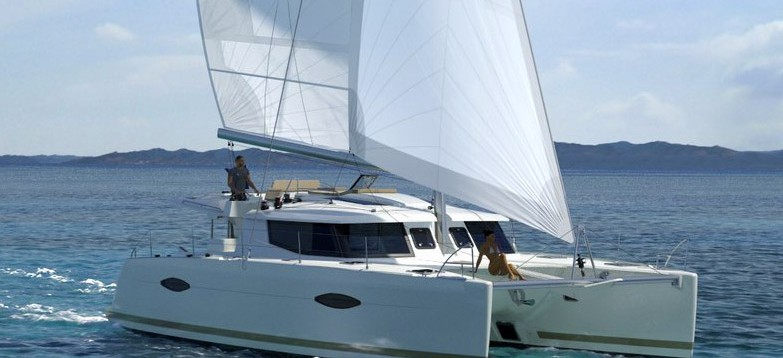
- Base Speed – An empirically derived indicator of the speed a given boat could average over a 24-hour period (best days run) under a variety of conditions. Here again the Lagoon had better numbers with 9.82 knots versus 9.46 knots for the FP Helia 44 – this explains why the Lagoons are so successful on the long Ocean races like the ARC
- KSP – Kelsail Sailing Performance number is a measure of relative speed potential of a boat. It takes into consideration Sail area, Displacement and length at Waterline. The higher the number the higher the speed predicted for the boat. Here the FP Helia 44 at 6.06 had better numbers than the Lagoon 450 which comes in at 6.02 – the Helia is the lighter boat.
- TR – Texel Rating provides a handicap system for widely varying boats sailing together in a race. The formula is essentially the inverse of the Base Speed formula with constants applied to make the results useful. The Texel rating system permits the calculation of time to sail a given distance. Thus a boat with a higher TR can be expected to take longer from start to finish than a boat with a lower TR. The Lagoon 450 came in at 141 versus the FP Helia 44 at 144.
- Interestingly the Leopard 45 came in with better numbers than the Lagoon and the FP as follows: Bruce number – 1.25; Base Speed 10.65; KSP 7.68 and TR 122.
- The numbers for Antares PDQ44 are very similar to the Helia 44 and Lagoon 450.
- Unfortunately there was no data available for the Bali or current Nautitech designs.
*Disclaimer: All data quoted here was derived from Multihull Dynamics. Catamaran Guru offers the details in good faith and does not guarantee or warrant this data.
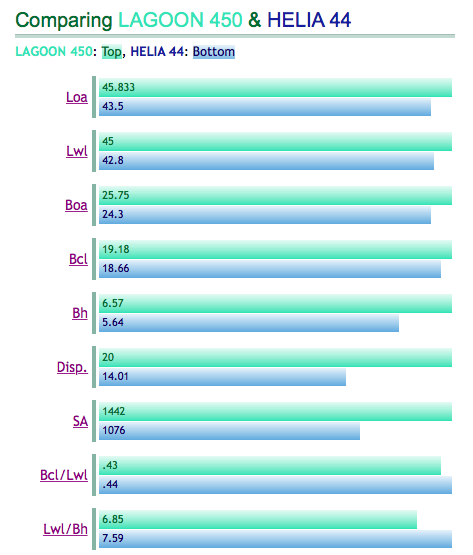
>>Click on the pictures above or go to Multihull Dynamics website for a full explanation of the graphs.
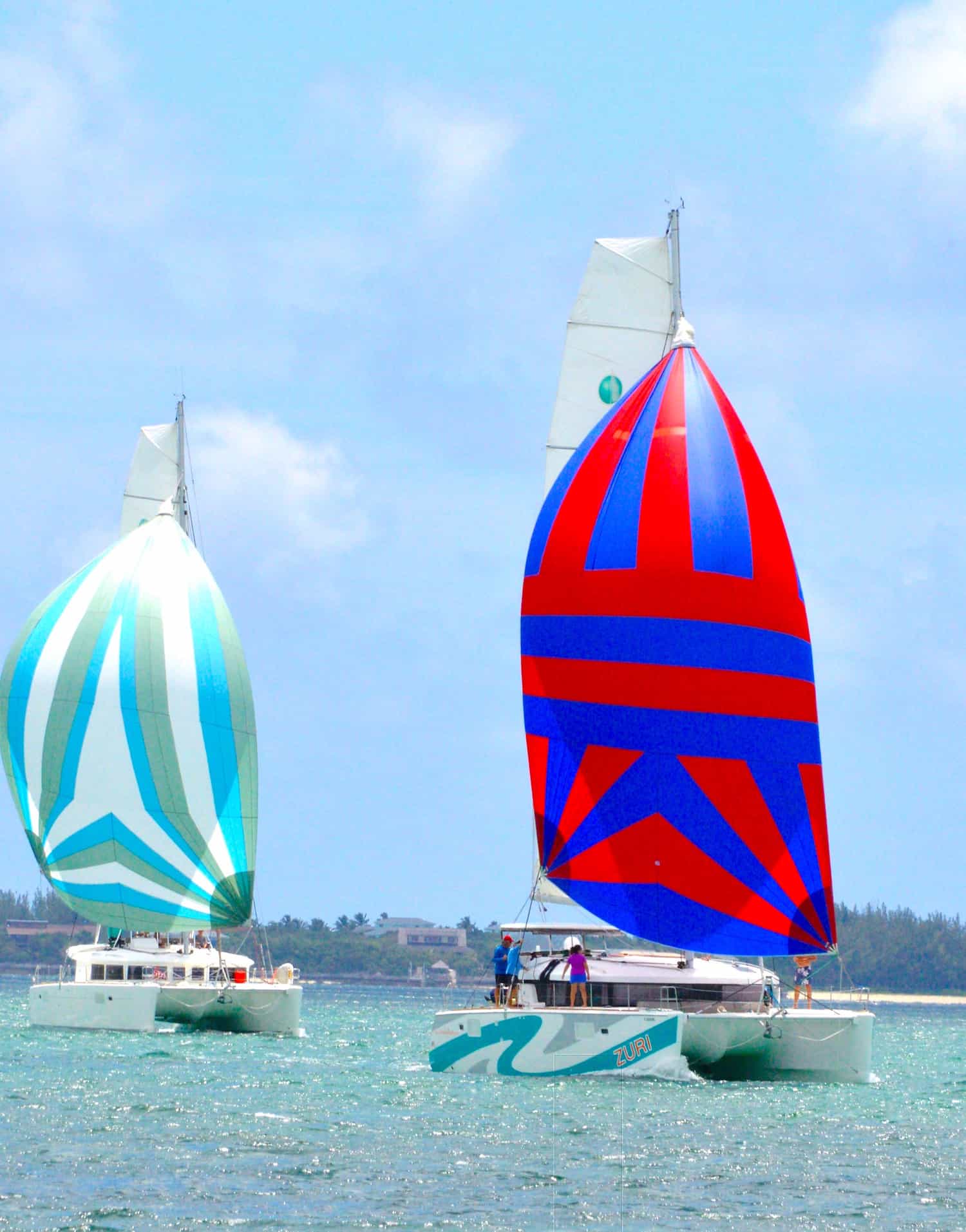
While the Fountaine Pajot dealer touts the superior performance of their brand, actual data shows that the Lagoon brand has won more ARC cruising rallies than any other brand of cruising catamaran. These are hardly the statistics of “just a charter catamaran that sails in 50-mile circles and lacks performance”, as is claimed by this dealer. As an example, check out these ARC and ARC+ rally results in which Lagoon consistently features well:
- Spirit, Lagoon 450 Flybridge – 1st Multihull
- Cat’Leya, Lagoon 52 Sportop – 2nd Multihull
- Sea to Sky, Lagoon 450 – 3rd Multihull
- Dreamcatcher, Lagoon 52 – 4th Multihull
- Sumore, Lagoon 570 – 5th Multihull
- Opptur, Lagoon 500 – 6th Multihull
- Lea, Lagoon 52 – 10th Multihull
- 2015: 380 Havhunden, first in ARC+ Multihulls Division in corrected time
- 2013: 620 Enigma, first in ARC+ Multihulls Division in corrected time
- 2012: 560 Feliz, first in ARC Multihulls Division in real time
- 2011: 560 Blue Ocean, first in ARC Multihulls Division in corrected time & third in ARC Multihulls Division in real time
- 2010: 620 Lady Boubou, first in ARC Multihulls Division & 11th overall in real time
This is NOT an indication of how good or bad one boat over another is, but rather an indication of dealer bias ! We are sure this debate will continue but it is our considered opinion that one should look at the overall boat and not be blinded by issues that might or might not be manufactured by over-zealous sales people. As we have said before, it often comes down to personal preference.
Performance Cruising Catamarans
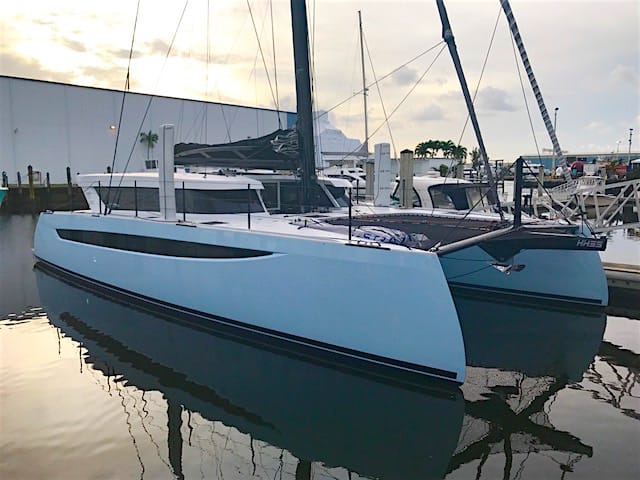
High-performance cruising cats are becoming more popular and there are a lot more on the market than even just five years ago, but it’s not for everyone, especially if you are not a skilled sailor. Daggerboards and bigger rigs require more skill and are not for the average sailor.
We’ve been racing on and off for years on different catamarans and we’ve always had great fun sailing and surfing at speeds of 15+ knots. But as fun as that is, it can be a white knuckled, wild ride in bad conditions and can leave the crew tired and tense because one has to really pay attention. At these speeds any mistake could be catastrophic since there is so much load on the rig. So, make no mistake, sailing fast in less than good conditions is hard work, particularly when you sail shorthanded.
When only the two of us cruise along on our own boat, we really appreciate the pleasure of gliding through the water at 8-10 knots, relaxed and comfortable. Would we love to be able to coast along at a good clip in very light winds? Sure, we would love to own an Outremer or Catana! But that type of performance cat will cost us probably twice the price of a regular cruising catamaran. Is it worth the money for the average cruiser? Debatable.
With the advancement of technology, more people will eventually be able to sail these performance cats skillfully and will be able to afford them as costs come down but until such time, we believe that the average sailor can very happily sail at fair speed toward their destination, safely and relaxed on an average cruising catamaran as discussed above. The fact is, one or two knots of speed, which is what the difference between these cruising cats MIGHT be, will not make or break your passage.
2020 Update: At the time of writing this article, we owned a Lagoon 450 SporTop , not a rocket ship by any means, but a fair sailing boat. We now own a Bali 5.4 catamaran that is significantly lighter and faster in general as a cruising catamaran and we love the extra speed. However, I have to say that this boat is less comfortable underway than the heavier Lagoon. It is more buoyant, a little more skittish and tend to surf much quicker. So one has to pay more attention in more vigorous conditions. It can be tiring on a long passage, but it sure is fun!
Stephen says, “I personally like the Bali because it is a more lively boat and sails very well – when we picked our boat up in France it was completely empty and bobbed like a cork which we were not used to because our Lagoon was a much heavier boat. Since we have now equipped her with all the world cruising equipment as well as big dinghy, etc. she is a little heavier and a lot more comfortable. It is a fact that weight affects performance – the lighter the boat the better performance one can expect. We flew across the Atlantic when we were nice and light but the boat still performs well now that she is at full cruising weight”.
The Bottom Line
So, to conclude this argument, dealers are always somewhat biased about the products that they represent. Manufacturers go to great lengths and spend a lot of money training their dealer networks to be knowledgeable about their products and represent them well with the buying public. They rightfully expect loyalty from their dealers and expect them to present a positive image to the consumer. We all get that. However, when dealers trash and misrepresent their competition with manufactured issues in order to sell their own products, they do a disservice to the buying public and the industry in general.
We want to hear what you have to say! Tell us about performance on your cruising catamaran and also check out our article on why we chose our own catamaran .
Reminder! Check out these fresh updates on performance catamarans:
Contact us if you have any questions regarding catamarans, Fractional Yacht Ownership or our Charter Management Programs .
Estelle Cockcroft
Join our community.
Get the latest on catamaran news, sailing events, buying and selling tips, community happenings, webinars & seminars, and much more!
13 thoughts on “The Cruising Catamaran Performance Debate”
Thanks for a sober writing. I am the owner of the Lagoon 380 Hahunden, and agter with you. I have a spreadsheet with 75 different cruising cat models and the elapsed times in 29 races, and there is not much difference in perforfance. Can send it if uou want. Greetings.
I would like to see that spreadsheet for sure!
I own a Venezia 42′ and if my boat is part of your spreadsheet I would especially love to see it! Could you please send me a copy even if it’s not on there?
To discuss performance and Lagoon or FP in the same sentence is crass. These are not performance Catamarans, purely floating caravans. They have no pretence to performance only cruising capacity, any indicator of performance is purely coincidental.
I own a Privilege 495 and wouldn’t trade it for any other cat.
Hi Jack, I am interested in the performance of your boat. I understand that mini keels decrease performance considerably. Thanks Di
I would like to point out that the data that you use from Multihull Dynamics is completely flawed due to an inaccurate displacement value. Multihull Dynamcis inexplicably lists the Helia at 14 tons, while Fountaine Pajot and your site list the boat at 10.8 tons. This is quite a big difference and skews all the metrics calculated by the site. The Helia is obviously a lighter boat and performance in catamarans starts with weight, so it is undoubted that the Helia will be more lively than the Lagoon. I totally get your point that that does not mean that it will be more comfortable. Second, on the ARC data front: my father sailed twice across the same route in the Atlantic in the last 10 years and I’m very familiar with the conditions. The trade winds there tend to be rather lively and in those conditions weight will matter less. I would expect to see different results in lighter conditions. All that said, the dealer in question is undoubtedly doing their marketing with an agenda.
Hi Ivan, thanks for your input regarding the Helia 44 weight discrepancy. We are aware of this and it holds good for both vessels. You will note that the Helia 44 shows a displacement UNLOADED of 10.8T while the Lagoon 450 shows an UNLOADED displacement of 15T. In order to get accurate performance numbers we assume that Multihull Dynamics have used a number that represents the LOADED weight of both vessels. This means that for the Helia 44 it went from 10.8T to 14.1T (an increase of 3.3T) and in the case of the Lagoon 450, it went from 15T to 20T (an increase of 5T), since it a larger boat overall with more capacity. Based on the above I think we can safely say that we are looking at a fair and accurate comparison. Your input is really appreciated and we are always open to comment and correction to ensure the information we put on the site is accurate and fair.
Thank you for the clarification on displacement.I do see that they have bumped up the Lagoon 450 displacement as well so that’s a fair comparison. I wish they published that clearly because it changes numbers quite a bit as all manufacturers typically post the weight of their boats unloaded.It looks like the Lagoon makes up for the greater weight with a bigger sail area, so that will probably add up to greater effort needed to manage those larger sails but with modern systems, all these things can be managed. Thank you for the clarification and your insight overall.
I think the misconception people have about “performance” catamarans, is that the reason sailors gravitate towards them is not their speed, it is their ability to sail in light air. If you have a catamaran that will sail at windspeed or close to it in 5-8 knots, you’ll actually sail instead of cranking up the diesel. Those true performance catamarans capable of this that also have all the creature comforts of the Helia/Elba45 or Lagoon450/46, are 50+ feet long, and twice the price unfortunately.
You are so right! Well said.
Good article! For me, the weight includes all the stuff you are taking on a month long (or longer) journey (Full fuel +extra cans, 2 sups, dive tanks and compressor, 4 cases of wine…). My opinion is that the performance cats hull design suffers more when loaded to the gills. Ride quality is also very important and is often glossed over by the performance cat advocates.
You are completely right and that was part of strategy when we raced across the Atlantic with the ARC rally. We knew that all the cats would be loaded to the max for the crossing which no doubt makes them less efficient sailing cats. Fortunately on the Bali 5.4 the buoyancy calculations is for a fully spec’d and loaded boat. So we left and sailed like a bat out of hell right off the bat and we were sailing very efficiently, making 200+ NM distances every day. We figured that as the other cats start using their fuel, water and supplies, they would sail a little more efficiently but by then we would be well ahead of the pack, and it worked. We surprised even the very fast performance cats and all the while eight of us onboard were sailing in complete comfort and were eating gourmet meals three times a day! LOL- Of course the TS’s beat us but it is hardly a fair fight. LOL
Leave a Comment Cancel Reply
Your email address will not be published. Required fields are marked *
Save my name, email, and website in this browser for the next time I comment.
Recent Posts
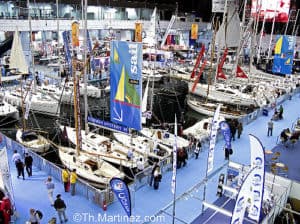
How To Make The Best Use Of Your Time At A Boat Show
Boat shows are exciting, offering a unique chance to view a vast array of

Top 5 Reasons to Choose Catamaran Guru
When it comes to making your dream of yacht ownership a reality, Catamaran Guru

Top 10 Reasons to Sell (and Sail) Your Catamaran in Annapolis, MD
We have a new home in Annapolis! The office is located in Annapolis, Maryland

Top 10 Reasons to Sell (and Sail) Your Catamaran in Texas
Our Texas Office is located in the Watergate Marina Center in Clear Lake Shores,

For more than 30 years, we have been a part of the catamaran community and created Catamaran Guru™ to encourage and educate all the aspiring sailing out there. We understand the dream of traveling the world by catamaran and created a one-stop-shop to make that dream a reality for you.

- Stephen & Estelle
- Testimonials
Get Started
- Yacht Sales
- Used Yachts
- Charter Management
- Boat as Business Programs
- Seminars & Events
- Yachting for beginners
- Owning a yacht
- Motor Yachts
- Sailing Yacht
- Indian Ocean
- Mediterranean
- Buying or Selling a Yacht
- Yachting Events
- FAQ – Luxury Yacht Charter
- FAQ – Buying a Yacht
- FAQ – Sell your Yacht
- How Much Does It Cost To Charter A Luxury Yacht?
- All our Blog Post & News

What are the Fastest Cruising Catamaran on the Market?
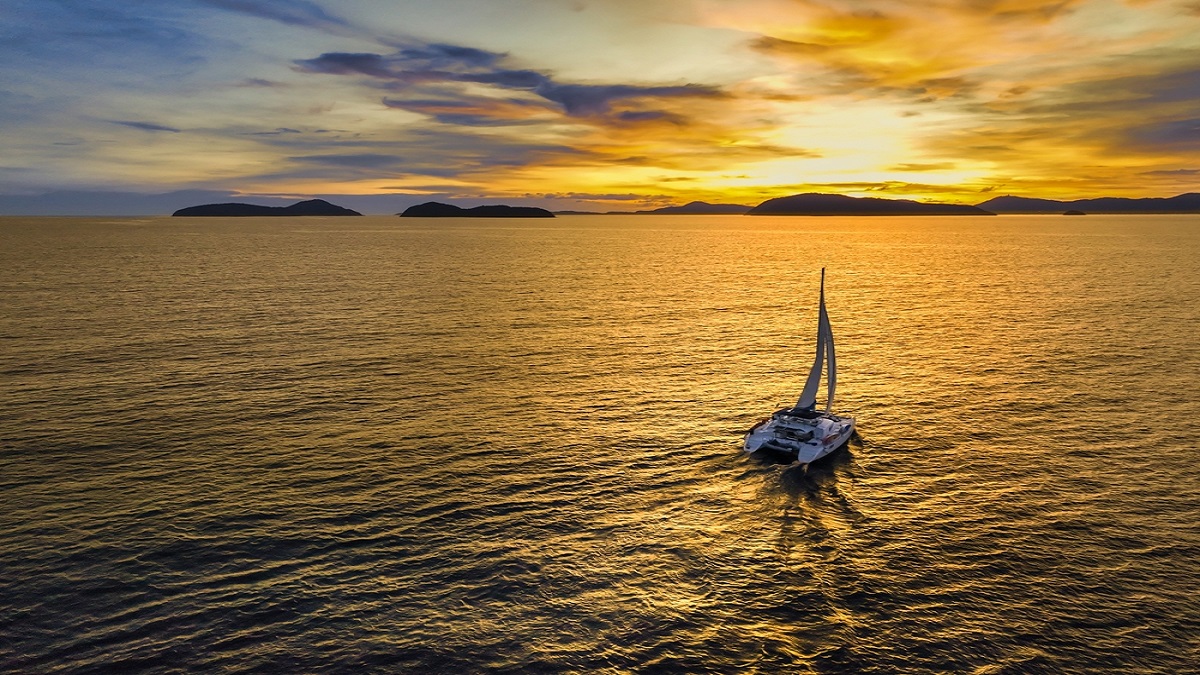
For those who love the thrill of the open sea, speed is an essential element of their sailing experience. For years, catamarans have been a top choice for sailors who want to explore while enjoying the benefits of speed, comfort , and luxury. In recent years, the trend towards high-end fast catamarans has exploded. If you are looking for speed combined with affordable luxury, look no further than the fastest catamarans on the market.
How fast can cruising catamarans usually go?
Cruising catamarans can reach speeds that can exceed their respective theoretical hull speed thanks to their light weight, generous amounts of sail area, and minimized wetted surface area. It is not uncommon for them to reach sailing speeds of 30 knots or more. They can also offer better stability than a monohull, making them an ideal choice for long ocean passages.
What Makes the Fastest Catamarans on the Market more Rapid Than the Others?
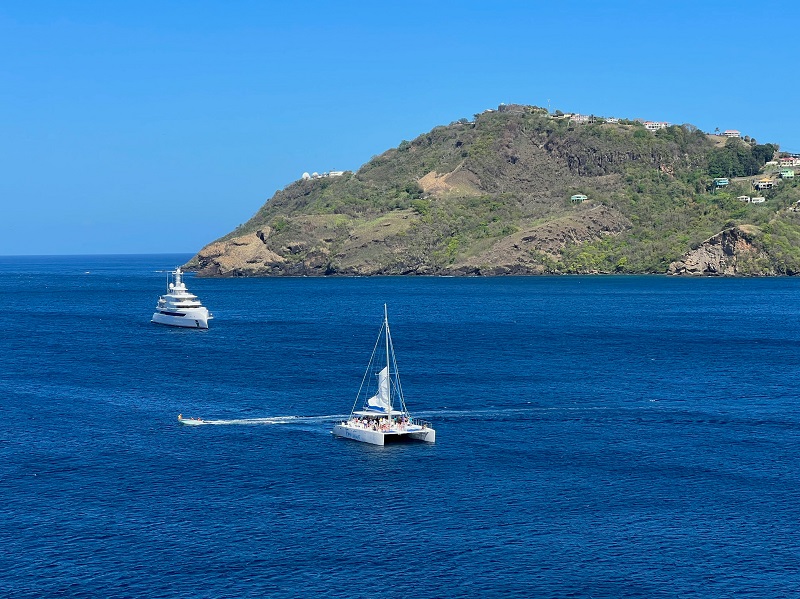
When it comes to catamarans, Gunboat is a brand that stands out from the crowd. Known for their exceptional quality, performance, and luxurious design, Gunboat delivers a unique sailing experience that has captivated the attention of sailors around the world. Their latest offerings – the Gunboat 68, 72V, and 80 – are perfect examples of the brand’s commitment to delivering top-of-the-line sailing yachts that offer the best of both worlds: the performances of a racer in a luxury cruiser catamaran.
The Gunboat 68 is a spacious and comfortable yacht that boasts an internal helm station and sophisticated lounging areas. With room for up to six cabins, including a spacious master, and a forward cockpit, the Gunboat 68 offers everything that sailors could ask for in a luxury catamaran. But don’t be fooled by its luxurious design – the Gunboat 68 also offers exceptional performance, making it a true racer’s yacht.
The Gunboat 80 takes everything that sailors loved about the Gunboat 68 and ramps it up to the next level, with even more space and more advanced features. Designed for sailors who demand the very best, the Gunboat 80 offers a cruising experience like no other. And as with all Gunboat yachts, performance is at the forefront of its design. Expect nothing less than exceptional sailing speeds and adrenaline-pumping races.
But perhaps the most exciting development in the Gunboat lineup is the new 72V. This unique yacht is a bit of a gamble for the brand as it features a flybridge. But don’t think that this will make it any less of a racer – the 72V is designed to be streamlined compared to traditional production catamarans, and it still offers exceptional speed and performance. And with a flybridge helm station, sailors can look forward to even more control and a truly immersive sailing experience.
“Cruisers do not understand the massive difference between a racer and cruiser, with tremendous emphasis on weight and performance.” Gunboat understands that difference all too well, and their commitment to pushing the limits of what is possible with luxury cruiser catamarans is what sets them apart. Gunboat is leading the way in the world of high-performance luxury sailing, and they show no signs of slowing down any time soon.
Read also: INTRODUCING THE NEW GUNBOAT 72V “WONDERFUL”: THE ULTIMATE FLYBRIDGE CATAMARAN
HH Catamarans
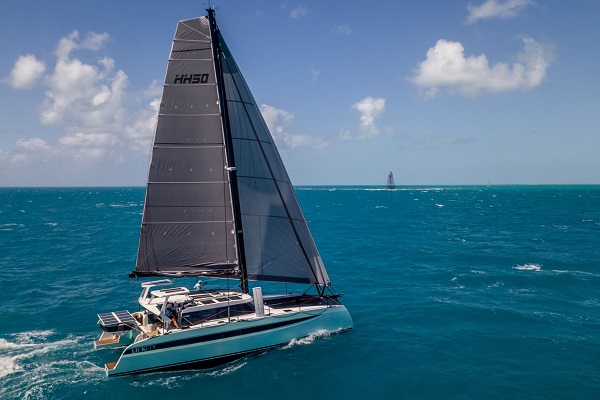
HH Catamarans may be a relatively new player in the world of high-performance cruising yachts, but they have quickly risen to become one of the most respected names in the industry. Built in Xiamen, China, by the same contractor that once had built Gunboats, HH Catamarans are designed to offer an unparalleled level of luxury combined with the ultimate sailing performance.
When HH Catamarans emerged in the market a decade ago, they had to make a crucial decision about what kind of boat they wanted to create. Ultimately, they decided to prioritize speed and performance over everything else, a decision that has drawn praise from seasoned sailors. Their boats range from 44ft to 88ft in length, all featuring exceptional craftsmanship and engineering.
One of the crucial features on HH Catamarans is their hydraulics and smart deck planning. Combined with their captive winches, these features allow sailors to get the boat off the mooring, sails up, and cruising at speeds up to 20 knots in just four minutes. This level of speed and agility is unparalleled in the world of cruising catamarans.
In addition to their performance and speed, HH Catamarans boast quality construction that makes them the strongest yachts possible without adding significant weight. Carbon and epoxy are used to create the strongest possible hull, while all lines run under-deck to create an uncluttered walkway. The stanchions are also a generous 900mm tall, providing necessary safety when sailing with friends and family. The continuous, unbroken toe rail runs the length of the deck, enhancing the boat’s aesthetics while keeping the structure stable.
Overall, HH Catamarans has carved out its niche in the ultra-luxury sailing market, offering high-performance cruising catamarans that deliver both speed and comfort in equal measure. Every detail has been carefully thought out, from the construction of the hull to the onboard technology and smart deck planning, delivering an unparalleled sailing experience for those who want to push their yachts to the limit.
The Kinetics Catamaran’s Unmatched Velocity and Beyond
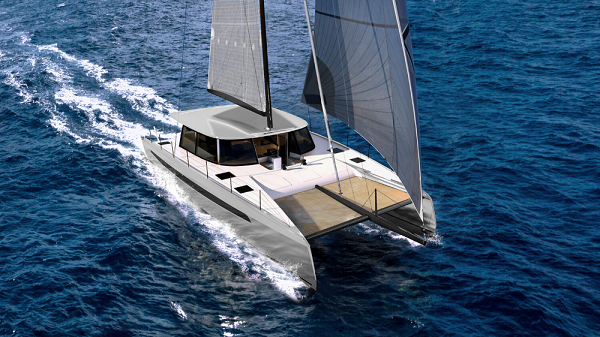
Founded in 2018, Kinetic Catamarans is a US company based in Knysna, South Africa. Their team consists of Bob Hayward, a successful US real estate developer, co-founder of Summit Entertainment, and farmer, and Leon Scheepers, a highly respected South African boatbuilder with extensive expertise in multihull production. Both share a deep love for sailing and a strong commitment to improving the boating industry.
Their main goal is to build luxury performance cruising catamarans of the highest caliber. In 2021, they proudly achieved this goal when the KC54 received prestigious accolades shortly after its launch. The Cruising World Magazine awarded it the Boat of the Year in the Judges Special Recognition category, and it was also named the Best Large Multihull (50ft and above) by SAIL Magazine.
Nevertheless, Kinetic Catamarans has been making waves in the boating industry with their luxury performance cruising catamarans, and their latest model, the KC62 , takes their offerings to a whole new level. This vessel boasts unmatched velocity and beyond and is a testament to the dedication and expertise of the Kinetic team.
One of the standout features of the KC62 is its lightweight design. The use of chemically-strengthened glass for the 360° windows, combined with other weight-saving measures, has resulted in a vessel that is both faster and more fuel-efficient than other catamarans in its class. In fact, the KC62 has been clocked at speeds of up to 30 knots!
But this vessel isn’t just about speed. It also offers unmatched comfort and luxury for its passengers. The spacious double cabins are outfitted with abundant clothing storage and en-suite bathrooms, while the saloons provide a cozy space for relaxing and socializing. The use of designer tables and stools and the latest appliances adds a touch of elegance to an already luxurious experience.
While the KC62 shares many of the features of other Kinetic catamarans, it also has its own unique touches that set it apart. For example, the vessel has two helm stations on each quarter and another one inside, as well as a forward cockpit that doubles as a leisure zone. This forward cockpit provides a cool and breezy spot for passengers to relax and take in the stunning scenery.
All of Kinetic’s vessels are designed by the highly experienced and innovative Simonis Voogd Design BV, and the KC62 is no exception. This vessel is a testament to the collaborative effort of a team dedicated to creating the highest quality, most luxurious catamarans on the water today.
Conclusion:
The market for fast cruiser catamarans is growing, with more brands and models being developed each year. These catamarans offer high performance, stability, and luxury, making them an ideal choice for adventurous sailors who want to explore the world in style. While the fastest catamarans on the market may come with a hefty price tag, the experience of sailing on one of these vessels is second to none. With their impressive speeds and luxurious amenities, it is no surprise that more and more sailors are turning to fast cruiser catamarans for their next adventure on the water.
Read also: 9 catamarans for sale under 5 millions
Predator 84 for charter: a Review of the Must Try “Alvium”
Where can you sail in march, you might also like.
How Donald Trump Owned the Iconic Kingdom 5KR Yacht: A Fascinating History Before Its October 2024 Accident
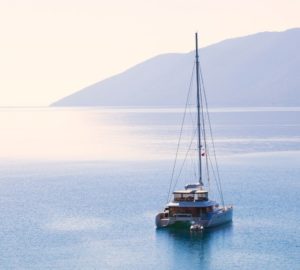
Power or Sail Catamaran – What’s Right for You?
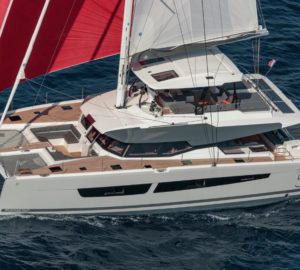
OKINAWA: Hosting 10 Guests with Premium Crew Service in the Caribbean

Catamaran cruising: everything you really need to know
Republished from Yachting World Expert skipper Nikki Henderson reveals what you really need to know before going bluewater catamaran cruising
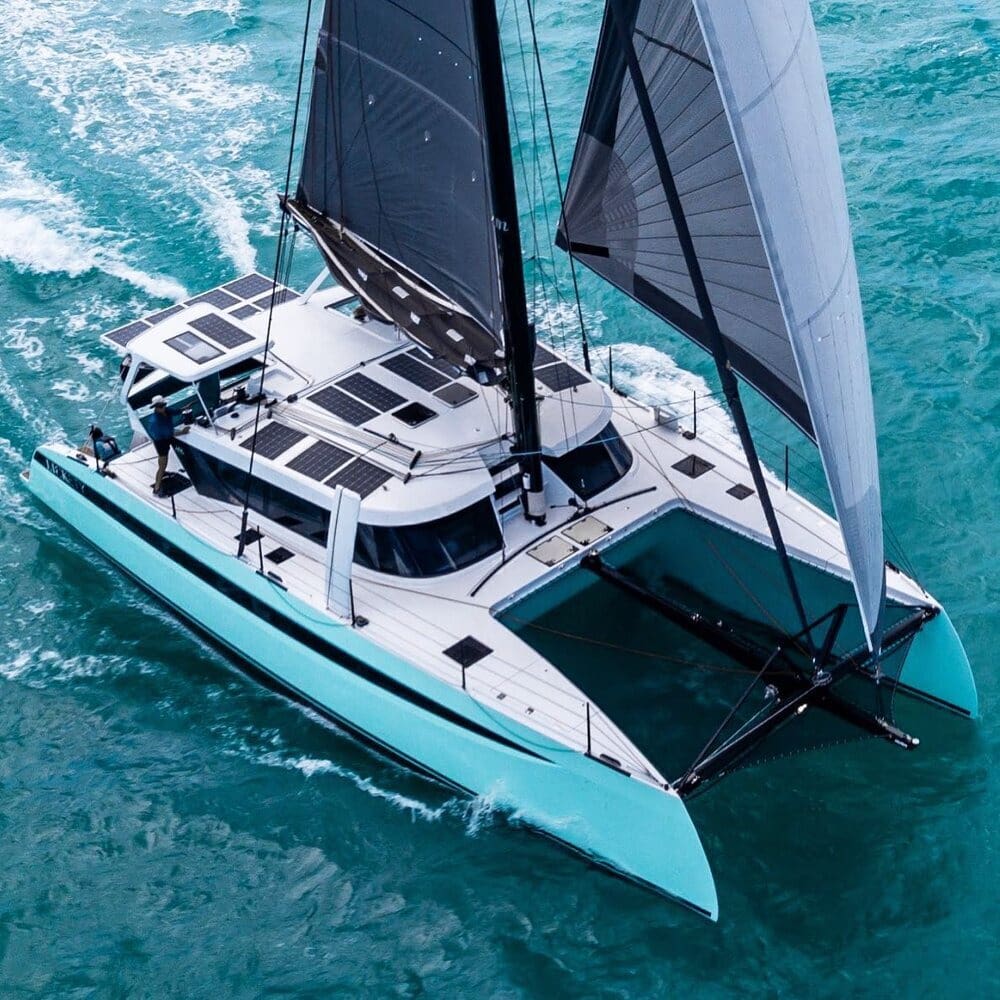
It has become routine now for me to bookend the summer sailing season with a trip to the south of France for the biannual ‘Outremer Week’. This hugely popular event gathers 100-plus new Outremer catamaran owners for five days of training, both in the classroom and on the water, and three days of friendly racing. The goal is to educate future owners so they are as prepared as they possibly can be for their upcoming bluewater catamaran cruising plans.
It’s an intensive week of 12-hour days, with a lot of information to absorb. Unsurprisingly there are some discussions specific to bluewater catamaran cruising that come up repeatedly, and they apply to owners or prospective owners of all brands of a bluewater multihull. Here are some of the most common questions people ask me:
What sails should I buy for a cruising catamaran?
Every day after sailing a new catamaran owner will come up to me and say, “Nikki, I’d love to take up some of your time and rack your brains about sail selection .” To pitch my advice appropriately, I always ask some key questions about your catamaran cruising plans, and I’d encourage you to ask yourself the same.
What is your route plan?
Tradewind sailing will be predominantly downwind. So, focus your attention on downwind sails. A route involving more upwind requires more focus on headsails. Routes involving more upwind tend to be more coastal routes or schedules with strict timings that will reduce the option to wait for downwind weather windows. All bluewater sail plans will need storm options. Three reef points in the main is a must, or at the very least an extremely generous second reef. A storm headsail is another key component. Ideally, it should be possible to hoist the storm jib up over the top of your furled foresail. In very big conditions, reliance on the thin furling line gets quite nerve-racking.
How performance-orientated are you?
Performance catamarans are designed to sail angles downwind, ideally with an asymmetric spinnaker wardrobe. However, there is a cost to the incredible speeds that you can attain reaching on these boats: comfort. So, a key question is what is your attitude to speed versus comfort? Performance-focused sailors are typically racing sailors, sailors without kids, or sailors who are in good physical shape. If you fit this category, then I’d advise purchasing one heavy-weather flat-cut asymmetric sail that can withstand a squall up to 40 knots, and a rounder, lightweight sail that you can sail quite deeply in light to moderate conditions.
If you don’t have a taste or attention span for speed, then one heavy weather symmetric spinnaker (approximately up to 40 knots TWS) should be enough. This will allow you to sail a rhumbline course, and make night-time take-downs less of a worry because the kite will survive a squall. For upwind, if you will enjoy fine-tuning your boat to get that extra half a knot, your ideal option is a large genoa for drive in light to moderate conditions, and a small flat blade-shaped jib for heavier conditions – small enough that it does not need to be furled to an inch of its life to cope with a Force 6. If an inner forestay is an option, the latter could be a staysail which will keep the centre of effort low and reduce sideways drift. For anyone less performance orientated in their catamaran cruising, the key for upwind sailing is a strong, flat jib that is not too big. Mark three reef points on the foot with sail tape. Keep an eye on how much it stretches and don’t be surprised if you need to change it every few years to avoid losing 5-10° of height. Downwind the trade wind route logic applies: performance sailors should invest in asymmetric and non-performance sailors in symmetric spinnakers.
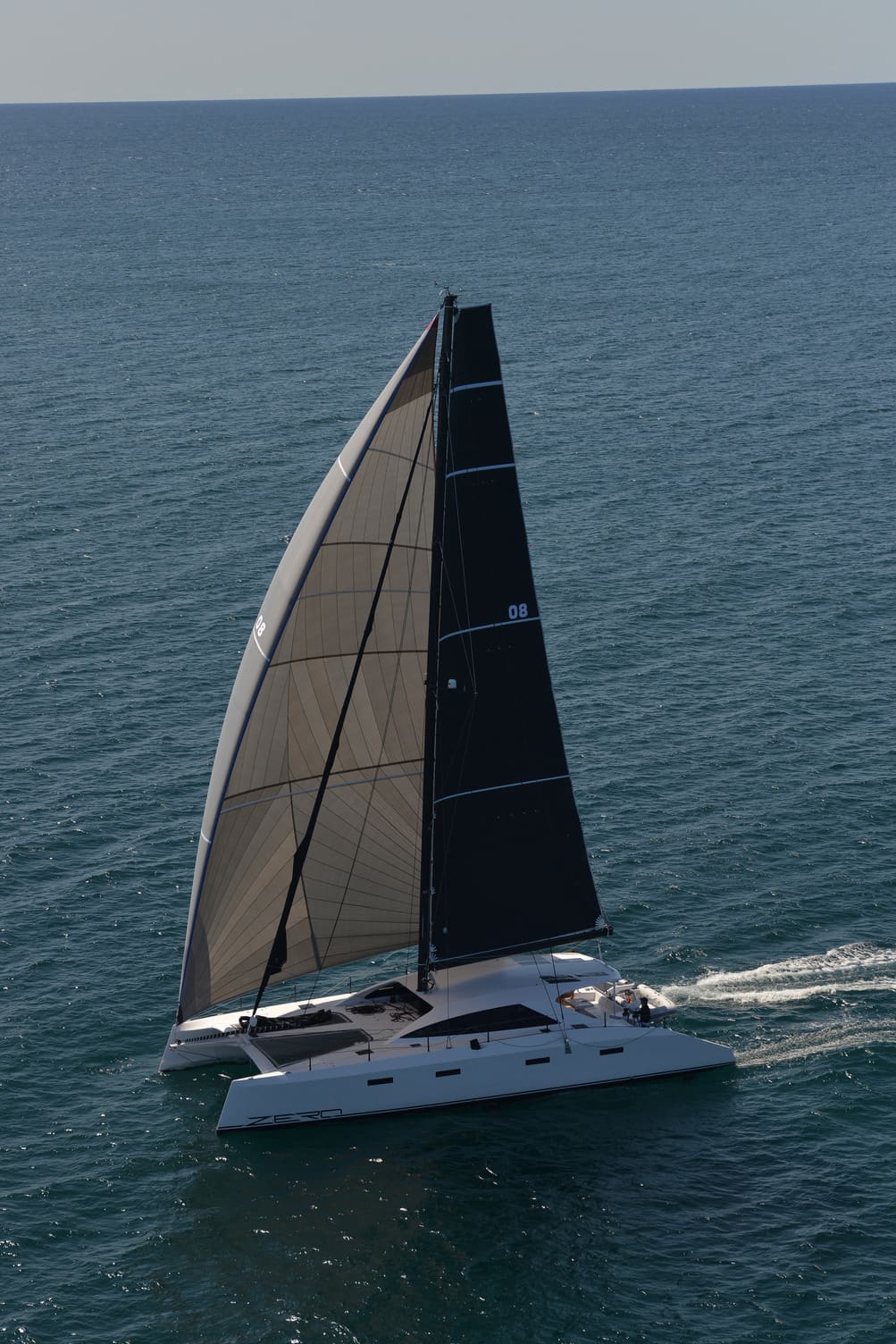
Who’s the crew?
At this point, the conversation often goes full circle. Sailors get enthusiastic about performance, and then remember that the kids will need home schooling, or that this is a retirement plan with potential health and fitness considerations. Most sail changes will require more than one person, and conditions at the bow can be bouncy. The crew also have to be able to sleep, cook, and live on the boat while it is thrown about. If you are short-handed, you could compromise for downwind sailing by choosing furling sails. A furling asymmetric such as a Code D can replace the ‘hoist and drop’ asymmetric. Or you can make the sock line on a symmetric long enough to route back to an electric winch. Upwind sailors could compromise by returning to a single jib and consider altering routing to sail slightly off the wind but faster; optimising for VMG. If you have a staysail, ensure it could be furled and therefore left rigged at sea – though make time to speak to the yacht designer about the impact on stability that having two heavy furled sails up continuously could have on the boat.
How ‘eco’ and time-conscious will you be?
Do you care about motoring? Increasingly for many of us, awareness of climate change is a strong motivator to avoid using the engine. And will you be more focused on the destination or more interested in the journey? If you are keen to avoid motoring, and you are free of time constraints such as fixed crew changeovers or grumpy children who need to stop and swim, then I’d recommend you invest in a Code 0. A Code 0 can double or even triple the boat speed: in 6 knots of wind, an Outremer will sail at 2-3 knots with a jib, but 5-6 knots with a Code 0. It’s a great sail and worth the investment, but first work out if you will use it. They often have low wind limits – around 15 AWS – which upwind could be 10 knots TWS.
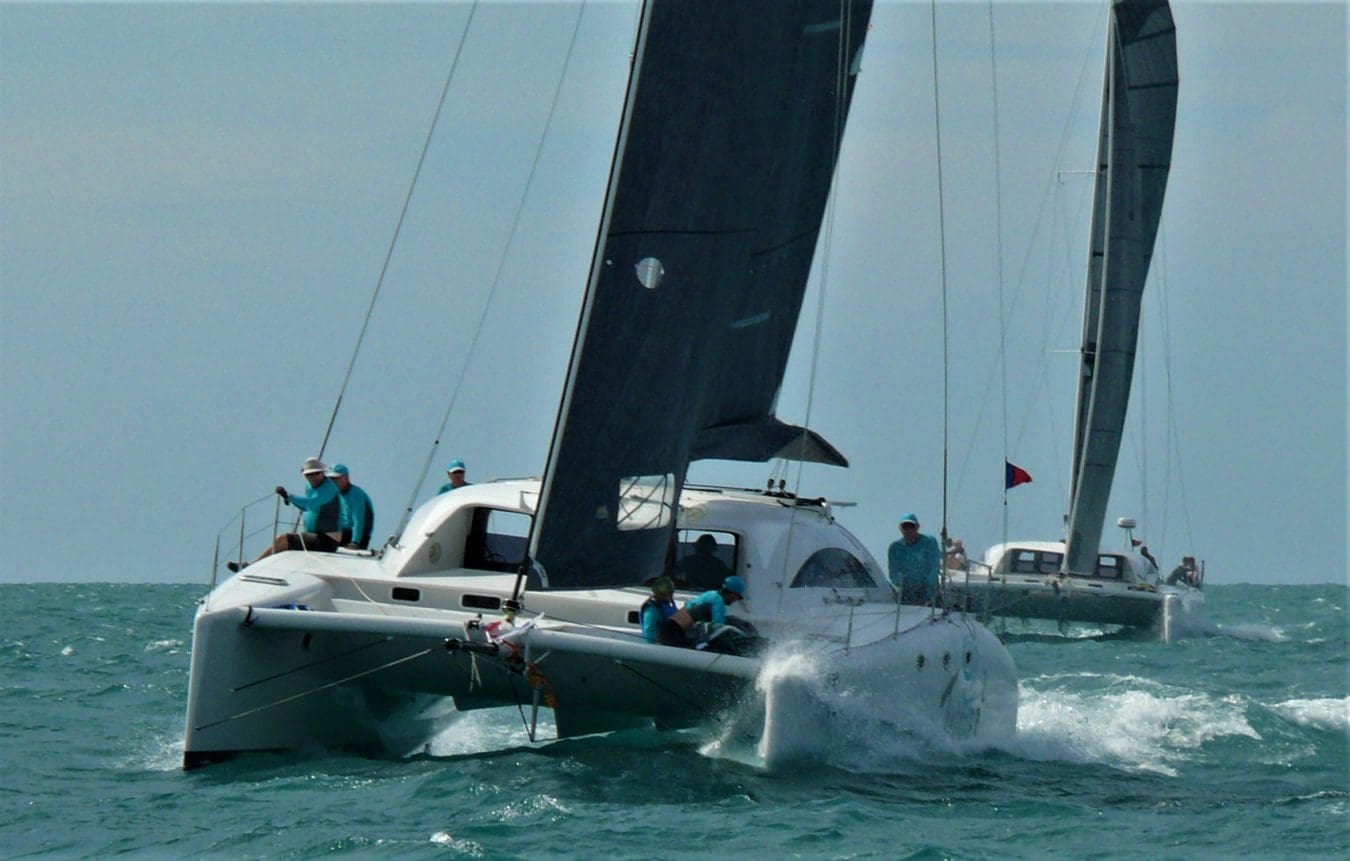
When do you reef a catamaran?
Many bluewater cruisers will reef down before dark every night. I’m not a huge fan of this as a rule; reefing should be straightforward enough to not be an intimidating manoeuvre in the dark. But all new catamaran owners who are planning to go bluewater cruising are concerned about knowing when to reef, especially if they come from monohull sailing, as a catamaran communicates whether it is overpowered or not in a much more subtle way. You want to conserve your equipment while sailing the boat effectively. So aim for the least amount of sail necessary to achieve your target speeds and angles. The best way to get to know this is to put reefs earlier or later each time and take note of whether it was beneficial or not. Over time you will know your boat very well.
Sailing favours guidelines over hard rules, but it’s good to have a starting point so here are some general ranges. For more cautious sailors or bigger sea states, use the more conservative side of the wind range: -Reef 1 in at 15-20 knots TWS -Reef 2 in at 20-25 knots TWS -Reef 3 in at 25-30 knots TWS Note that I am using true wind and not apparent. When sailing downwind it’s tempting to fly more sail because the apparent wind is so low. However, if you need to turn upwind – perhaps to reef – the 12 knots AWS in 20 knots TWS will quickly become closer to 25 knots AWS.
Reliance on numbers is great until the wind instruments stop working (it will happen at some point). Remember your RYA Competent Crew course and use the descriptions of the sea surface at various Beaufort Scale forces to identify how windy it is.
There are other telltale signs that the boat gives if she needs a reef. Although hulls don’t fly unless you are at the performance level of a Gunboat or similar, you may feel the windward hull just slightly lifting. This is a sign that a reef might be needed. Another is if the bows are diving down when you are sailing downwind. Heel angle can be most obviously sensed while lying down.
The main hindrance to learning when to reef – and when not – is a hesitation to perform the manoeuvre. If taking a reef feels arduous, people avoid it. I admit I can find myself in this camp: I have to remind myself that it’s a win/win, either it’s the right decision and the boat sails better, or it’s wrong and I’ve learnt from it.
The key to reefing is to practice. Taking a reef should be possible to do in under two minutes, especially if you have fast electric winches.
It’s handy to have the option to reef downwind, especially if you’re tradewind sailing. Fully battened mainsails struggle to come down so set up downhaul lines from each reef tack point. Run them through the reefing point on the sail and through the reefing points on each side of the mast so the sail is pulled down in line with the track. Watch out for chafe on the back of the main if reefing a lot downwind, and add spreader patches to your sail where applicable. Centring the traveller during the manoeuvre can help, but keep your eyes looking up and check nothing is getting caught.
Also practice solo reefing ; aside from the possibility of needing to reef alone, this also builds a big-picture understanding of the whole manoeuvre. It means reefs are put in faster because anyone can work anywhere.
How can couples close the ‘experience gap’?
The argument for both halves of a cruising partnership being competent on board has always been that if something happens to the skipper, their partner will know how to safely get to a port of refuge. However, most people assume that this will simply never happen to them, or they practise parking a couple of times, pick a fender out the water – then never think about it again. The difficulty with starting a bluewater sailing project with a large experience gap is that it tends to widen over time. Each day as leader will be a learning opportunity for the skipper. They will grow in competence and confidence. Meanwhile, the first mate’s skills will suffer. They will get used to following instructions, their confidence will decrease, and a habit of helplessness will develop. Then, when an emergency does occur, they’ll be in a worse position to take charge than when they started. It’s critical that couples approach buying a bluewater catamaran for cruising as a team exercise from day one – for both safety and enjoyment. Ideas on how to level up your partnership include:
- Rotate roles each day, or follow a rota. Who drives the boat into dock? Who makes the navigation calls (do this passage by passage)? Who does the safety checks? Who runs the watermaker?
- Divide the boat – maintain one hull each and share the saloon. This forces you to both understand how everything works from bilge pumps and engines to steering gear and gear storage.
- Take a coach with you for the first few crossings. It can be hard to learn to sail from your spouse. A professional coach will force you into a learning environment. They will also create space for the less experienced to be able to take charge in a safe way.
- Sail the boat without your partner. Creating a scenario where your leadership role feels natural is the optimum way to practice skippering. So, invite a few friends who don’t know as much about sailing as you, and go for a low pressure cruise. It’s a brilliant confidence builder, and a chance to develop your own style and your own voice on board.
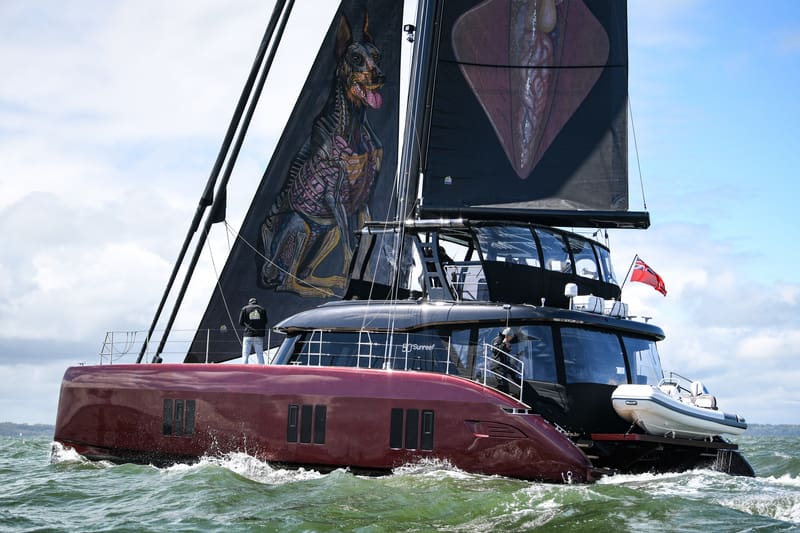
Production or performance cruising catamaran?
A common view is that you pay more for less when you buy a performance catamaran: fewer creature comforts, less living space, fewer berths, bathrooms, and instead get narrow hulls and sparse design. So, is the big price tag worth the upgrade in performance? If you are lured by the comfort of a production catamaran, but plan to sail intensively around the world for the next five years, it might not actually be the most comfortable option. No dishwasher or air conditioning is going to make a boat feel safer in a storm. Conversely, why buy a performance catamaran if you plan to leave the boat at the dock for 10 months a year? Ask yourself if you have the skills to harness the performance of a faster catamaran? And if not, how prepared are you to invest time into learning how to use the boat to her full potential? A common justification for buying a performance catamaran is that it can outrun bad weather and therefore is safer. But you cannot take advantage of that option if you sail everywhere with three reefs in the main because you are nervous of the boat’s power. Similarly, the power of performance catamarans comes in part from how light they are. If you load the boat with extras – personal gear, kitchen appliances, heating, aircon – you will quickly reduce a lot of the speed and safety advantages you’re paying for.
How to handle heavy weather in a cat?
A popular heavy weather strategy is avoidance: account for global weather patterns when planning your passages to ensure you sail during the more favourable months; invest in a good satellite connection to download accurate forecasts so you can see bad weather coming; use your boat speed to position yourself out of the predicted storm track; be flexible with departure windows and leave at an optimum time. However, do not misinterpret avoidance of heavy weather as a safety net. With weather systems becoming increasingly extreme and unpredictable (see page 38), this risk management strategy is becoming less and less dependable.
- Develop scenario plans for the type of boat you have so that you don’t have to start with a blank sheet of paper as a storm approaches.
- In all scenarios, on all boats, avoid 90° wind and waves. Your boat is at its least stable in these conditions. Sail with the weather forward or aft of the beam.
- Keep an eye on heel angle. Reduce sail if you start to see any more than 5° or so, unless you have a catamaran that is designed to lift a hull. Lower the centre of effort by reducing sail, starting with the main.
- Set up and practice how to reef downwind in case the weather comes in more quickly than you were expecting.
- If you can’t sail as fast as the waves, consider trailing warps to slow you down and help with steerage. You should aim to keep the speed relatively high. The key is to reduce the erratic surfing which drops the bows into green-water troughs. I prefer warps to drogues where possible because we are more familiar with them. Unless you practice using a drogue regularly, you will likely need to read the instructions when you get it out, which isn’t ideal in an emergency.
- If waves are breaking over your stern, consider turning into the seaway and holding steady. In a performance cat, you can drop the windward daggerboard, lift the leeward board, and pinch into the wind. In a production cat with no daggerboards, this will be difficult. Running the leeward engine might help you keep your bows into the wind. Watch that there is no back flow of water into the exhaust.
- Avoid lee shores at all costs, sea room downwind is key.
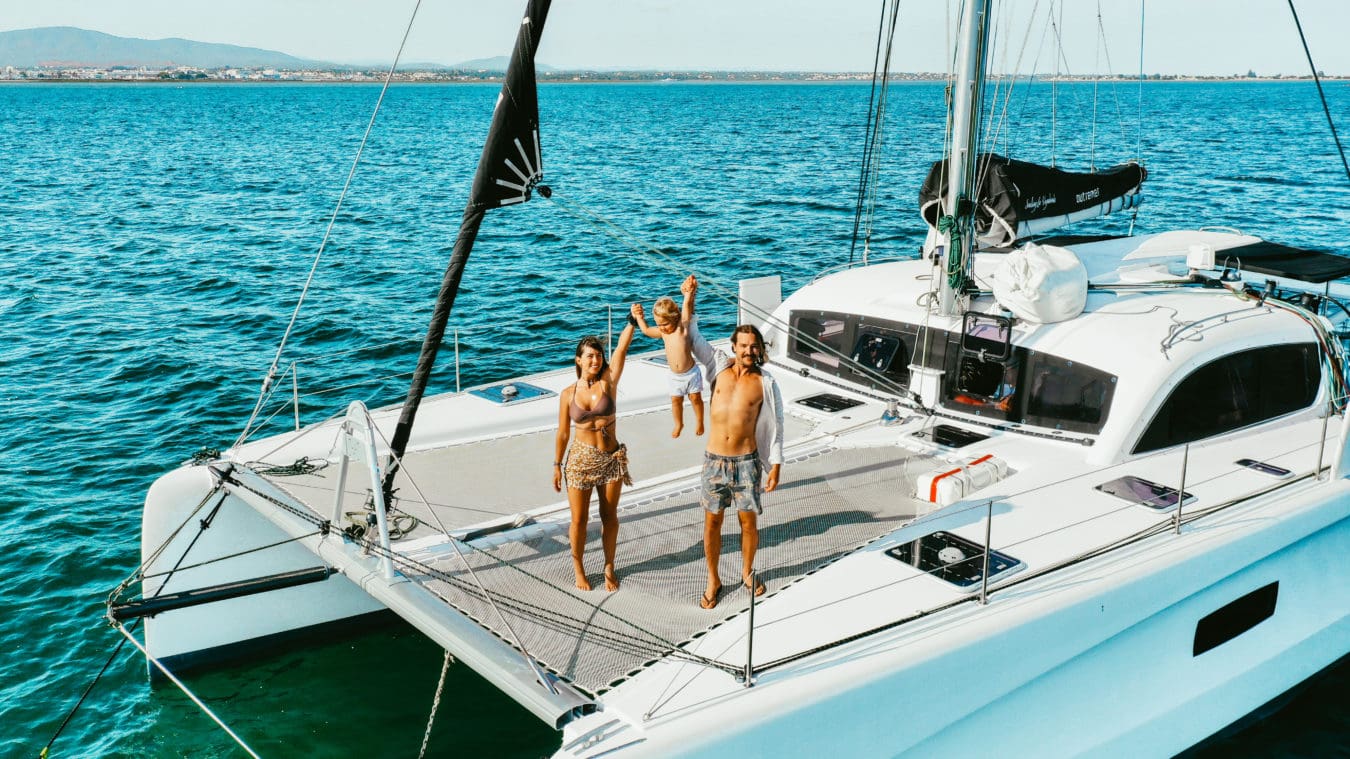
When should we go?
How long should you wait after buying a boat before heading out on your first bluewater passage? Whether you spend £100,000 or £1,000,000 on your boat, it’s likely to need some fine tuning. I’ve never heard of a new boat that was perfect. Some yards will cover the initial issues as part of the warranty, so staying close to the yard is a good idea within that period. Even if you don’t have a warranty, proximity to the yard can help you access parts, boat builders and people who understand how your boat has been constructed. The flip side is that you want to get going, and experience all the freedoms of your new yacht! Some serious bluewater sailing is also needed to test some of the systems. Give yourself two to six months before you head out on the first crossing. This is enough to test the boat out, but not so long that ‘passage-anxiety’ builds up and you never actually leave. Do not treat the first few months as a holiday. This is commissioning, and it is the last stage of the build. Test the boat as rigorously as you can before you leave the proximity of the yard. Complete a couple of substantial offshore passages of 48 hours or more to test the systems. Run everything, including the watermaker. Fly all the sails you own. Sail in fruity conditions relative to your ability (Force 6-8 as a guideline) to see how the boat (and you) cope.
Get some experienced people on board to bolster the crew for the early days. The ideal is to hire a professional coach, as this will make pushing the boat much safer and more fun for you. Do some training ; the MCA AEC four-day engine course is a really useful opportunity to explore the parts of the engine you are normally too nervous to. A safety at sea course is worth its weight in gold. Use this to put together a safety kit that you feel confident in and that is appropriate for your cruising plans. A basic maintenance course can also be helpful, ideally one that covers beginners’ sail repair, rigging, splicing, and electrics. Ask other sailors for a good tools and spares inventory list. On top of the standard parts that the equipment manuals recommend, current and previous owners of your boat model will have a plethora of advice.
Confident to cast off
Knowledge nurtures confidence, and confidence breeds positivity – which all contribute to a safe, and successful bluewater catamaran cruising experience. If in doubt, ask!
YACHTING WORLD // https://www.yachtingworld.com Yachting World has had its finger on the pulse of sailing since 1894 (though some of us joined a little more recently). We reckon we are the most enthusiastic sailing fans in the world: we love boats of all kinds, modern and classic, we like racing and cruising, are fascinated by innovation yet revere tradition, and nothing that floats is too big or too small for our tastes. Every day online and every month in print we bring you the very best in adventurous sailing, whether that be bluewater cruising, ocean racing, high latitudes exploring, or anything in between, and we pride ourselves on our independent tests, in-depth reports and top quality photo journalism.
ABOUT DOYLE SAILS // Around the world, Doyle Sails has over 500 sailmakers in 46 different locations, all equally passionate about sailing – living and breathing our ethos ’Global Leaders and Local Experts.’
As sailors, our obsession with sailing connects us to the water. The water is our playground, a sanctuary where we seek enjoyment, a competitive playing field where we race as competitors; it’s sometimes our home and always a place that unlocks our sense of adventure wherever that adventure might take us. Behind every adventure is a Doyle sailor who shares this same obsession as you. We put your journey at the very heart of what we do to deliver the ultimate enjoyment and performance, powering our constant need to push the boundaries in sail design and innovation, to reimagine sailing.
From dinghies, club racers and cruising yachts through to Grand Prix campaigns and Superyachts, we are your experts. Meet our team here .
- BOAT OF THE YEAR
- Newsletters
- Sailboat Reviews
- Boating Safety
- Sails and Rigging
- Maintenance
- Sailing Totem
- Sailor & Galley
- Living Aboard
- Destinations
- Gear & Electronics
- Charter Resources
- Ultimate Boating Giveaway

Best Cruising Catamarans
- By Cruising World Editors
- Updated: July 1, 2021
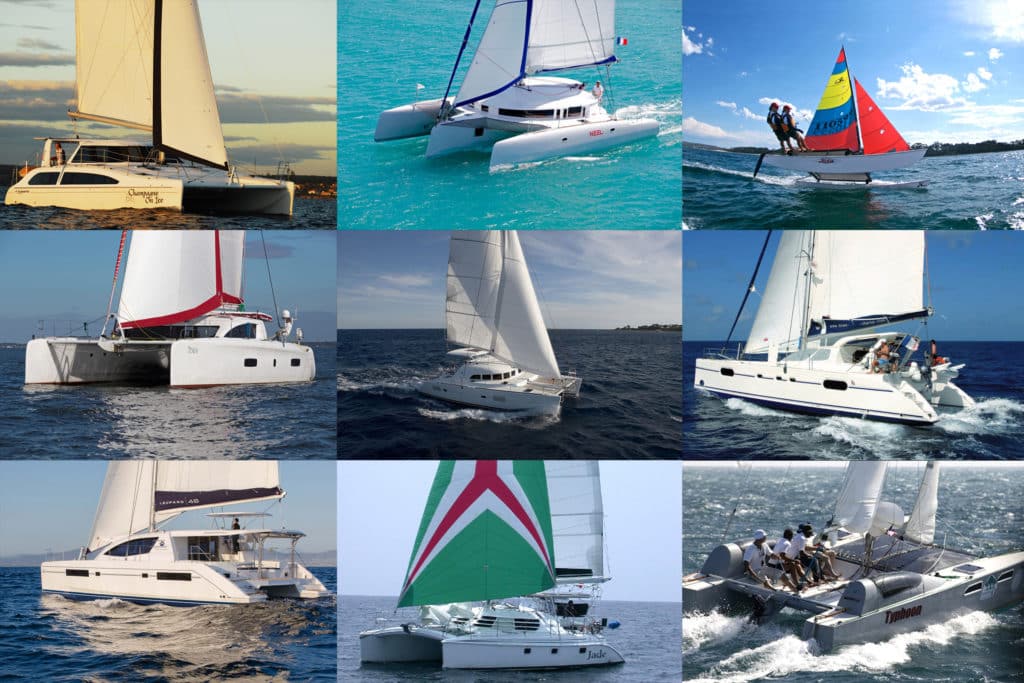
Cruising catamarans have been around for decades, but early models—often plywood and fiberglass vessels built by their owners from plans and kits, kept the boats on the fringes of mainstream sailing. That all changed, though, as big roomy cats were discovered by sailors who went off to charter in the Caribbean, where the multihulls proved their worth as comfortable liveaboard and party boats.
Today’s bluewater catamarans roam the globe, carrying families to exotic destinations across the Pacific and beyond. Just as with their monohull cousins, there is no best catamaran. Instead there is a wide variety of designs, ranging from small catamarans that offer the ease of maintenance a couple might enjoy to performance catamarans capable of easily knocking off 250-mile days. Today, the best catamaran brands offer a range of size models and layouts that can be optimized for an owner sailing with family and friends, or for the charter market, where there’s a demand for four, five and even six cabins worth of accommodations.
The most prolific catamaran manufacturers are in France and South Africa where yards include both large-run production builders and niche companies building fewer than 10 boats a year.
The best cruising catamarans offer good load-carrying ability and respectable performance. As with any sailboat , a modern catamaran’s design is a result of compromises. Daggerboards or keels? Galley up or galley down? Spacious owner’s cabin or extra bunks? There are lots of options to choose from—and that’s what makes looking at these sailboats fun!
Here, then is an eclectic A to Z list of some of the best catamarans that have helped shaped the evolution of how we live and sail on two hulls.
Antares 44i
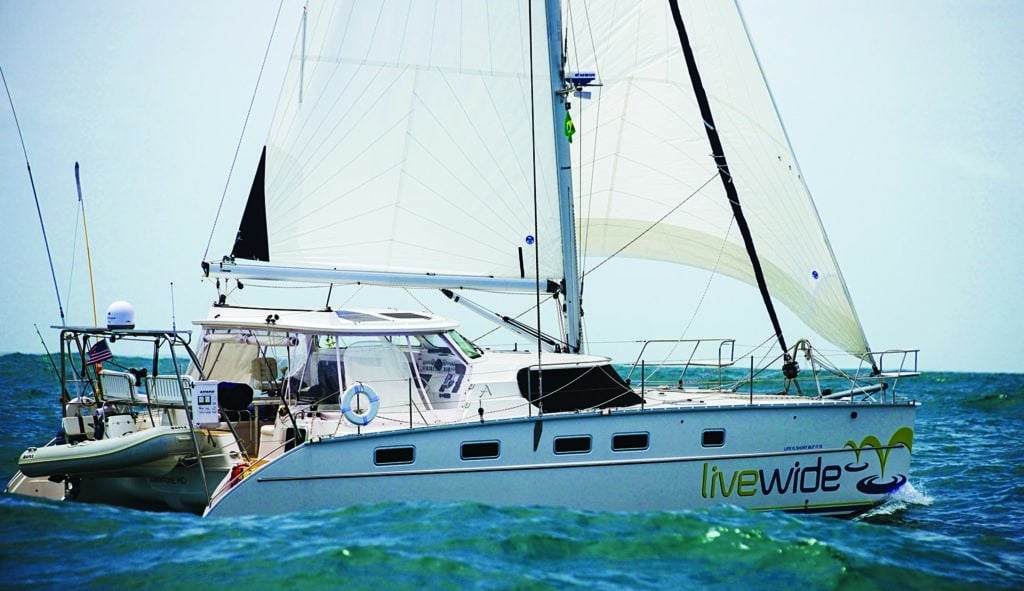
Now built in Argentina as a full-fledged, bluewater catamaran and cruiser that can be safely operated by a shorthanded couple or family crew, the Antares 44i features a fully covered cockpit with a quartet of big, standard solar panels recessed within the hardtop, one example of a yacht capable of long-range passagemaking.
Atlantic 42
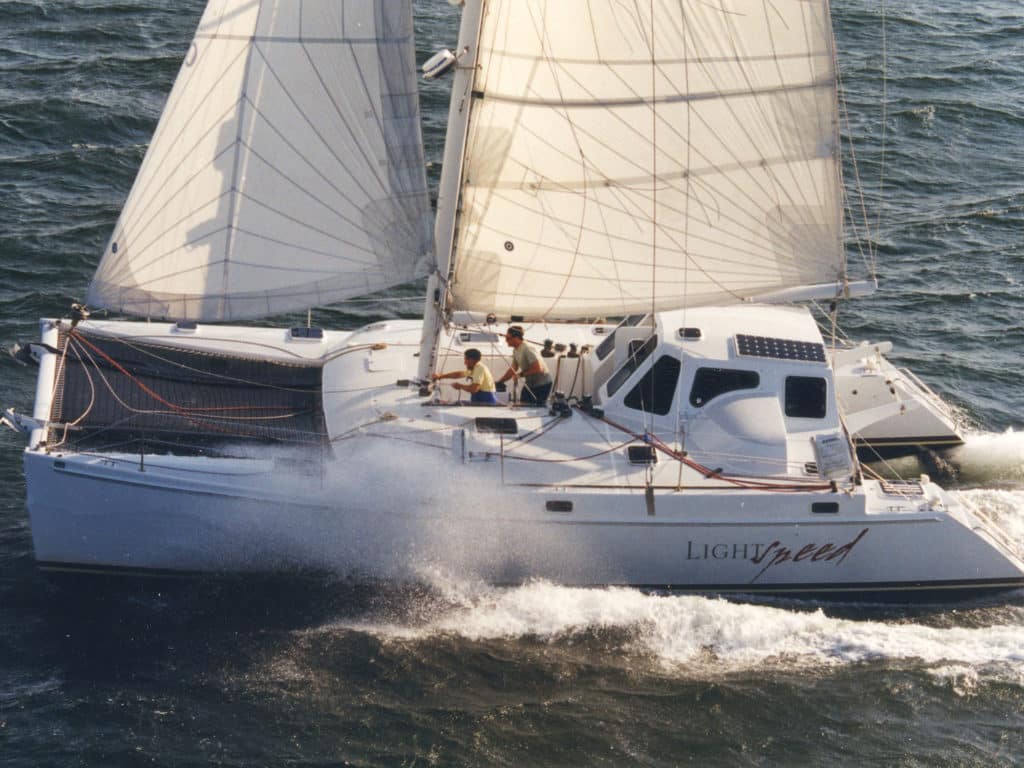
Almost 30 years ago, yacht designer Chris White revolutionized catamaran design with the first in his series of Atlantic cats, the primary feature of which was the innovative mid-ship sailing cockpit forward of the main cabin. The smallest in the Atlantic line, the 42 remains White’s most popular design ever.
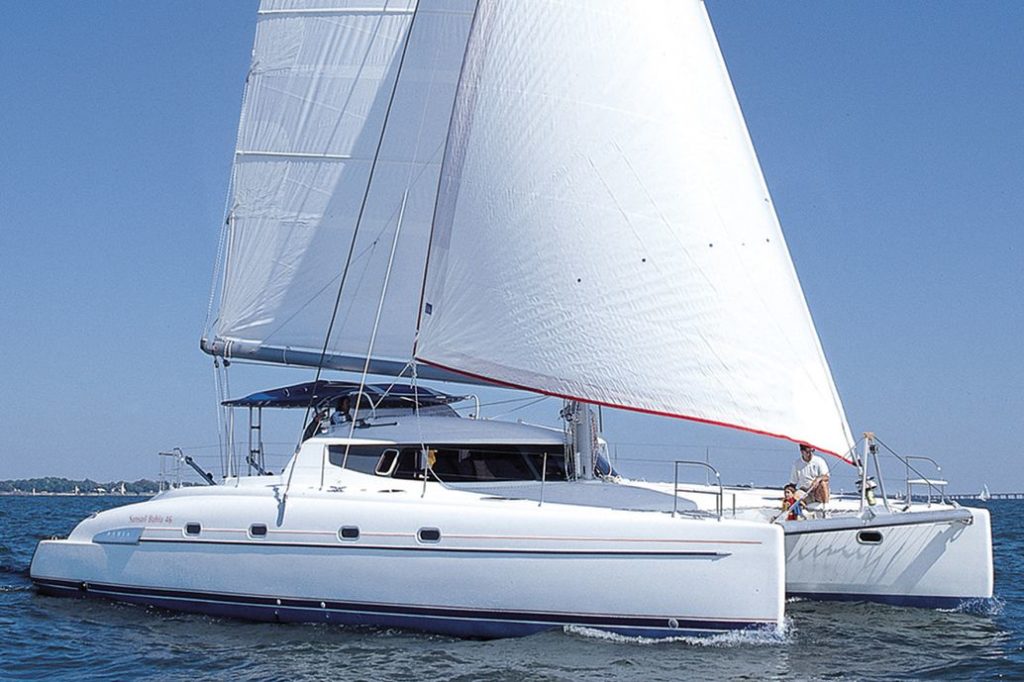
Fountaine-Pajot has built so many outstanding cruising catamarans that it’s difficult to narrow down any single boat, but we’ve always been fans of the good-looking, well-thought-out Bahia 46. At 46 feet, the boat is large enough for offshore forays and has plenty of volume; with its simple but powerful sail plan, it’s also an excellent performer.
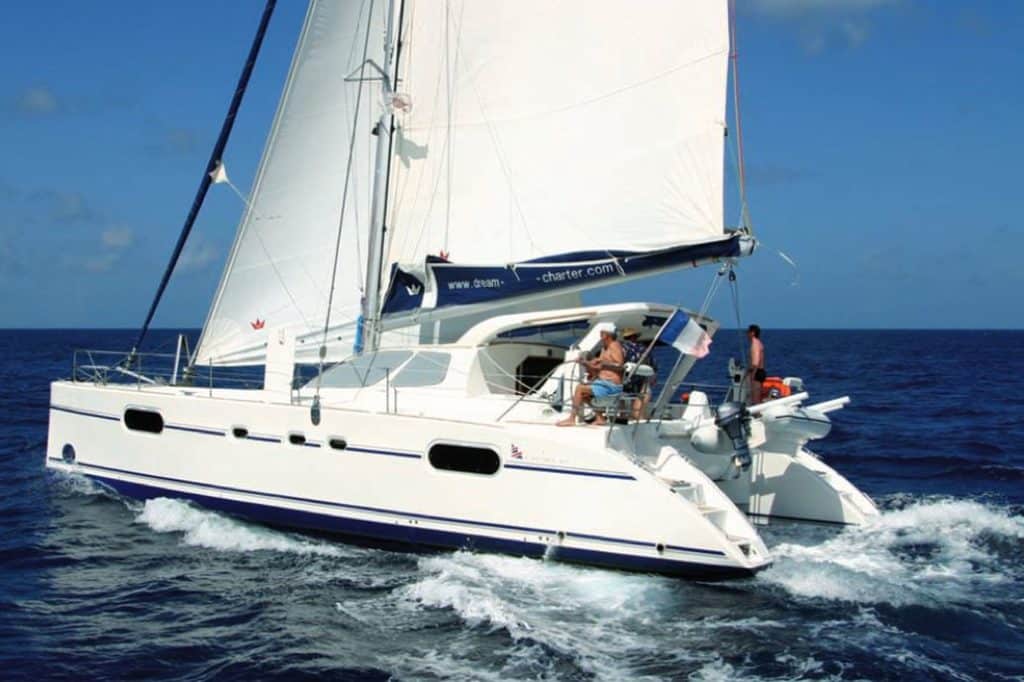
Beginning around 1996, the French builder Catana was one of the first companies to manufacture fully found cruising cats for private ownership, and this Christophe Barreau design, which enjoyed a nearly 10-year production run from 1997-2006, was emblematic of this first generation of safe, fun, long-legged offshore voyagers.
Click here to see more cats from Catana.
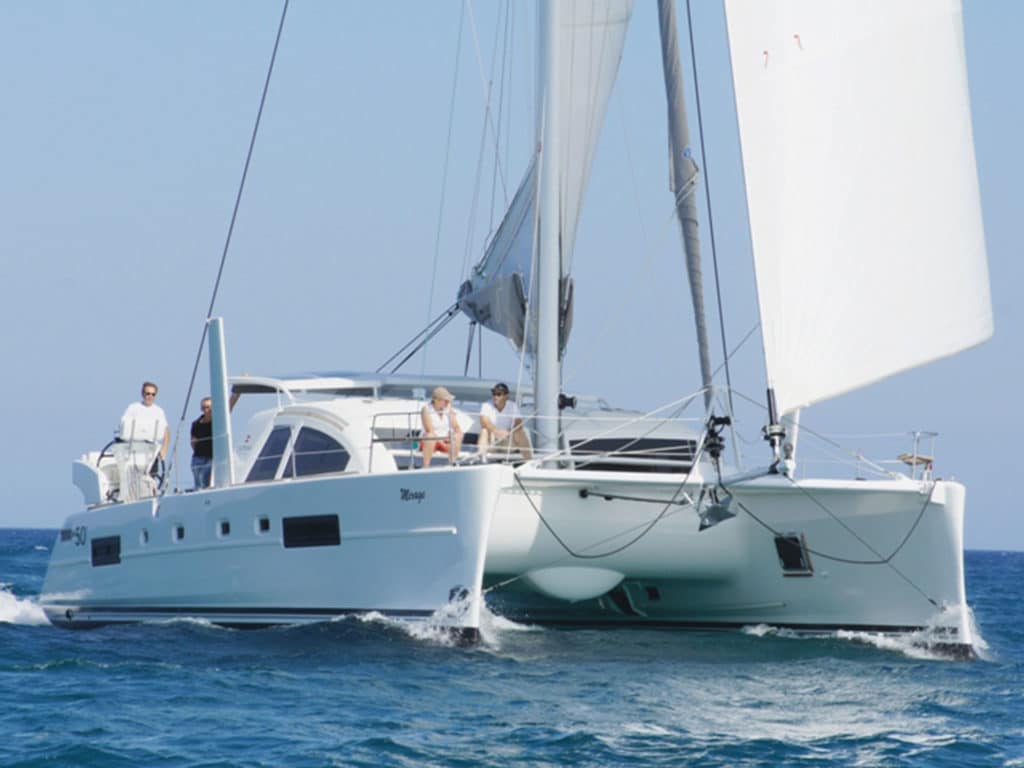
When it comes to speed, light boats are fast ones. And if you wish to save weight, that means exotic modern materials like carbon. Catana now infuses the laminates of their entire production line with carbon fiber, and for this list, we’ve chosen the Catana 50 Carbon, one of the zippiest cats now crossing oceans.
Click here to read about a couple’s charter aboard a Catana 50.
Gemini 105M
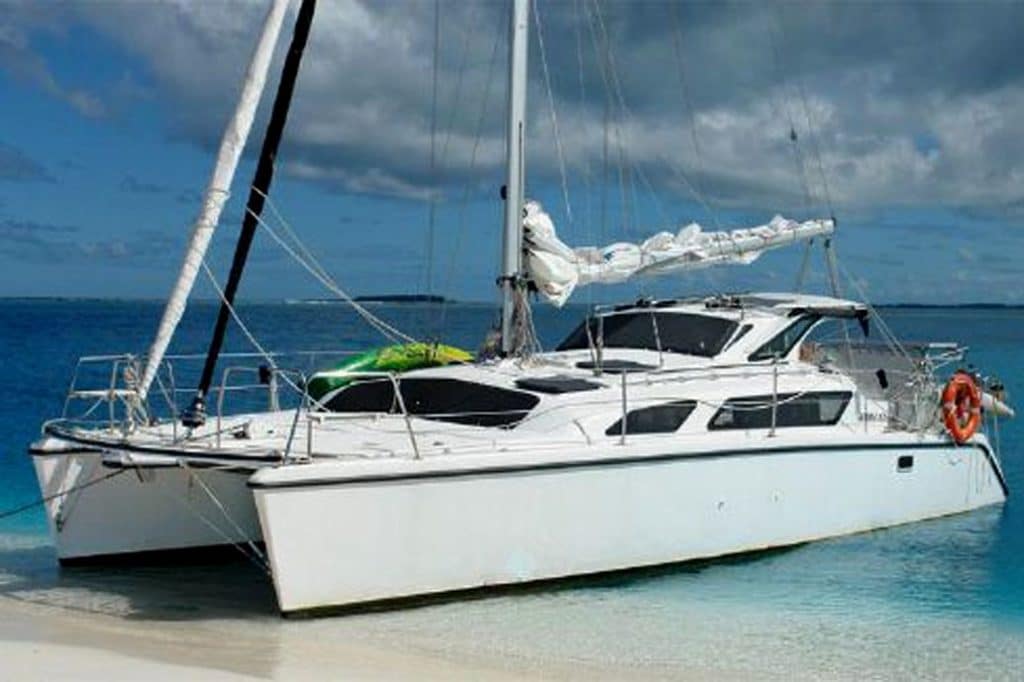
Pioneering catamaran sailor, builder and designer Tony Smith launched the first of his 33-foot Gemini 105M’s (10.5 meters = 33′) in 1993, and soon after found a ready and willing stream of sailors enamored of the boat’s compact size, affordable price tag, and such innovations as the nifty lifting rudder and transom steps.
Click here to read about the Gemini Legacy 35.
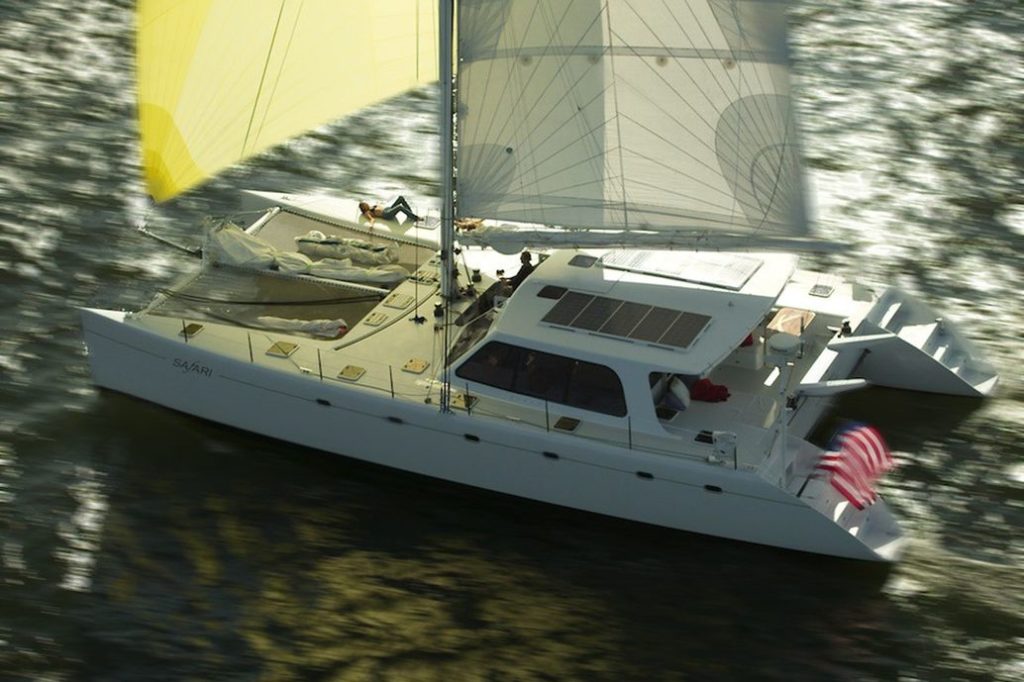
Built between 2000-2005, the Gunboat 62 firmly established the Gunboat brand: go-anywhere cats that applied race-boat technology to a world-cruising platform. Hull no. 1, Tribe, was built for company founder Peter Johnstone, who then spent a year-and-a-half cruising with his family, smiling all the way.
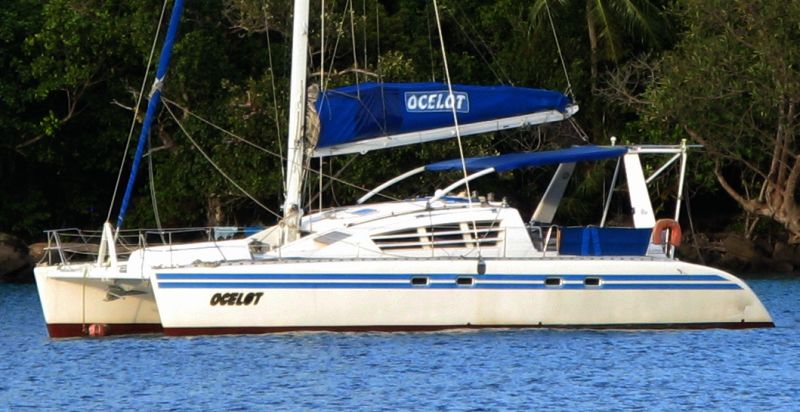
French builder Henri Wauquiez is best known for his long career building monohulls, but the Kronos 45 cat, which he launched in 1992, was ahead of her time. Classic lines, the aft “targa bar” over the cockpit, the louvered coach roof windows, even the distinctive stripes on her hull: the Kronos 45 remains timeless.
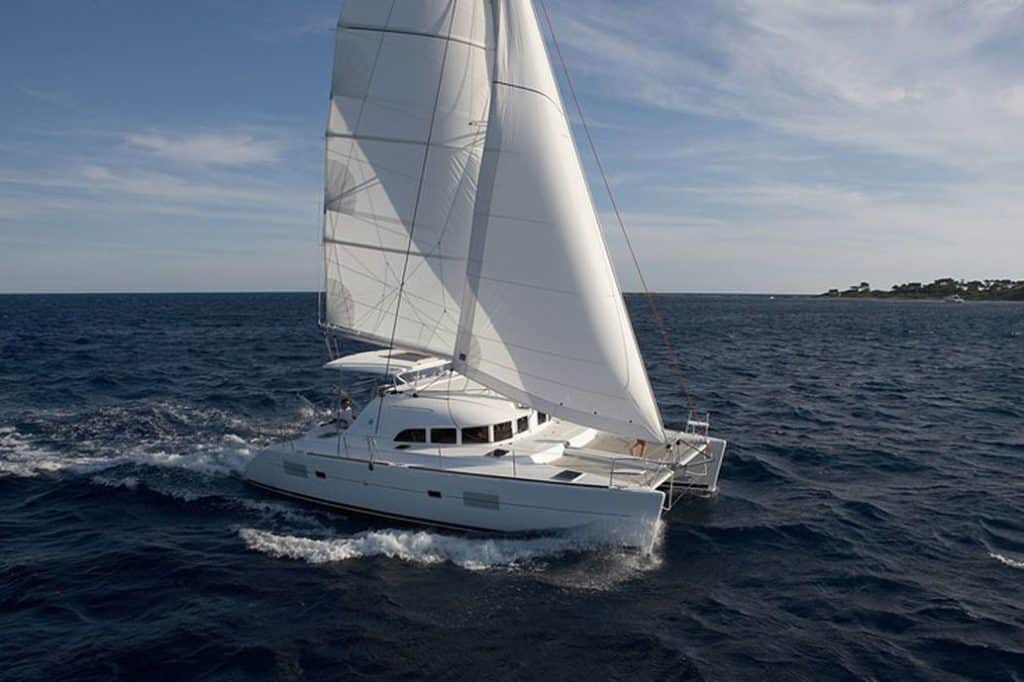
No roundup of cruising cats would be complete without several Lagoon entries, and the best of that impressive bunch might well be the Lagoon 380. Originally launched in 1999, and revered for its combination of quality, volume and performance, with over 740 boats built the 380 is still going strong.
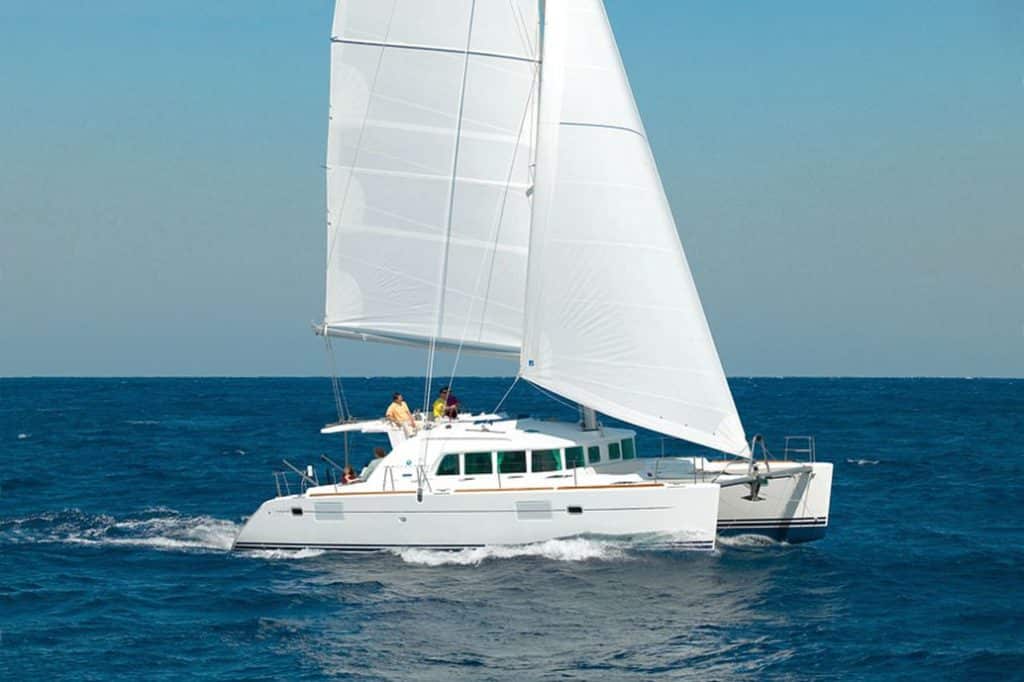
Launched five years after the breakthrough 380, the Lagoon 440 was an evolutionary design that featured a raised flybridge helm station, a unique “gullwing” configuration below the bridge deck, expanded windows in the hull and much more. With 400 boats built in a 6-year production run, the 440 was an unqualified success.
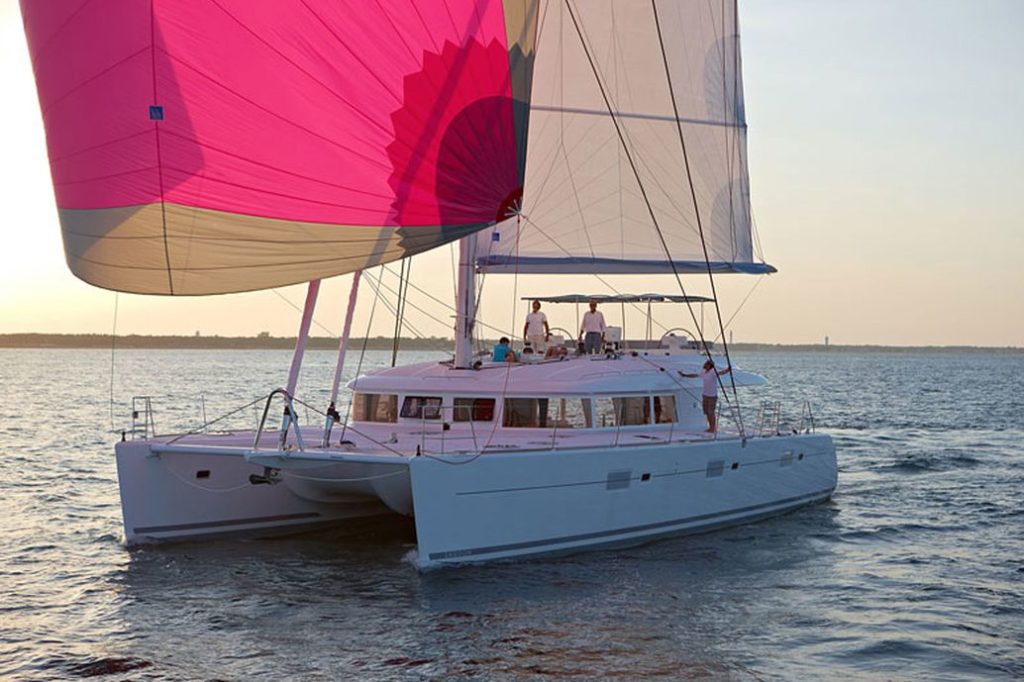
How big can a production cat, still operable by a short-handed crew, really be? The builders at Lagoon discovered that 62-feet hit a sweet spot in the marketplace, and have sold over 70 boats since its introduction in 2010. The centerpiece of this design is the sensational steering station atop the flybridge, with expansive views of the sea and sky.
Click here to see more cats from Lagoon.
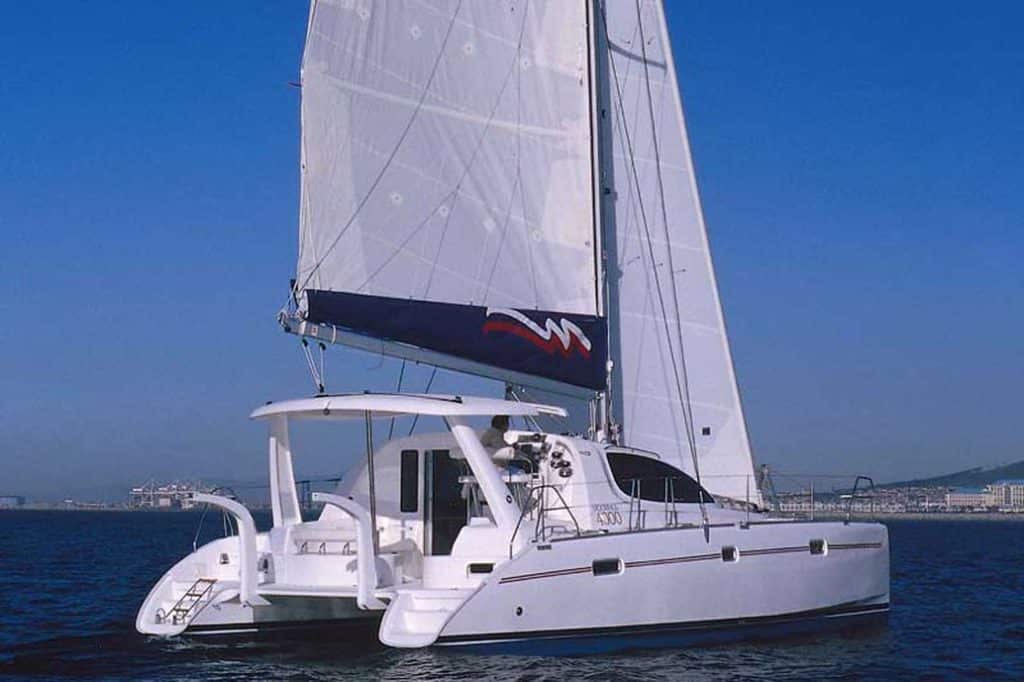
With an unmatched pedigree – designed by premier multihull naval architects Gino Morelli and Pete Melvin, built by the prestigious Robertson & Caine boatyard in South Africa, and commissioned by chartering giant The Moorings – the Leopard 40 was, perhaps unsurprisingly, Cruising World ’s Import Boat of the Year in 2005.
Louisiane 37
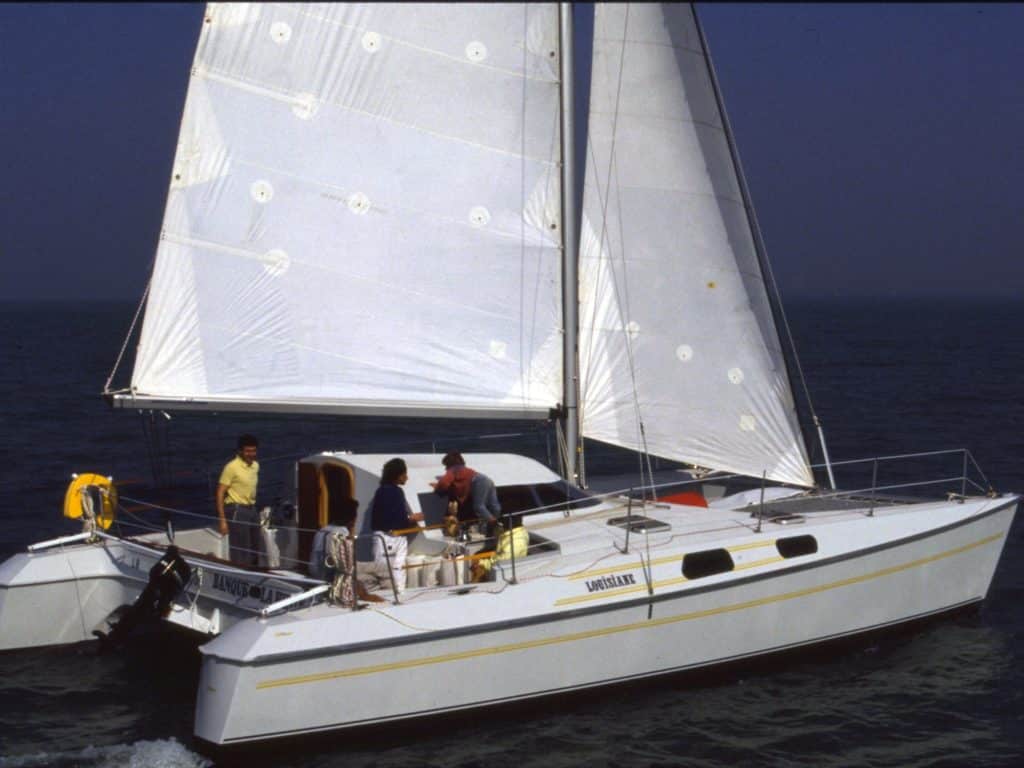
Based on the famous French racing cat Charente-Maritime, the Louisiane 37, designed by Joubert/Nivelt and launched by builder Fountaine-Pajot in 1983, was a light, fast liveaboard cruiser with full accommodations that represented a radical departure from the hefty British cats that preceded it.
Maine Cat 30
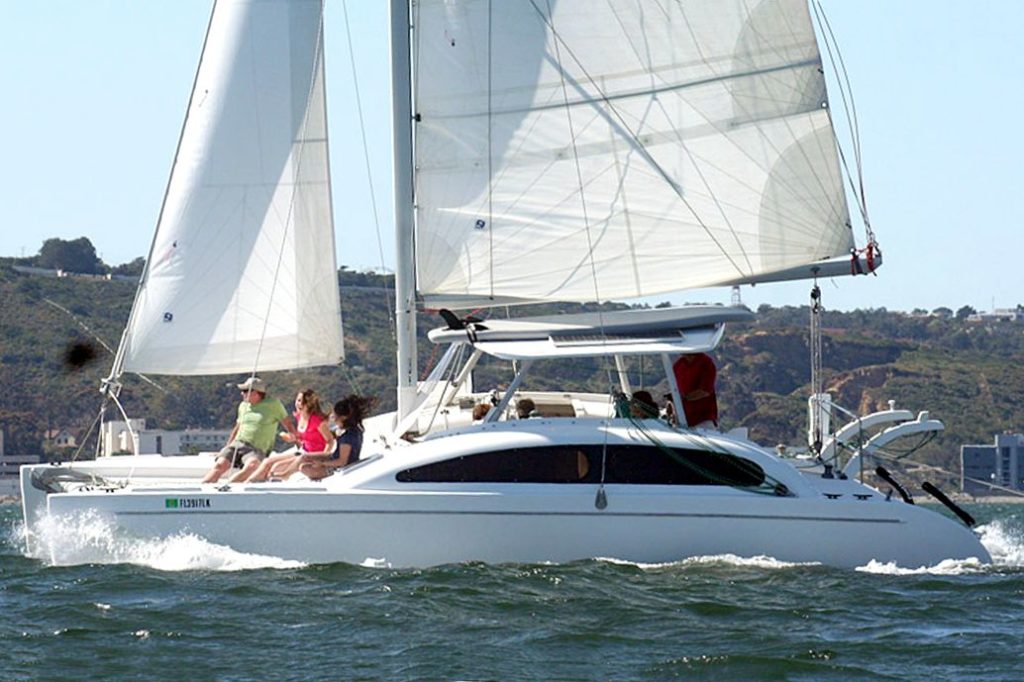
One of the more versatile and clever cats ever created, the central feature of the cool Maine Cat 30 is the open bridge deck/living room sandwiched between the hulls and canopied by a rigid, permanent hard top (the comfortable accommodations/ staterooms are stationed in the hulls). Ideal for a winter in the Bahamas but with the ability to sail offshore, it’s a boat for all seasons and reasons.
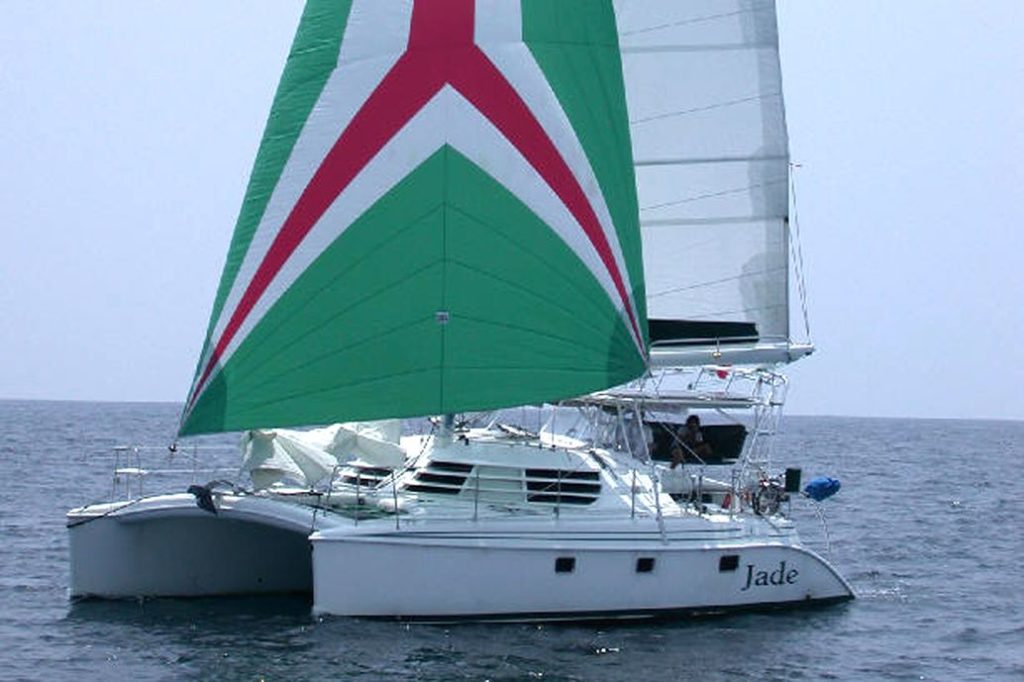
Built in Florida and beloved by the owners of the over 120 boats built during the company’s existence from 1993 to 2009, the Manta Catamarans range included 38-, 40- and 44-foot cats. For this exercise, however, we’re heralding the original Manta 42, which won the Best Value Overall prize in CW’s 2001 Boat of the Year contest.
Moorings 4800/Leopard 48
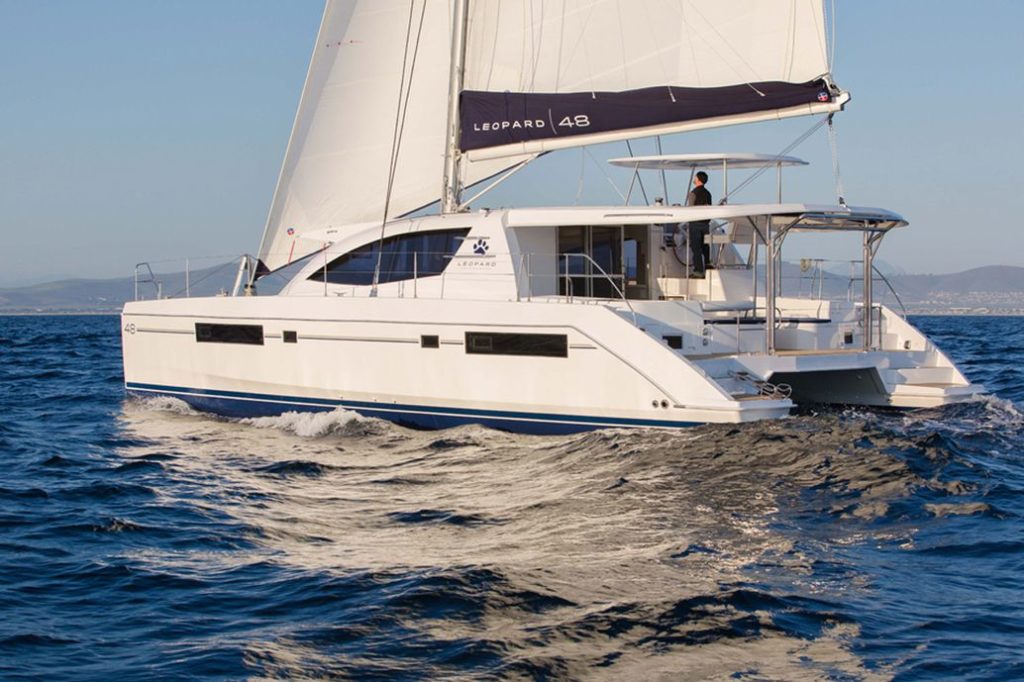
Another Leopard/Moorings collaboration built by the wizards at Robertson & Caine (though this boat was designed by fellow South African Alex Simonis), the Leopard 48 was another CW Boat of the Year winner with all the contemporary bells and whistles: forward cockpit, flybridge helm station and solid hardtop dodger, just to name a few.
Click here to read more about the Leopard 48, and click here to see more images.
Nautitech 441
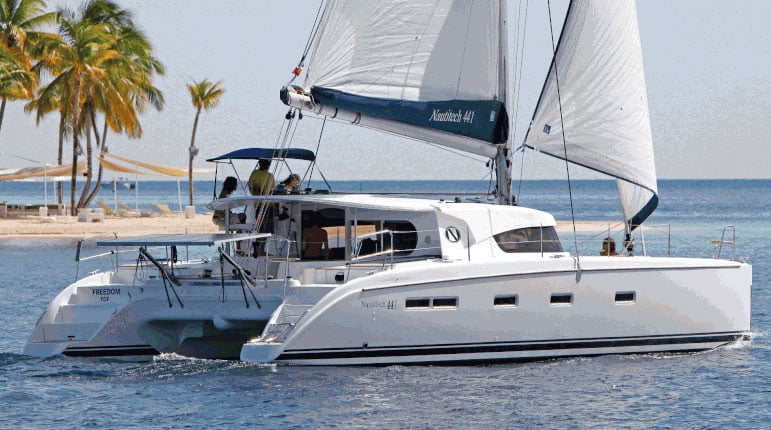
The Best Multihull Under 45 Feet: So said the CW judging panel in the 2013 Boat of the Year competition, regarding the Nautitech 441. But what makes this versatile platform so intriguing are the different helm set-ups. The 441 employs a single wheel, to starboard, ideal for solo sailors, while the 442 has a pair of helm stations aft.
Click here to see more Nautitech Catamarans.
Outremer 5X
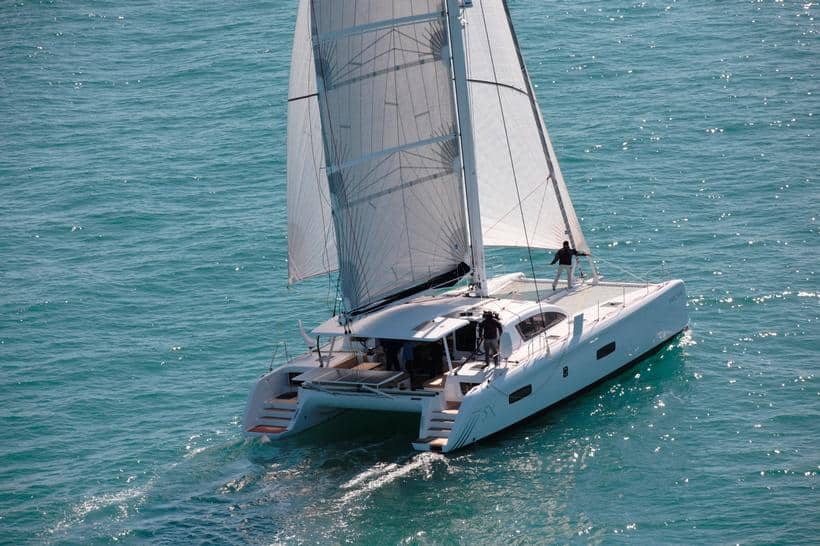
A state-of-the-art all-oceans cat that exemplifies how far multihull design has come, the 59-foot Outremer 5X was a winner on both sides of the Atlantic, taking top honors in the European Boat of the Year competition in 2013, and following up as the Best Full-Size Multihull in CW ’s contest a year later.
Click here to see more cats from Outremer.
St. Francis 50
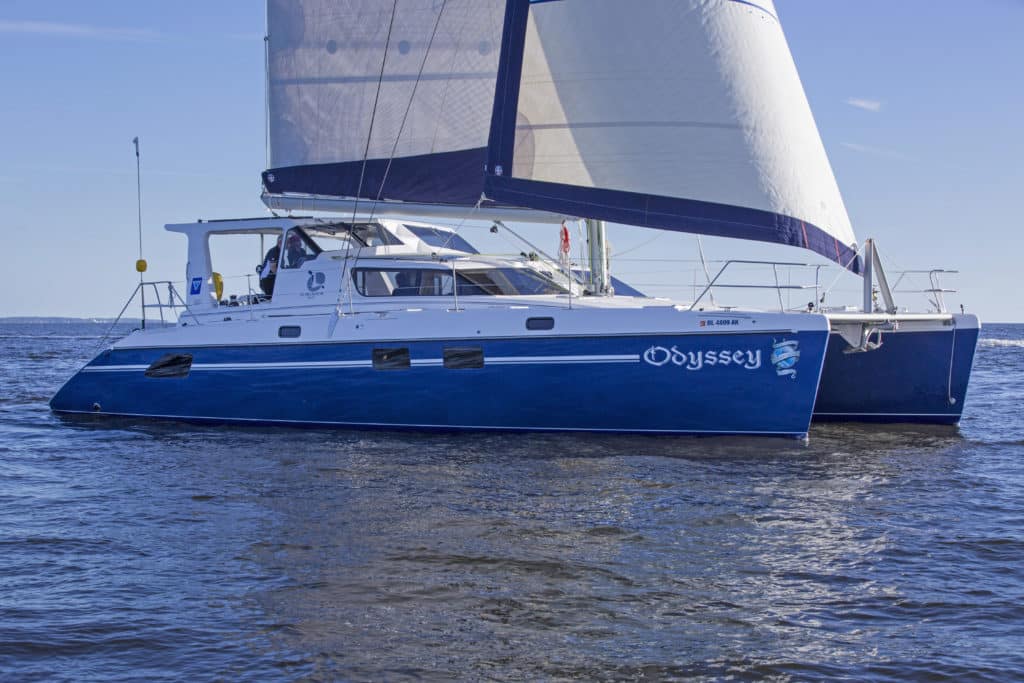
The flagship of the proud St. Francis line – built in South Africa since 1990 to designs by local legends Lavranos Marine Design – the St. Francis 50 is another “luxury cat” that shares much in common with an earlier 48-foot sister-ship, but packs even more payload into its roomier lines.
Click here to read more about the St. Francis 50
Seawind 1000
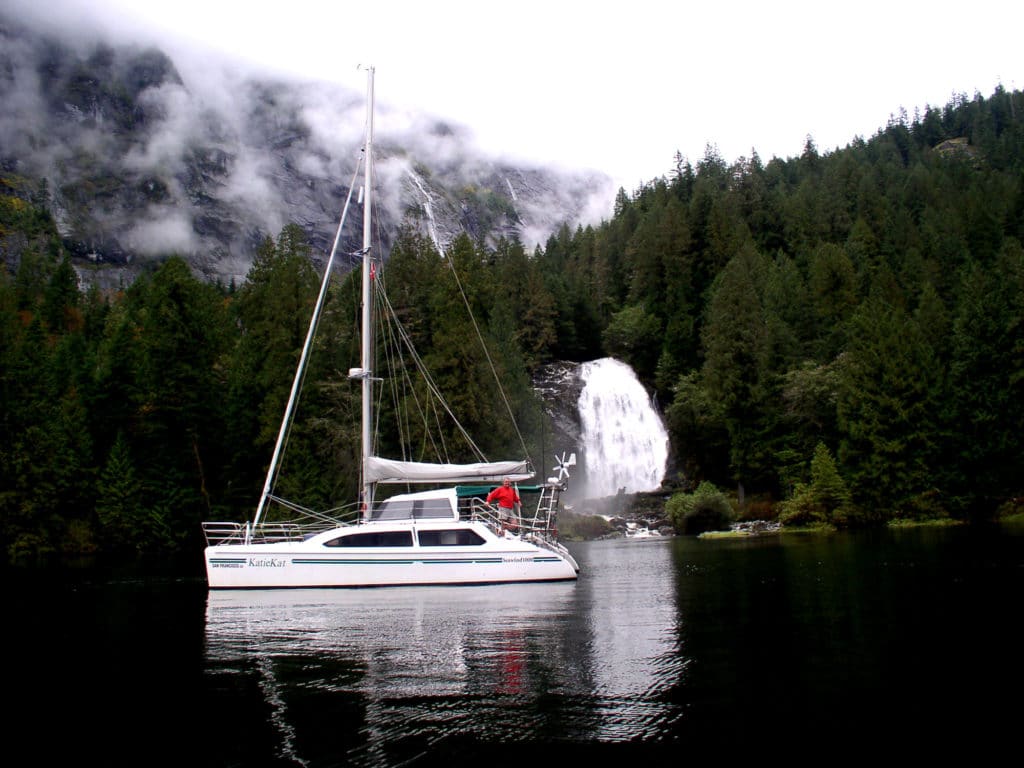
Founded by Aussie surfer and sailor Richard Ward in 1982, the 33-foot Seawind 1000 is easily the most popular cruising cat ever built in Australia (the company has since moved its manufacturing and management operations to Vietnam). Roomy and airy, these cats dot the coastline of eastern Oz.
Seawind 1160
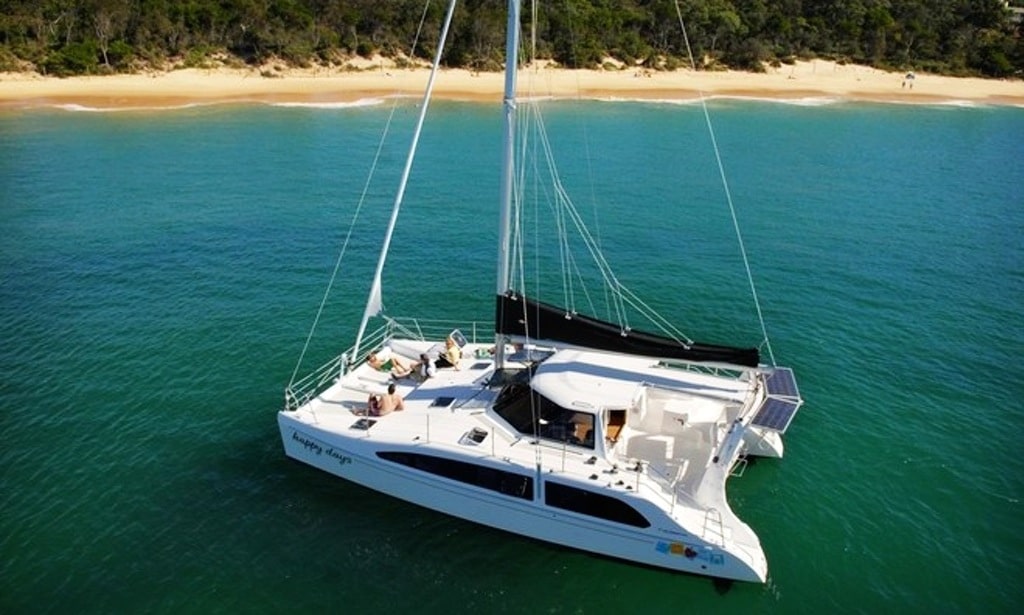
If the Seawind 1000 was a minimalist approach to cruising cats, the 38-foot Seawind 1160 is the flip side of the coin, a full-fledged long-range voyager. Among the reasons it was named CW ’s Most Innovative boat for 2007 is the unique “tri-folding” door that stashes overhead to open up the saloon and cockpit into a spacious living area.
Click here to read more about the Seawind 1160.
Sunsail 384
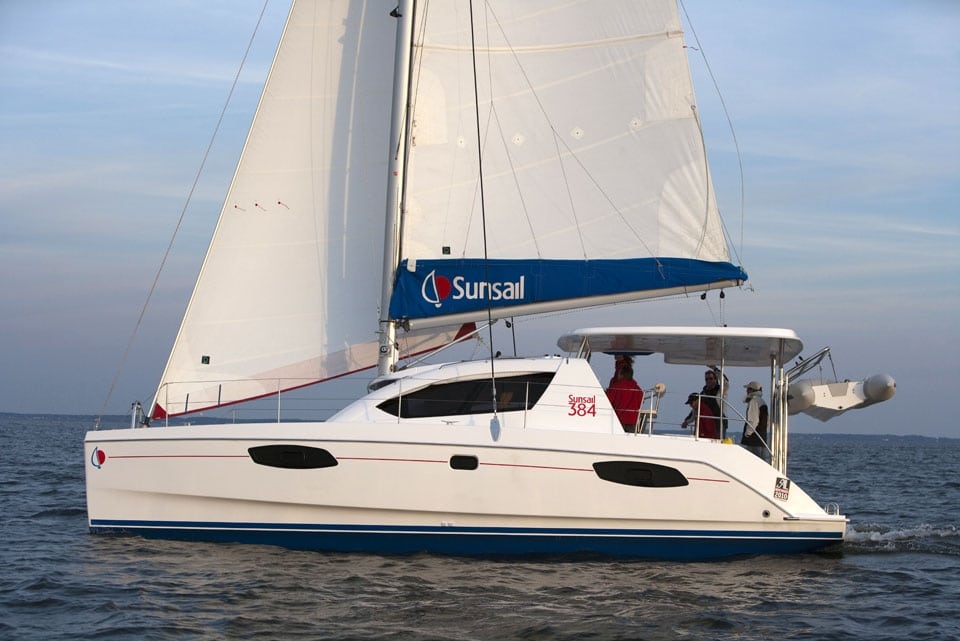
Every sailboat is a compromise, and in the case of the Sunsail 384 (also sold privately as the Leopard 38) that’s a good thing, because designers Morrelli & Melvin and builder Robertson and Caine got the balance just right with this relatively small catamaran. With four cabins, the 384 can carry the same size bareboat charter crowd as her larger siblings, but does so with a decided bounce in her step. Named CW’s Import Boat of the Year in 2010, you can gauge the success of the design by the grins on the crew as they barrel down Sir Francis Drake channel in the British Virgin Islands.
Victoria 67
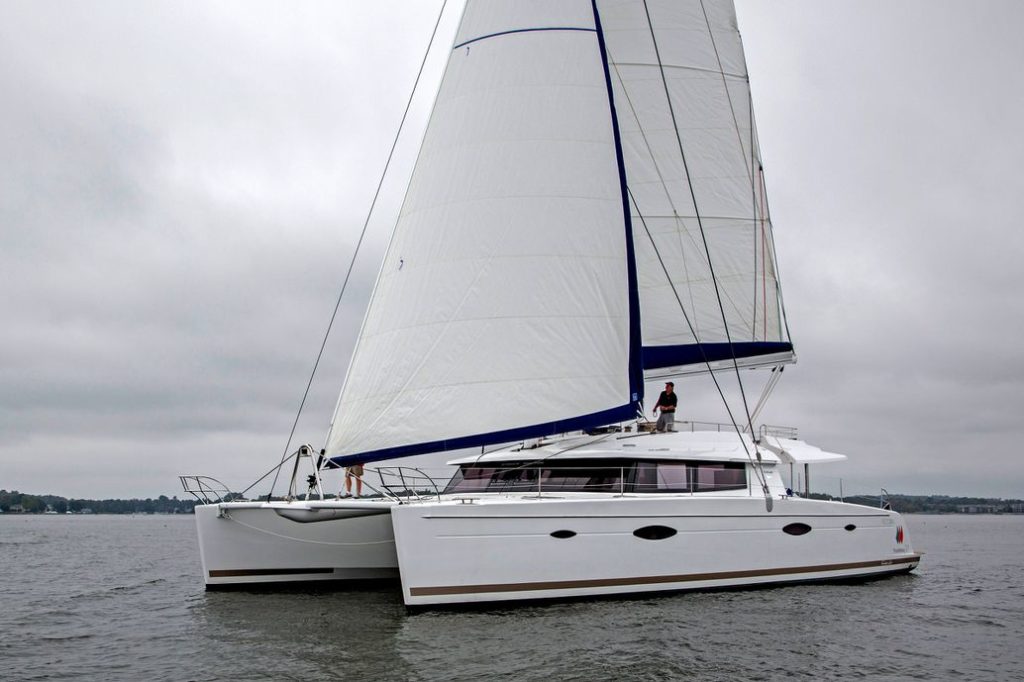
The French design office of Berret Racoupeau drafted the lines of Fountaine-Pajot’s new flagship, introduced in 2013, a magnificent world-girdling voyaging catamaran. Like other giant cats launched in recent years, the boat features a sensational upper deck with all sail controls, helm and lounging stations.
Click here to see more images of the Victoria 67.
Wharram Tanaroa
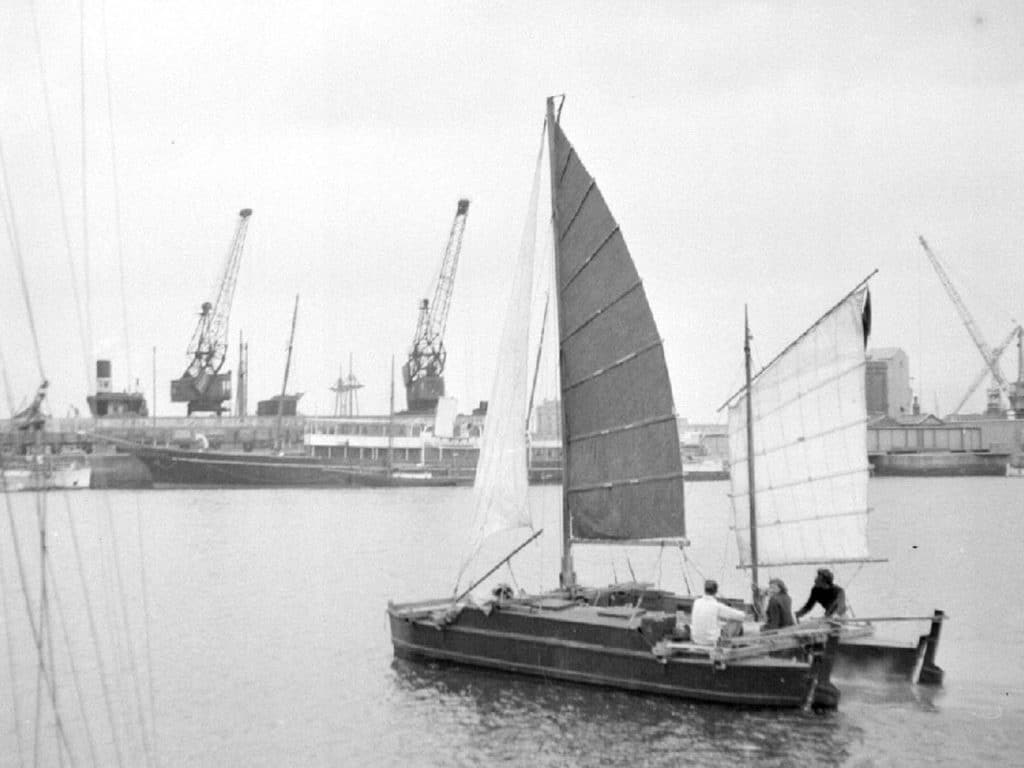
No list of influential multihulls would be complete without the work of James Wharram, and while Tangaroa wasn’t a production cat by any means, it showcases the British designer’s respect for ancient Polynesian craft. Wharram sailed this 23-foot-6-inch “double-hulled canoe” across the Atlantic in the 1950s, and sold countless plans for similar boats for decades afterwards.
- More: Boat Gallery , catamaran , multihull , Sailboat Reviews , Sailboats
- More Sailboats
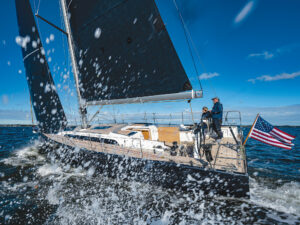
Sailboat Review: Solaris 44
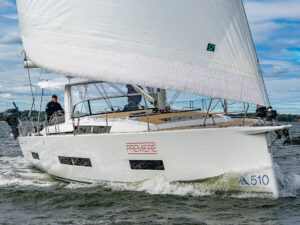
Sailboat Review: Hanse 510
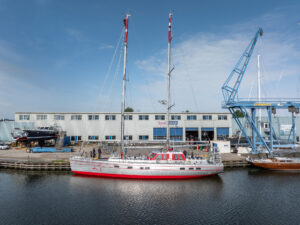
The Pelagic 77 Amundsen is Delivered
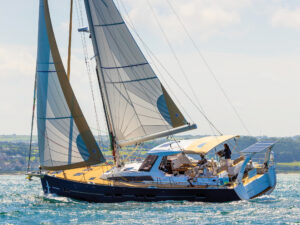
New Boats on Deck

The Ship’s Library: Add These Essential Reads for Caribbean Cruising
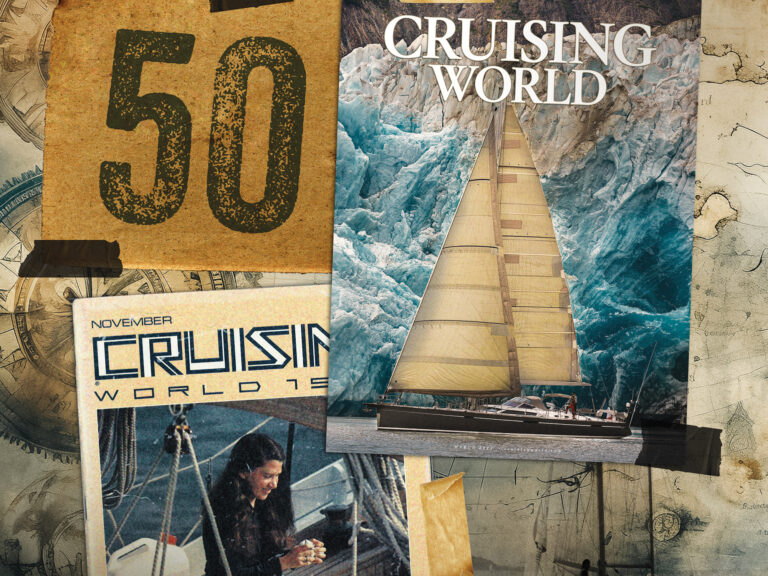
Gold Standard: Cruising World Turns 50
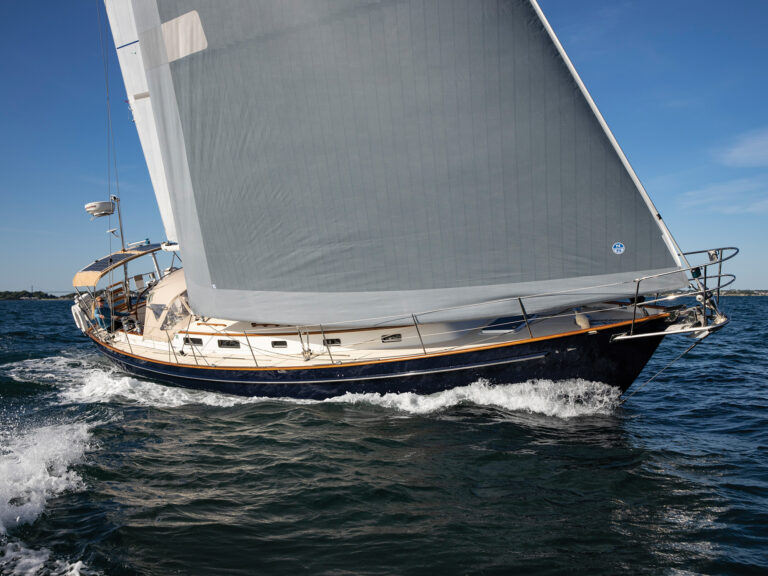
More, Please: Life After Six Months at Sea
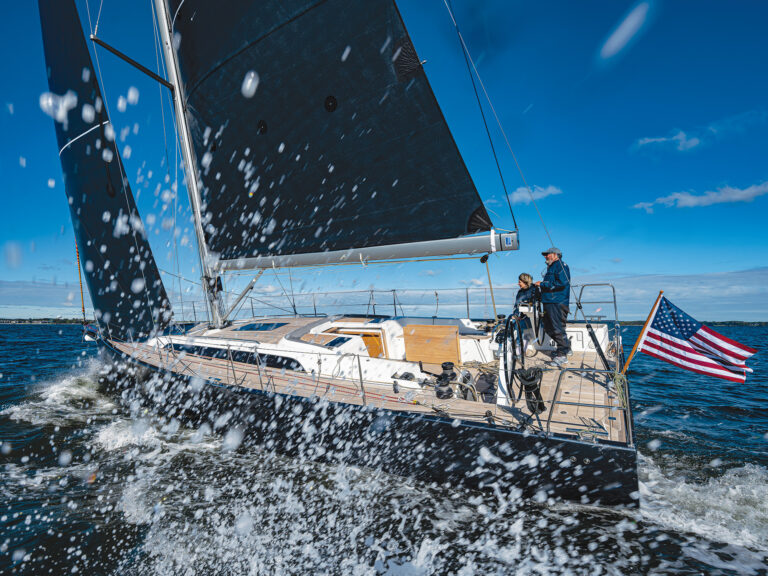
- Digital Edition
- Customer Service
- Privacy Policy
- Terms of Use
- Email Newsletters
- Cruising World
- Sailing World
- Salt Water Sportsman
- Sport Fishing
- Wakeboarding
Better Sailing
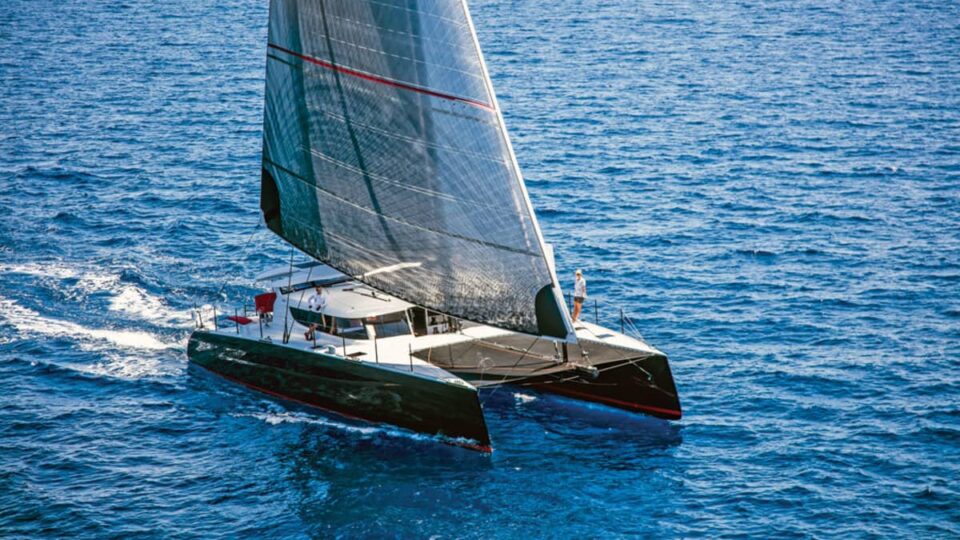
How Fast Do Catamarans Sail? Average Sailing Speed of a Catamaran
In most aspects, sailing a catamaran is very similar to sailing a monohull. If you learn to sail on a monohull then most of the skills are transferable. But, there are a couple of subtle differences that we will analyze further in this article. A catamaran is generally more balanced on the water and can be faster than a multi-hull vessel. And, cruising on a sailboat with a cat hull will be much faster than cruising on a sailboat with a monohull. Therefore, a catamaran hull is able to achieve the speeds of a racing monohull and is also more comfortable to sail on.
A tri-hull is even much better as they’re designed towards the performance end of the spectrum. And that is why they double the speed of a racing monohull. So, let’s analyze this subject further in this article and see what’s the average sailing speed of a cat. Follow me!
Catamaran Vs Monohull Speed: Are Cats Faster than Monohulls?
Not all cruising cats are always faster than an equivalent length monohull. But, many well-designed and balanced multihulls can easily surpass the speed of their monohull cousins. And, it’s not fair to mass all cats into one example, but performance cruising catamarans like the Nautitech or Neel trimarans distinguish from others. Their narrow waterline beams, hull chines, deep and fine keels, and rudders as well as efficient sail plans will typically be faster than the average cruising monohull.
“The fun of sailing is proportional to the speed of sailing”, as an American designer, L. Francis Herreshoff, said. And, it’s basically true because when we sail and see another boat heeling in the breeze, we also feel we want to do the same. This is because for many sailors speed means much more than just fun. You should, however, consider keeping your cat as light as possible if you want to maximize speed. I know that keeping your sailboat light is difficult but it’s of importance if speed is your main goal.
Keep in mind that a boat’s speed has won wars and has also been a contributor to safety. In the past, a fast warship was able to outmaneuver its adversary or escape from a boat with more firepower. And just as proven in history, the speed of a sailboat is important and provides a faster boat with more options.
Monohull VS Catamarans Differences
- When tacking, you must work hard to keep your speed consistent in the tack and always ease the mainsheet to avoid “windvaning.” When the larger mainsail on a catamaran attempts to turn the boat back towards the wind, this is known as windvaning.
- On a monohull, you must be extremely cautious about an unintended gybe. Meaning that you must gybe much more slowly. On a catamaran, you can take advantage of the increased speed and sustain it while gybing to help depower the main.
- On a monohull, and when winds increase, the boat starts heeling. This automatically informs you that you have too much sail up and it’s time to reef. And, as catamarans don’t heel, you have to be very careful when to reef the massive main. Most of the time, you will throw in the first reef at 18-20 knots of wind speed. The second reef will be put as the wind gets closer to 23-25 knots. The above-mentioned always depend on the size and type of your vessel.
Wind as a Main Factor for Speed
Thanks to tech evolutions in radar, satellite, and computer technology, a five-day forecast is as accurate as a two-day forecast was back in 1980. A multihull’s higher speed also contributes to easier and safer planning of ocean passages around weather windows since exposure time will be less. Moreover, meteorological prediction for shorter periods is far more accurate. Keep in mind that when sailing faster you also introduce the concept of apparent wind to the strategy of efficient sailing.
Multihull speed upwind? Sailing upwind, the catamaran usually experiences more apparent wind across the deck since it’s sailing faster. Therefore, the sails will feel more pressure, which will make the boat perform even better. And, of course, the concept of apparent wind contributes to the joy of sailing, as it adds another dimension to it. When sailing towards a downwind destination, fast multihulls are able to sail at smaller wind angles. Subsequently, this brings the apparent wind forward of the beam, hence optimizing the angle of attack on the sails.
While cats will fly gennakers, code-zeros, or asymmetric spinnakers, monohulls mostly set symmetric spinnakers to the poles. And most importantly, their boat speed will often cancel out the true wind and will reduce the apparent wind and performance. The faster the multihull is the more it is able to take advantage of the apparent wind and tack downwind towards its destination. Although it might be sailing twice the distance, it will arrive at the downwind mark quicker because its Velocity Made Good (VMG) will be faster.
>>Also Read: How Fast is a Laser Sailboat? Laser Sailboat Top Speed
Performance Characteristics
Bear in mind that cats require four times the power to double their speed. But, a mono-hull vessel requires eight times the power to double the speed. This is due to the fact that a cat has less resistance in the water. However, this is great in terms of conserving and using less energy. Catamarans are also more stable in the water. This stability is effective at resisting heeling or capsizing. In other words, a multi-hull vessel requires four times the force to capsize as a similar-sized mono-hull vessel.
Most of the time, sailing in a catamaran is smoother and facilitates activities that are not always possible on a mono-hull sailboat. In addition, as catamarans have less water resistance, they are generally faster than mono-hull vessels. As their hulls are smaller, this means that they have a smaller bow wave to fight. The bow wave is a wave created by the displacement of water by the bow of a ship. After a certain speed, the boat has to start hauling itself over its own bow wave. Meaning that the larger hull a boat has, the larger its bow wave will be and the more power will be required in order to fight it.
Since catamarans have two small and narrow hulls, they don’t have much of a bow wave. This is one of the reasons they are normally quicker than a monohull vessel of comparable size. Catamarans can travel at speeds of up to 30% faster than monohull boats. Catamarans have the disadvantage of taking longer to transform than monohulls.
Lastly, the thing that makes monohulls harder to sail is heeling and smaller spaces. In stronger winds, monohulls tend to heel. This results in making most tasks a bit more difficult to perform. Whether you’re heading forward to reef, trying to winch in a sail, or move about the boat, sailing on a heeling boat is always more difficult. However, cats have extra stability and room, and this allows for much easier movement around the boat as they do not heel. And, for this reason, catamarans are often considered easier to sail.
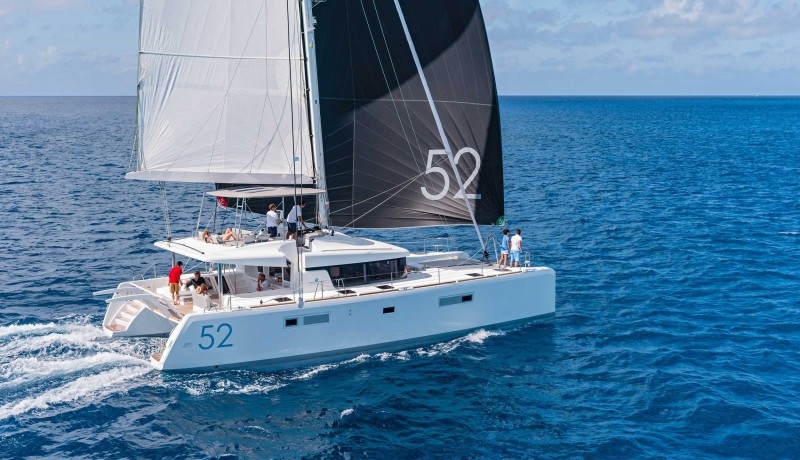
How Fast Are Catamarans Compared To Other Boat Types?
There are two main factors that determine the speed of ships. The first one is the hull type. There are hulls that stay beneath the water more or less than others. But, keep in mind that the less the hull is underwater, the faster it can go. This is due to the fact that the less of the hull underwater, the less the drag created when sailing. The other factor is the length of the boat. And, reasonably, the longer the boat, the faster it can go. Every boat has a maximum hull speed that can’t be exceeded. This can only happen in case the boat can plane on the water’s surface or be lifted on hydrofoils. For most boats, the longer the boat, the higher the maximum hull speed is.
Sailing catamarans typically average about 10 knots while pontoon boats average about 16 knots. As for powerboats, they can average anywhere between 30 and 50 mph. Most average sailboats are designed with monohulls and they average from 6 to 9 knots depending on wind conditions. Generally, sailboats average between 8 and 12 mph, again depending on weather conditions. This includes mono-hull between 6 to 8 mph and cats or trimarans between 9 and 10mph.
Speed and Comfort Considerations For Cats
You have a lot of choices if you choose to buy a catamaran. You have the option of prioritizing speed or comfort. After you’ve decided to buy a catamaran, the type of catamaran you can consider is determined by where you’ll be using it and what you’ll be doing with it. In addition, make sure that you look at what type of water you will be traveling in, your crew members, and what type of speed you want to achieve.
Storage is an important consideration to make before purchasing a catamaran. Due to the beam, or width, of a catamaran versus a regular mono-hull vessel, you are often charged for two slips if you wish to store your boat in a marina. Moreover, catamarans are a great option for those who get seasick because they have a more stable ride and more open air space. You have more windows and visibility since the living quarters are not within the hull and below the water’s surface.
Sailing and power catamarans are both great choices. In addition, for low winds or conditions such as docking in a marina, sailing catamarans may be equipped with backup power engines. Twin-engine catamarans can have more power and precision than mono-hull vessels.
>>Also Read: How Fast Can Sailboats Go?
Main Advantages of Catamarans
- Space! If you want to opt for more interior and exterior space then the two separate hulls of a catamaran can often double the amount of social space than a monohull of the same length.
- Catamarans are far more stable than monohulls. For this reason, they don’t heel when sailing, and are less prone to rocking when at anchor. This factor also contributes to comfortable sailing.
- Catamarans have a shallow draft which allows them to enter shallower areas. Keep in mind that in the South Pacific, most lagoons are 6 to 8 ft in depth. This depth doesn’t allow for monohulls to enter, but a catamaran can easily enter these areas.
- Stability is another big plus of cats. A cat isn’t that susceptible to the effects of wave action and it also doesn’t heal the way a monohull does. Therefore, it’s much easier to walk around on deck and within the interior of the cat while underway.
- In terms of speed, and mostly for downwind sailing , cats are faster than monohulls. This particularly applies to downwind runs, reaches, and broad reaches.
- More light, customizable, and airy living area. On a catamaran, the living space is usually situated in the middle of the boat and built on the bridge deck. But, in a monohull you go down into the hull where it is darker and less airy.
- More storage space and room for extra systems, provisions, and general sailing equipment. These may include air conditioning, heaters, oven, watermakers, generators, larger fridges, and freezers, etc. And, if you’re a liveaboard, then living on a cat is far more comfortable than living in a sailboat. You have more interior, exterior, and storage space as well as stability and speed in terms of sailing performance.
- Many modern cats have flybridge helms. And of course, no monohull achieves this visibility from the helm provided on most modern catamarans.
- The galley, main salon, and cockpit are all located on one level , above the waterline.
- Because the majority of living space is above the waterline , there’s a better flow of ventilation on a cat making the need for air conditioning somewhat less important during the daylight hours.
- When you plan to set sail, you almost never have to rush around stowing stuff or using bungee cords to hold things in place. Except in relatively rough waters, most things stay put.
- Since catamarans lack a large, heavy keel filled with lead, they can float even if they’re holed. Production cats are constructed with so much buoyancy that sinking them is nearly impossible.
- Catamarans are usually easy to dock because you have two motors and two rudders. Additionally, there’s also no need for a bow thruster.
- Most catamarans are able to turn 360 degrees within their own length.
Average Sailing Speed of Catamarans
| Sport Catamarans | 30 knots |
| Cruising Catamarans | 15 knots |
| Racing Catamarans | 45 knots |
| Power Cruising Catamarans | 70 knots |
| Swath Catamarans | 30 knots |

How Fast Do Catamarans Sail? – The Bottom Line
Bear in mind that not all catamarans are created equal. In other words, catamaran speed is relative. The most important benefit of the speed of a multihull is the ability to outrun bad weather. Meaning that you’re able to average 9-10 knots on a catamaran rather than 6-7 knots on a monohull. Subsequently, this will give you more options in your strategy to avoid bad weather. In general, sailing catamarans typically average about 10 knots. Higher maximum and average speeds are what makes cats distinguish as well as their stability. These are the most important characteristics which makes many sailors prefer cats rather than monohull boats.
Peter is the editor of Better Sailing. He has sailed for countless hours and has maintained his own boats and sailboats for years. After years of trial and error, he decided to start this website to share the knowledge.
Related Posts
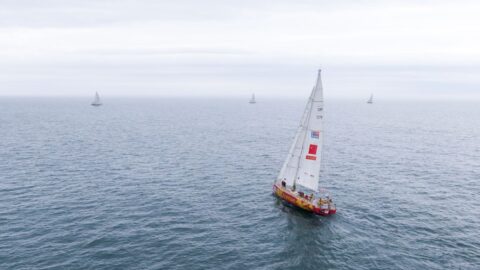
Atlantic vs Pacific: Which is More Dangerous for Sailing?

Lagoon Catamaran Review: Are Lagoon Catamarans Good?
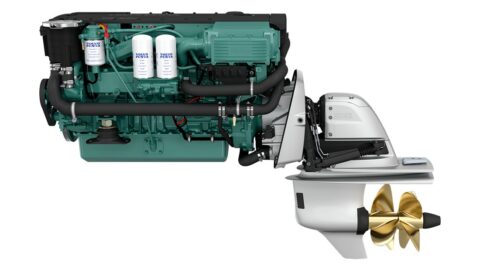
Best Inboard Boat Engine Brands
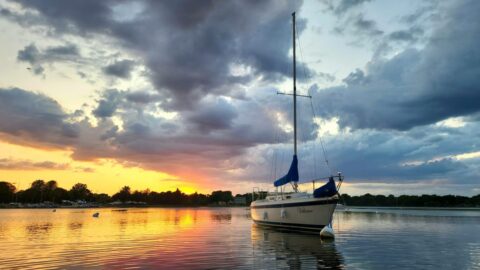
Are O’Day Sailboats Good? A Closer Look at a Classic Brand
- Buyer's Guide
- Destinations
- Maintenance
- Sailing Info
Hit enter to search or ESC to close.
Yachting World
- Digital Edition

5 expert tips for catamaran racing
- November 7, 2024
Performance catamaran racing is growing hugely in popularity. Helena Darvelid shares some key learnings with Andy Rice

Modern cruiser/racer multihulls have a high level of safety provided you know what you’re doing. Helena Darvelid has taken all of her experience from world record-breaking passages in all-out speed machines and applied that to the slightly less frenetic world of multihull competition in big races like the RORC Caribbean 600 and the Rolex Fastnet Race, where Allegra has won the division in the past two editions into Cherbourg.
Poor choices often come down to over-optimistic sail selection which can put the boat in jeopardy, but with planning and a good understanding of how the boat performs across the range of wind and wave states, almost any situation is manageable.
“Since the start of the year we’ve done about 11,000 miles on Allegra, from Mallorca to the Canaries, the Transat, the Caribbean 600, Newport Bermuda Race and back to Mallorca,” says Darvelid.
“The windy races are the ones that stand out, including the past two Rolex Fastnet Races and last year’s Gotland Race, because that’s where I’m from [Helena is Swedish].
“We had 40 knots of wind and peak speeds of over 35 knots which felt amazing.
“Once you have a team that knows what it’s doing, you don’t have to feel intimidated by big conditions, you can really enjoy it.”
Here are Helena’s five tips for keeping it safe and fun while pushing to the limit on big, powerful multihulls.
Rehearse safety plans
We always go through the safety procedures on the boat, knowing where to locate all the safety equipment. In the case of a capsize, what would you do, and in what order? Where are you going to keep your lifejacket? If the boat is upside down and you have to get through an escape hatch, you don’t want to end up on the upturned boat without your lifejacket, so make sure it’s readily accessible.
We always throw in a ‘surprise’ man overboard drill for every race, just in case we have someone new on board. Make a habit of going through the whole routine each time for every major passage you do.
Article continues below…

Best catamaran and multihull: We sail the very best yachts on two and three hulls
There are many categories in the European Yacht of the Year awards, from the best luxury yachts and performance yachts to the best yachts for families and event a best…

What’s it really like to go from a monohull to a catamaran? A liveaboard cruiser’s lessons learned
For over a decade, my wife, Rachel, and I lived aboard what could aptly be described as a traditional bluewater…
Stay two steps ahead
Always aim to stay two or even three steps ahead. Anticipate everything that’s likely to happen next. Basically, in any manoeuvre, we’re always ready.
Allegra is a big boat with a large central structure, so we can’t see each other. We have six comms headsets for the key positions: the pit, bowman, trimmers, race skipper, and navigator.
Communication between the crew is vital during the preparation and execution of manoeuvres, but sometimes you can have too much chat which can create confusion. That’s why you need to talk through all the manoeuvres beforehand so you’re only saying what needs to be said. We also have a ‘No comms’ backup mode in case of comms failure or the need to execute a manoeuvre before everyone is geared up.
Stay in position
Everyone knows their position and what’s required. We’ve practised beforehand, so you go to the same position every time, even if you’re off watch. If it’s an overnight race or a long one like the RORC Caribbean 600, then there’ll be an off-watch and if you have a key person asleep, you wake them up, and everyone goes to their positions instantly. It then only takes a few minutes to take a reef or do a headsail change.
We never leave someone asleep to give them extra rest if they’re needed in position. Everyone has to be involved in the same way each time. But the watch system needs to be flexible to cater for the course requirements.
On busy courses we’ll run a buddy system where two people of similar skill sets cover each other in their own watch system and make sure that their double is well slept, fed and watered so that there’s always someone with that skill on deck and in good shape.

Allegra racing in the Rolex Fastnet Race. Photo: Rick Tomlinson/RORC
Set up for speed
Going faster is quite often safer and more comfortable in multihulls so set your rig up for that. You need to ‘lean’ on the boat to make it ride predominantly on one hull – as opposed to having multiple hulls wracking between different waves.
It’s difficult to set hard and fast rules on what to change when, because so much relies on the particular boat, your angle to the wind and how gusty and shifty the breeze is.
One of the biggest considerations about sail plan is your angle to the waves and what kind of wave sets you’re dealing with. If in doubt, going smaller is the safe option although do first try all the de-powering options such as twisting, easing, traveller down, daggerboards up etc.
Where the opposite is sometimes the case is when you’re going downwind in light airs and you’ve got a choppy wave state to punch through. Here you’re looking to head up the boat onto a hotter angle and put more power into the sails to give you momentum through the chop.
With catamarans the sea state can make the boat’s rolling action quite sharp as the hulls ride on different troughs and peaks. This in turn shakes the wind out of the sails making them only really effective for smaller windows. Sailing higher creates more apparent over the sails and helps them fly longer. Your polars won’t tell you this.
Know your exit strategy
When you’re beam reaching in strong winds be aware of the ‘death zone’ where the high levels of apparent wind that you’re generating can exceed the righting moment of the boat.
This is potential capsize territory, so always know what your exit strategy is at any given moment when a gust hits. Are you going to bear away or luff up? The skipper should communicate what the plan is so everyone understands what’s going on and can anticipate what the rest of the team is expected to do.
If you need to exit by heading up, make sure the sails are trimmed to enable this. You still want drive in the main as this will be the sail that helps spin the boat into the wind. If you have the headsail pinned in and the main doing nothing, then the rudder will be less effective turning the bow up.
Ideally, in overpowering conditions where you’re achieving stability limits, you should have both sails on the edge or already beginning to luff. This leads to a neutral helm and means that as soon as you start coming up, the luffing increases on both sails and the boat depowers quickly from the head down.
If you enjoyed this….
Yachting World is the world’s leading magazine for bluewater cruisers and offshore sailors. Every month we have inspirational adventures and practical features to help you realise your sailing dreams. Build your knowledge with a subscription delivered to your door. See our latest offers and save at least 30% off the cover price.
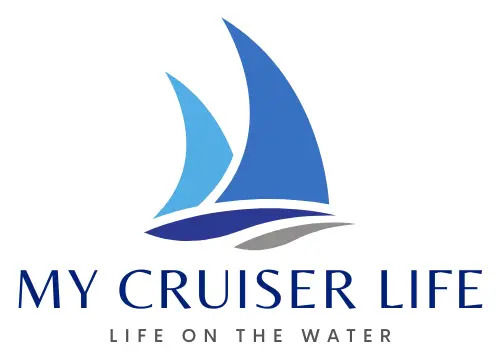
My Cruiser Life Magazine
Sailing Catamaran Speed
You’ve probably heard that one of the best reasons to get a catamaran is because they’re fast. After all, there’s a race any time there are two sailboats on the same waterway.
But like all things in boating, speed is a relative term. Catamarans seem fast to those coming from slow and heavy monohull sailboats, but cruising catamarans are still pretty slow vessels. There are indeed high-tech racing catamarans breaking speed records all the time. Still, the vessels that most liveaboard cruisers venture out on are only slightly faster than their monohull counterparts.
For this article, we will look at the types of catamarans people live on and cruise on. Forget about those fantastic America’s Cup yachts or those multihull go-fast fishing boats for a few minutes.
I have had experience cruising and living aboard both catamarans and monohulls. For five years, my wife and I enjoyed catamaran sailing on a Lagoon 380. We then switched—for many reasons—to a Cabo Rico 38. The Cabo Rico is a traditionally-designed monohull with a full keel and a heavy displacement. In other words, it’s about as far away from a “speedy” catamaran as one can get.
Table of Contents
How fast can a catamaran go, measuring catamaran speed, catamaran speeds vs monohull speeds, sailing cruising catamarans, performance cruising catamarans, racing catamarans, power cruising catamarans, catamaran top speed, faqs – how fast are catamarans.
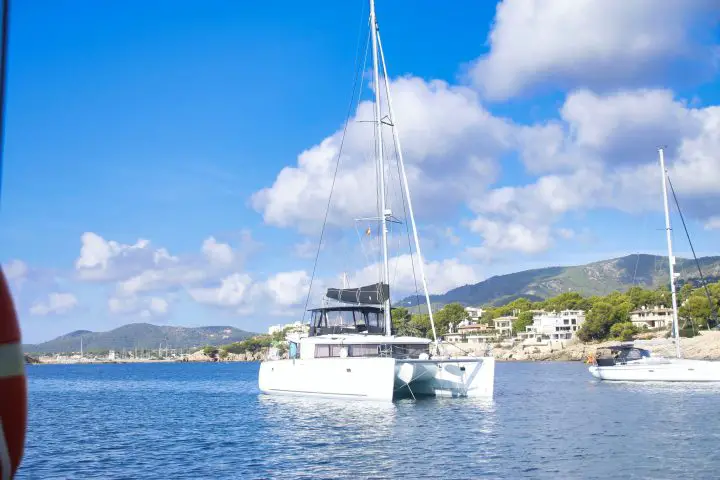
There’s no doubt that catamarans are some of the fastest sailboats around—but there’s also a lot of misinformation and misunderstanding online about how fast they really are.
Realize that not all catamarans are created equally. There are cruising catamarans built to carry their passengers in comfort. And then there are racing catamarans built for nothing but speed. Somewhere in between, there is a poorly-defined category of “performance cruising” catamarans that stir passions.
So, are catamarans fast? Well, it’s all relative. But, if you compare them to monohull sailboats of similar sizes and capabilities, the catamarans are usually faster for several reasons.
The speed difference is even harder to measure in the cruising catamaran category. One of the reasons catamarans beat monohulls during races is because they are built light with no ballast. But a heavily-laden cruising cat ready for an ocean crossing is hardly “lightly loaded.” Will it still beat a similarly heavily-laden monohull? Sure! But probably not by as much as you might think.
Boats measure their speed in knots. Traditionally, this was measured by a tool known as a knot log. The modern equivalent is an underwater instrument with a spinning wheel that effectively measures the speed of the water passing over the hull. So long as no currents are present, that speed will equal the boat’s speed over the ground (SOG).
Satellite navigation allows us to measure our SOG more accurately, but this isn’t a great indication of boat performance since it will be affected by tides and ocean currents.
For landlubbers, one knot is equal to about 1.15 statute miles. So, in other words, when we say that a sailboat cruises at 6 knots, it means it’s going about 7 mph.
But before going any further, consider this—the maximum speed that a sailboat makes is generally a pretty meaningless number. Maybe the knot log pegs to 13 knots for a few seconds, thanks to a strong gust of wind while you’re headed down a large swell. Does this mean you’re driving a 13-knot boat?
A voyaging sailor who has made a long passage will have little interest in this sort of number. When you’re crossing oceans, what really matters is how many miles pass under the keel each day. The more miles you tick off, the shorter the passage. So most sailors learn quickly to look past the “fastest speed in knots” number and find real-world stats on passage miles.

Comparing speeds between radically different sailing vessel hulls is like comparing apples to oranges. Even seemingly similar boats, like “cruising sailboats,” the differences between one and the other are endless.
For example, let’s say you wanted to compare 38-foot monohulls to 38-foot catamarans. The speed of a monohull is limited by waterline length, which means you’d have to look at a hull that is significantly more than 38 feet in most cases. On the other hand, the catamaran is known for long swim platforms on inverse transoms and plumb bows—meaning most 38 foot cats have nearly 38 feet of waterline.
Then, what sort of hull design makes a fair comparison to a catamaran? Would it make sense to compare a transitional, salty 38-footer with a full keel? Probably not. Most sailors interested in the cruising catamaran lifestyle would more than likely be comparing it to a modern monohull with a flatter bottom, fin keel, and spade rudder.
What about the catamaran? There’s a lot of variation in the catamaran field regarding performance. If speed is your goal, you likely want to compare the high-end performance brands—Outremer, Gunboat, HH, and the like. These boats are becoming more popular, but most cruising cats you see on the water are not performance models. Instead, they are the big and comfortable cruisers made by Lagoon, Leopard, or Fountaine Pajot.
Finally, how can you fairly compare the stats? Boats sail differently in different wind speeds and at different points of sail. In other words—there are a lot of variables that make it hard to answer the question, “How fast can a catamaran go?”
Polar charts for each vessel can provide some clues to make a somewhat fair comparison. Polar charts are graphical plots of a sailboat’s performance in different wind conditions and at different points of sail. Manufacturers seldom publish since no two are ever perfectly alike. They are less of a boat specification and more of one sailor’s results for a particular boat. Most owners make their own polar diagrams, but they’re still a tool for those looking to get an idea of a model’s performance in the real world.
Speeds of Various Types of Sailing Catamarans
There are several distinct catamaran classes, and predicting speed means understanding what the designers were building the craft to do. You might be surprised to learn that the first “modern” catamarans popped up in the New England racing circles in the late 1800s. Nat Herreshoff’s Amaryllis is particularly famous from the time .
Since then, catamarans have been synonymous with speed. But in today’s world of many different multihull designs, it’s important to set your expectations accordingly. As you would not buy a Ferrari for its cargo space, don’t expect your minivan to win any races at the track.
Examples of cruising cats include popular models made by the big-three catamaran makers—Lagoon, Fountaine Pajot, and Leopard. However, there are dozens of other companies making these boats. The market and industry for cruising catamarans have never been larger.
Most of these boats are engineered to provide comfortable accommodations for voyaging. They first became famous as vessels for sail charter holidays, where their huge cockpits and private cabins made them much more popular than the smaller and cramped monohull options.
As a result, they’re not built with high-tech components or super lightweight performance rigs. Instead, they’re the catamaran equivalent of a Hunter or a Catalina sailboat—mass-produced on an assembly line. That keeps prices lower than other types of catamarans, but it also means that they’re not winning any races. The makers use traditional layups with end-grain balsa-cored fiberglass to keep costs down. In addition, they usually feature stub fin keels, which are foolproof to sail but will not provide the upwind performance of a lift-making daggerboard.
Still, without ballast and when lightly loaded, cruising catamarans can move. They show their colors in light air when heavy displacement-hulled sailboats usually make their poorest showing. Since these moderate conditions also make for great cruising, these boats can provide a lovely ride in smooth weather.
Cruising catamarans can’t plane or anything, but their narrow hulls create an effect that means they can beat the hull speeds of a similarly sized monohull. Of course, it’s not a precise number since every boat and crew is different, but generally, you could expect speeds to be about one and a half times that of a same-sized monohull.
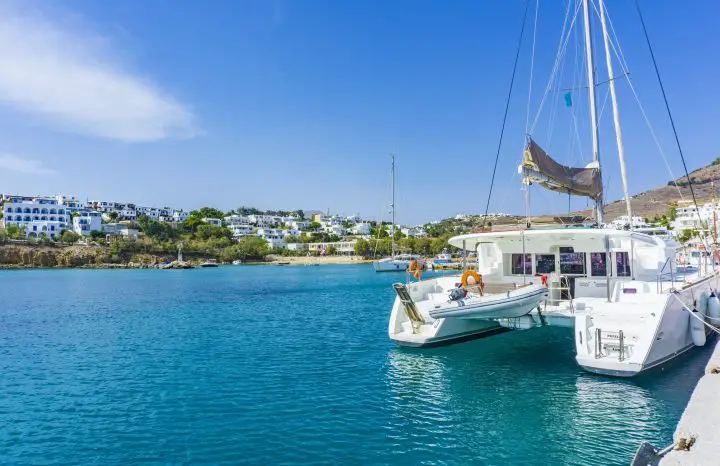
These catamarans are still rigged for comfort, but they’re built using the highest-quality and lightest-weight materials. While their hulls are rigged for comfortable living, they are generally designed much sleeker than regular charter-style cruising catamarans. The hulls are narrower, and you’re unlikely to see tall flybridges or forward lounge seating.
Several companies are making these boats. But in the world of catamarans, a performance cruiser is the upper end of the market. If you want a car comparison, Lagoons are something like a Chevy sedan, whereas an Outremer is like an M-series BMW. A Gunboat would be even more exotic, like a Ferrari. Not only are they more fashionable brands, but they’re also made to higher standards with cutting-edge designs .
It’s also worth noting that the category of “performance cruising cat” is a sliding scale. Some companies make vessels with better materials and craftsmanship than the cruising cats but aren’t designed for speed. Others build cats that are all about performance with few amenities.
With every new model, companies building these cutting-edge boats are attempting to boost the “performance” and the “cruising” aspect of their vessels. As a result, amenities and speed continue to get better and better.
Any racing sailboat is not designed for comfort. Especially on a catamaran, accommodations take up space and weigh the boat down. True racing vessels are designed to not worry about the crew but optimize every element for speed. Once the boat is designed for the desired performance, they’ll squeeze in bunks and storage wherever they can.
As such, there’s not much point in comparing them to liveaboard or cruising sailing vessels—they are too different. Some modern racing catamarans even fly above the water on foils. This makes for a high-speed boat and a considerable risk for sailors traveling for pleasure. Gunboat tried to make a foiling cruising cat in the G4 model, but it didn’t go so well for them.
Power cats run the same gamut of designs that sailing catamarans do. Power catamarans and sport catamarans designs are popular in powerboat circles for the same reasons they are in the sailing world–their hull designs allow for smaller underwater profiles and high speeds. There are many fast catamarans out there with twin engines and average speeds of well over 70 knots. Most recreational vessels cruise at about 20 knots, however.
Power catamarans also offer a smooth ride, making them a popular choice for large vessels like passenger ferries. There are even military vessels that use two hulls, like the stealth M80 Stiletto .
As you can see, catamaran speeds vary from just slightly better than monohulls to extraordinary flying machines. But cats are about much more than just speed. Their open and bright living space makes living aboard an entirely different experience than living on a monohull. Their cockpits flow into their salons for a full-time outdoor living feel that no other type of vessel can match. There are many reasons to choose a catamaran as a liveaboard sailboat.
How fast is a catamaran?
The answer depends on many other questions, like what sort of catamaran is it? And if it’s a sail cat, how fast is the wind blowing?
Sailing catamarans come in all different shapes and sizes. Some are optimized for living space and comfort, while others are designed with fast cruising speeds being the sole goal of the boat. The Gunboat 68, one of the fastest cruising sailboats currently made, can exceed 30 knots.
The world of power cats is much the same. Some power cats can do well over 70 knots, while most cruising boats top out at around 20 knots.
Do catamarans have a hull speed?
A hull speed is a characteristic of traditional displacement-hulled sailing vessels. The properties of the hull shape under the water create drag that limits the overall speed that the vessel can achieve. Even if you keep adding more power (or more wind), the vessel cannot exceed its designed hull speed for any length of time. Hull speed is a factor of waterline length.
Multihulls, however, have an entirely different underwater profile than monohulls. Their narrow hulls and shallow keels mean that drag is not the limiting factor. With this in mind, designers can tweak catamaran hulls to plane and cruise well above the hull speed of a similarly sized monohull.
What is the fastest cruising catamaran?
The market for fast-moving cruising cats has never seen more innovation than in the past decade. This type of boat has taken off, spurred in part by new designs and the overall popularity of multihulls for cruising. The industry leader in fast multihulls is generally considered the French-based company Gunboat . After all, one of the company’s mottos is “Life is too short to sail a slow boat.”
The company’s largest boat to date is the Gunboat 90 Sunshine . However, the delivery of the company’s current flagship, the Gunboat 68 Condor , from France to St. Maarten, provides some real-world numbers. In the delivery crew’s words, “Our max speed exceeded 30 knots a couple of times, and the max 24-hour run was 328 nm.” To save you the math, that works out for an average speed of 13.7 knots for their best day.
Matt has been boating around Florida for over 25 years in everything from small powerboats to large cruising catamarans. He currently lives aboard a 38-foot Cabo Rico sailboat with his wife Lucy and adventure dog Chelsea. Together, they cruise between winters in The Bahamas and summers in the Chesapeake Bay.
- Boat Reviews

- Industry Directory
- Boat Accessories & Bling

The pleasure of living on board: A closer look at the Excess 13 catamaran
Since its debut in 2019, Excess has swiftly risen as a sought-after brand in the world of catamarans, drawing sailors with its unique blend of modern design, comfort, and performance.
As part of the prestigious Beneteau Group, Excess focuses on providing catamarans ranging from 11m to 15m that promise more than just a functional experience—they’re created to bring the joy of life on the water to every sailor on board. The latest in their line, the Excess 13, set to debut at the International Multihull Show in La Grande-Motte, France, in April 2025, exemplifies this commitment. With thoughtful innovation in every detail, it’s designed to resonate with sailors seeking connection with the sea, and it promises to capture imaginations and hearts alike.

The Excess 13 catamaran is a statement in balanced design, harmonising luxury with function, and tradition with modernity. Developed in collaboration with VPLP Design and naval architect Eric Levet from Marc Lombard Yacht Design Group, the Excess 13 captures the essence of what it means to sail—and live—on a modern catamaran. Levet describes the vision behind the project as “simple yet ambitious,” aiming to combine smooth, reliable performance with comfort and spacious living. For boaters who yearn for both thrills and ease, the Excess 13 is a dream realised.

An exterior that connects you to the sea
Step on board the Excess 13, and it’s clear this isn’t just another catamaran. With an overall length of 15.3 metres, this sleek vessel takes design cues from its predecessors while introducing new features aimed at reducing weight and enhancing responsiveness. Built around a “less is more” philosophy, the Excess 13 embraces simplicity and moderation, evident in both its structure and functionality.

The asymmetrical hulls, which have become a signature feature of Excess, contribute to its agile handling and sleek silhouette. The vessel glides effortlessly through the water, thanks in part to hull refinements and a carefully designed composite structure that enhances buoyancy and reduces drag. The rig, especially in the Pulse Line version, offers a high aspect ratio that boosts performance, making the Excess 13 a joy to sail whether you’re cruising the coast or embarking on an ocean passage.

One of the standout features is the fold-down sugar-scoops at the stern, providing easy access to the water—ideal for everything from diving to wing foiling. This innovative setup gives you a connection to the sea that few other catamarans can match, letting you interact with the water at every anchor and allowing the boat to double as a platform for all your favourite aquatic activities.

An interior that feels like home
Inside, the Excess 13 doesn’t just offer the basics; it’s thoughtfully designed for living. Jean-Marc Piaton, the interior designer, created a layout based on extensive interviews with potential buyers and brand enthusiasts. The result is an interior that speaks to the heart of what a catamaran should be: spacious, functional, and welcoming.

The saloon is bathed in natural light, and large windows offer a panoramic view of the surroundings, making you feel part of the seascape even when you’re comfortably indoors. The galley opens onto the cockpit, blending indoor and outdoor spaces, perfect for entertaining or simply enjoying a quiet meal with the family. For those who need a workspace on the water, there’s a clever desk area in the owner’s hull, offering a private and serene corner to get things done—whether that’s charting your next course or catching up on work.

The Excess 13 caters to various needs with both three- and four-cabin configurations. In the 3-cabin version, the owner’s hull offers a luxurious queen bed, a full headroom closet, and a naturally lit desk.

In the other hull, spacious guest cabins with private bathrooms ensure guests feel just as at home. With ample storage throughout, you can bring all the essentials—and a few luxuries—along for the journey without feeling cramped.

Innovative and eco-conscious design
The Excess 13 doesn’t just make an impression with its style; it’s also engineered for sustainability. In line with its “less is more” design philosophy, Excess has worked to minimise the environmental footprint of this model. A rainwater recovery system on the coachroof, for example, channels water to an onboard tank, reducing the need for shore-based supplies. Ventilation has also been optimised, helping cut down on air conditioning requirements, making the Excess 13 as efficient as it is luxurious.

The interior features dual-function doors that serve both as entrance and closet doors, freeing up space without adding unnecessary weight. Little touches like these reflect Excess’s commitment to smarter, more sustainable design that doesn’t sacrifice the comforts that make life on board enjoyable.
Performance that puts you at the helm
True to the Excess spirit, the Excess 13 offers an invigorating sailing experience. The twin helm stations are close to the boat’s centreline, giving you immediate feedback from the sea, which enhances the sailing experience and provides an intuitive feel as you guide the vessel. With a low boom and an accessible sail plan, trimming and adjusting sails is made easy, even for those with limited experience.

Equipped with self-tacking jibs, Dyneema steering cables for responsiveness, and a comfortable helm seating arrangement, the Excess 13 provides ample control for both novice and seasoned sailors. The cockpit seats six to ten people comfortably, making it an ideal spot to gather and share the view or join in on the action.

The perfect blend of lifestyle and sailing adventure
The Excess 13 stands out as a truly versatile vessel, combining the lifestyle comforts of a high-end yacht with the excitement of a performance catamaran. Whether it’s enjoying a quiet moment in the saloon with its panoramic views, hosting friends and family in the spacious cockpit, or tackling the thrills of the open sea, this catamaran is built to offer something special for every type of sailor.

So, if you’ve ever dreamed of a boat that seamlessly blends the pleasure of living on board with the adventure of sailing, isn’t it time to discover what the Excess 13 has to offer?

Weekly Newsletter
Stay up to date with the latest developments shaping New Zealand's Boating world.
Social Media
Follow us on social media to stay in the loop with the latest trends and news shaping New Zealand's boating scene!
Events Worth Adding to Your Calendar
Have an event you'd like to list on Boating New Zealand. Contact us with the details.
Catch all the action of the Louis Vuitton 37th America's Cup , happening from 22 Aug to 27 Oct 2024 in Barcelona, Spain. Follow along with excitement at Boating New Zealand .
Extreme Boats Fishing Tournament , 29 & 30 Nov 2024 in Whitianga
NZ Lure Masters (Catch, Measure and Release competition) , 3 & 4 Oct 2025 , New Zealand wide
Stabicraft Te Anau Manapouri Fishing Classic , 25 - 27 Oct 2025 TBC in Te Anau Manapouri
NZ Match Racing Championships , 14 - 17 Nov 2024 in Auckland
Beneteau Owners Rally , 23 Nov 2024 , Auckland to Kawau
Sir Peter Blake Torbay Regatta , 30 Nov - 1 Dec 2024 at Torbay Sailing Club
Rolex Sydney to Hobart , 26 Dec 2024 starts in Sydney, Australia
New Zealand Sail Grand Prix , 18 & 19 Jan 2025 in Auckland
NZ Millenium Cup , 1 - 4 Feb 2025 at Waitemata Harbour
Toyota Youth International Match Racing Cup , 26 Feb - 4 Mar 2025 in Auckland
PIC Insurance Brokers Coastal Classic , 24 Oct 2025 TBC from Auckland to Russell
JET BOAT RACING
UIM World Jetsprint Championships , 25 Jan -2 Feb 2025 at Wanaka (25 & 26 Jan) and Wanganui (1 & 2 Feb)
2024 Golden Homes NZ Jet Boat Marathon , 2025 dates TBC on Southland Rivers (Oreti, Waiau and Mataura)
National Jet Boat Rally 2024 , 2025 date TBC at Oliver Road, Bendigo (near Cromwell)
WATERSPORTS
Yamaha Rollo's Marine Bridge 2 Bridge , 8 - 10 Nov 2024 Staged on the Waikato River between Cambridge & Taupiri, based in Hamilton, New Zealand
NON-MOTORISED SPORT
Waka Ama - 2025 National Sprint Championships , 12 - 18 Jan 2025 at Lake Karapiro, Cambridge
Waka Ama - 2025 Secondary School Nationals , 24 - 28 Mar 2025 at Lake Tikitapu, Rotorua
NZ Retro Boats Lake Tarawera Gathering , 16 Nov 2024 at Hot Water Beach, Lake Tarawera, Rotorua
Bay of Islands Cruiser's Festival , 20 - 23 Nov 2024 at Bay of Islands Marina, Opua
The New Zealand Sailing Trust 5 Day Sail , 13 - 17 Jan 2025 starting in Auckland
Auckland Boat Show , 6 - 9 March 2025 at Viaduct Events Centre and Jellicoe Harbour, Auckland
The Hutchwilco New Zealand Boat Show , 15 - 18 May 2025 at Auckland Showgrounds, Auckland
Lake Brunner Classic Boats Get Together , TBC Oct 2025 at Moana
Whangārei Maritime Festival , TBC Oct 2025 at the Whangārei Town Basin
International Boat Shows
COMING EVENTS
METSTRADE 19 - 21 Nov 2024 to be held at the Rai, Amsterdam
Antigua Charter Yacht Show 4 - 9 Dec 2024 to be held at the Nelson's Dockyard UNESCO World Heritage Site, Antigua
Boot Düsseldorf 18 - 26 Jan 2025 to be held in Düsseldorf, Germany
New York Boat Show , 22 - 26 Jan 2025 to be held at the Javits Center, New York
Bahamas Charter Yacht Show , 29 Jan - 2 Feb 2025 to be held at Nassau, Bahamas
Houston Boat Show , 29 Jan - 2 Feb 2025 to be held at the NRG Center, Houston, Texas
Dubai International Boat Show , 19 - 23 Feb 2025 to be held at the Dubai Harbour
Miami International Boat Show , 12 - 16 Feb 2025 to be held in Miami
Auckland Boat Show , 6 - 9 Mar 2025 to be held at the Viaduct Events Centre and Jellicoe Harbour, Auckland
Palm Beach International Boat Show , 19 - 23 Mar 2025 to be held along Flagler Drive in downtown West Palm Beach
International Multihull Show , 23 - 27 Apr 2025 to be held in Terre-plein Ouest du port La Grande-Motte (34), France
Palma International Boat Show , 30 Apr - 3 May 2025 to be held at the Superyacht Village, Palma, Spain
Barcaly's Jersey Boat Show , 3 - 5 May 2025 to be held in the Channel Islands
South Coast & Green Tech Boat Show , 9 - 11 May 2025 to be held in Ocean Village Marina, Southampton, Hampshire
The British Motor Yacht Show , 15 - 18 May 2025 to be held at the Swanwick Marina, Southampton, Hampshire
Sanctuary Cove International Boat show , 22 - 25 May 2025 to be held in Sanctuary Cove, Queensland
Sydney International Boat show , 31 July - 3 Aug 2025 to be held at ICC Sydney & Cockle Bay, Darling Harbour
Hiswa Te Water , 3 - 7 Nov 2025 to be held in Bataviahaven Lelystad, The Netherlands
Southampton International Boat Show , 19 - 28 Sep 2025 to be held in Southampton, UK
International BoatBuilders’ Exhibition & Conference (IBEX) , 7 - 9 Oct 2025 to be held in Tampa, Florida
Annapolis Sail Boat Show , 9 - 13 Oct 2025 to be held at City Dock, Annapolis, Maryland
Newport International Boat Show , 20 - 23 Nov 2025 to be held in Newport, Rhode Island
Cannes Yachting Festival , 9 - 14 Sep 2025 at Cannes – Vieux Port & Port Canto
Genoa Boat Show , 18 - 23 Sep 2025 to be held in Genoa, Italy
Melbourne International Boat Show , Oct 2025, TBC to be held at New Quay Promenade Harbour Esplanade Seven Marinas
Biograd Boat Show , Oct 2025, TBC to be held in the City of Biograd, Croatia
Fort Lauderdale International Boat Show 29 Oct – 2 Nov 2025 to be held at several locations in Fort Lauderdale
Monaco Yacht Show , 24 - 27 Sep 2025 on Monacco

6 Best Performance Cruising Catamarans (Buyer’s Guide)
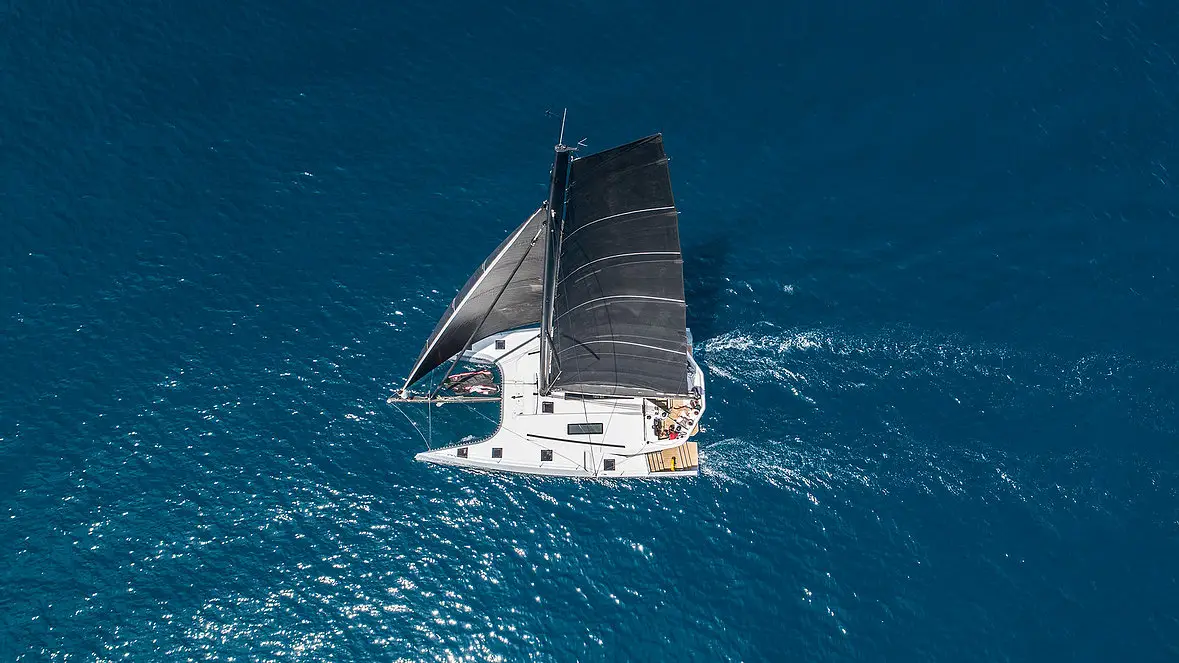
As an Amazon Associate, we earn from qualifying purchases. We may also earn commissions if you purchase products from other retailers after clicking on a link from our site.
Performance cruising catamarans are impressive-looking vessels that focus on speed above comfort. These fast boats are ideal for racing and long cruising vacations. But with the numerous brands and models on the market, how do you know which is the best one?
The best high-speed performance cruising catamarans are the Outremer 4x, McConaghy MC50, Nautitech 44, Gunboat 62, Balance 526, and Marsaudon Composites ORC50. All these boats deliver outstanding speeds and are light in weight, relatively comfortable, and incredibly safe.
This article will explore the brands and models that I believe have the best combination of performance and comfort . We’ll look at their speeds and what makes them cruise so fast. We’ll also examine the factors to consider when shopping for a performance cruising cat.
Table of Contents
How Fast Are Performance Cruising Catamarans?
Cruising catamarans are generally faster than monohulls of similar lengths. This means most well-built and well-balanced cats will arrive at their destination much sooner, and the cruise is much more comfortable. Performance cruising cats like the Nautitech include deep daggerboards and rudders, narrow waterline beams, hull chines, and big sail plans that allow for faster sailing than a standard cruising cat.
| CATAMARAN | SPEED (Knots) |
|---|---|
| Outremer 4X | 20 |
| McConaghy 52 | 22 |
| Nautitech 44 | 17 |
| ORC 50 | 23 |
| Balance 526 | 20 |
| Gunboat 62 | 20 |
| Privilege Signature 510 (For reference) | 13 |
| Fountaine Pajot Astréa 42 (For reference) | 10 |
Outremer 4X
Outremer Catamarans are well-known for their high speeds. These exciting cats sport brilliant designs, narrow bows, and large rigs. Built in Southern France, the vessels are strong and long-lasting since their structures feature materials such as carbon, glass, and vinyl ester.
The Outremer 4x is a stable and comfortable high-speeding cruising catamaran that performs ocean crossings and confronts any weather with remarkable ease. Named the European Boat of the Year in 2017, this 48-foot (14.6 m) bluewater cruiser sails faster than wind speed and attains maximum cruising speeds of 20 knots.
The 4x is an upgrade of the extremely popular Outremer 45, thus retaining Outremer’s core values of speed, safety, and comfort. It’s built for maximum performance and enjoyment, with the lightweight, carbon fiber structure allowing for additional speed under sail .
Featuring comfort typical of much larger vessels, the Outremer 4X features 4 double cabins, hot water showers, a full kitchen, spacious storage, and excellent ventilation. There’s also an expansive deck, an unobstructed cockpit, and large trampoline areas. Most importantly, your safety is assured through the cat’s unique features including a robust structure, offshore design, stability, and unrivaled speed potential.
The 4x’s cutting-edge design makes it ideal for competitive racing or blue water cruising, and it does both without compromising your comfort, safety, or onboard livability. However, to sail at maximum speed, the boat must remain lightweight, requiring your interior to be fitted out quite minimally. The other downside is the high price tag; the Outremer 4X commands a price between $912,322 and $1,202,945 .
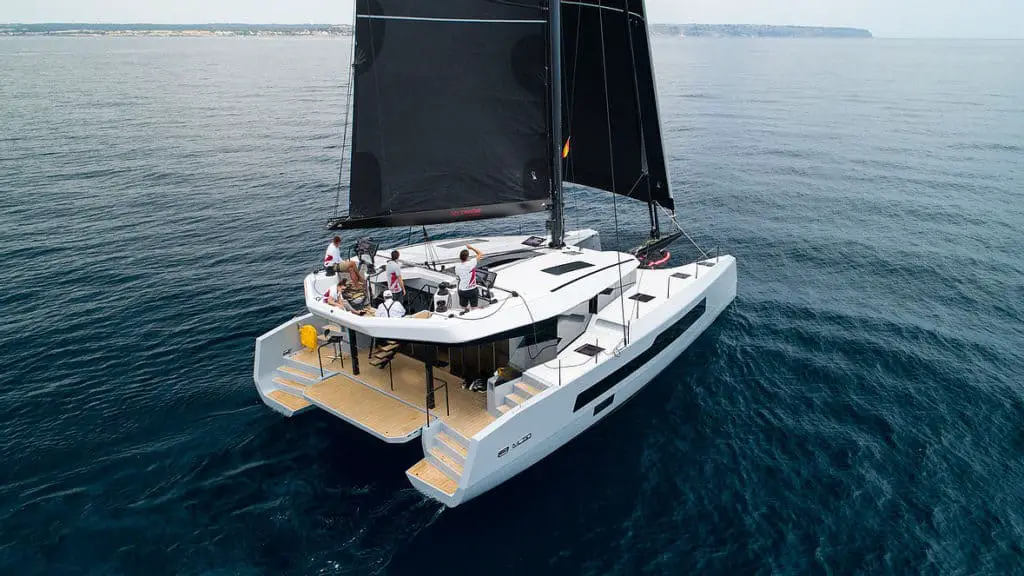
McConaghy MC52
The McConaghy MC52 is a performance luxury cruising cat reflective of McConaghy’s 50 years of experience in building high-tech composite projects. The luxurious boat features a flybridge, retracting centerboards, optimized hulls, and an open space bridgedeck combining the salon with the cockpit. You can also customize the boat to your specifications.
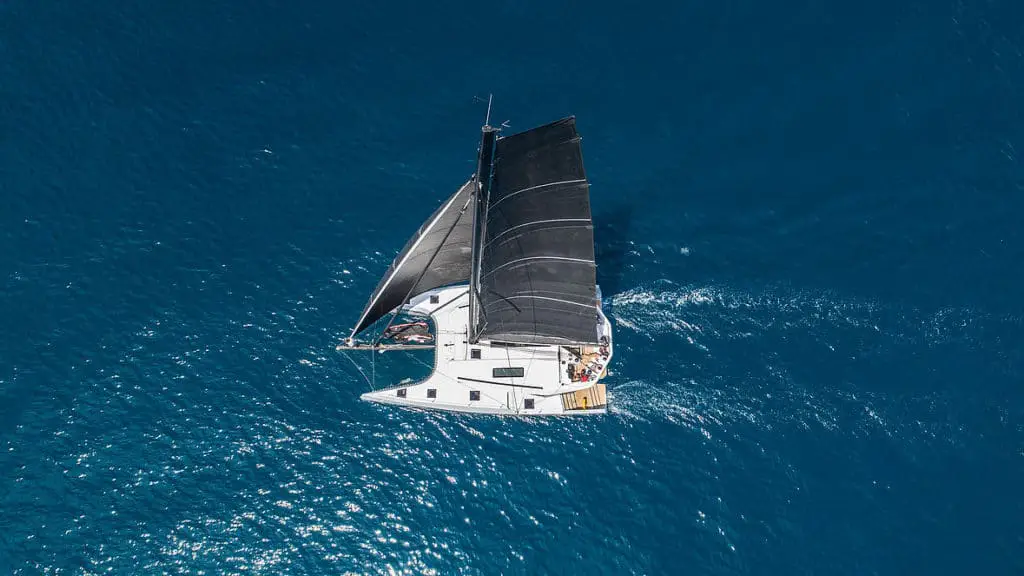
This hi-tech cat comes with sizeable sliding salon windows and frameless doors that provide fantastic views. Its wave-piercing bows can cut through waves, thus helping to increase performance by minimizing pitch resistance, while still retaining a smooth ride. Also, the saloon offers spacious dining space for up to 8 people, and the galley area is more like a penthouse.
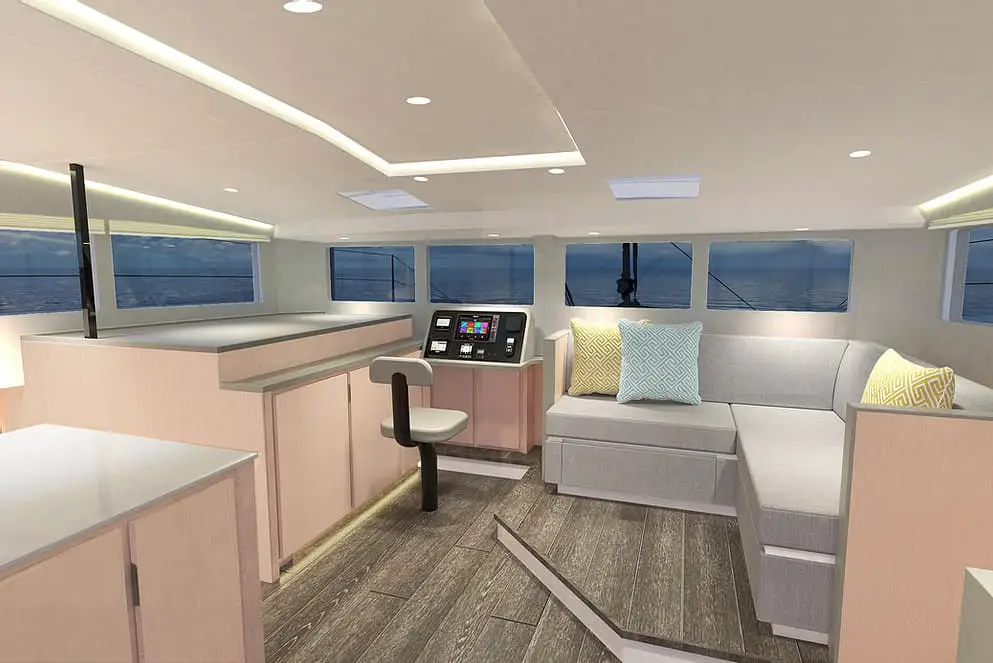
The manufacturer’s background in building high-end racing yachts has resulted in an incredibly strong and lightweight vessel capable of reaching 22 knots (40.7 km/h or 25.29 mph). The main downside to this boat is the boom placement on the mast, which is much higher than other high-performance cats. This makes accessing the mainsail somewhat challenging. It also increases the MC50’s center of gravity and center of effort.
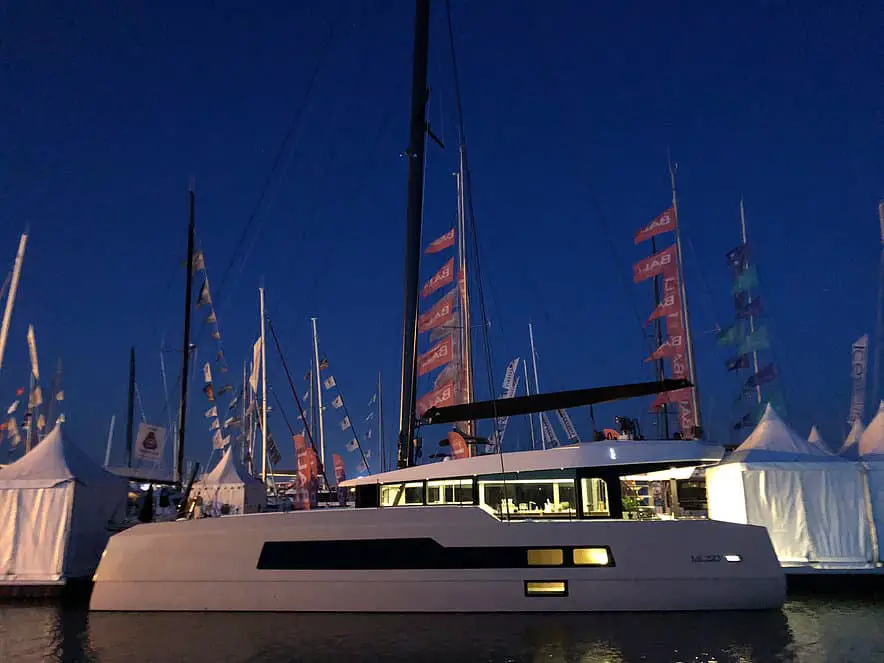
You can get the MC52 for about $1.6 million.
Nautitech 44
The Nautitech 44 easily blends comfort and fun to deliver an impressive sailing performance, whether you take short trips or long ocean crossings. The boat offers a good balance under sail, and it features helming stations on each hull. Plus, there’s an integrated hardtop bimini complete with sunroof opening. Slim hulls translate to higher speeds, with the vessel reaching up to 17 knots (31.4 km/h or 19.51 mph).
The well-laid-out interior boasts a functional design, ample storage space, plus all the equipment you require for ocean cruising, such as a fridge, watermaker, and solar.
Nautitech 44’s twin helms give you the real sailing experience with a fantastic view of the sails and great visibility when maneuvering into port. However, you might not appreciate being stuck in the aft helm position without protection in lousy weather or during hot days.
Nevertheless, the boat’s responsiveness makes sailing more pleasurable. Plus, it’s affordable; the price is between $236,000 and $334,000.
Marsaudon Composites ORC50
Marsaudon Composites vessels are ideal for both racing and cruising. The sporty-looking ORC 50 comes with large inverted bows, an angular coachroof, a high freeboard, and a sturdy rotating carbon mast. In addition, the vessel is light which allows it to accelerate quickly, while the angular coachroof offers lots of space and excellent visibility.
The ORC50 can attain 23+ knots (42.5+ km/h or 26.41+ mph) and is among the fastest high-performance livable multihulls. It’s capable of doing more than 350 miles (563.27 km) per day.
The downside to the ORC50 is it’s a bit technical to sail, thus requiring a skilled sailor. Furthermore, its immense power and speed can be intimidating to less experienced sailors. Solely designed for speed, the ORC50’s interior is simple, less roomy, and somewhat spartan; hence the boat might not be all that comfy. Still, it’ll get you where you want to go pretty fast, and it’s an excellent value for money at approximately $787,751.25.
Gunboat 62
The Gunboat 62 is a true high-speed catamaran capable of sailing at 20 knots (37 km/h or 23 mph) over true wind speeds and known to notch up speeds of 36+ knots (66.7+ km/h or 41.45 mph) on a surf. The initial 3 Gunboat 62 boats featured epoxy, E-glass, and carbon fiber construction, but the fourth vessel was all carbon, sported a taller rig and a more expansive sail area.
These structural features made the Gunboat 62s extremely light, and they formed the original luxury high-performance cruising cats.
This multihull sailboat boasts a carbon mast, round hull sections for a minimized wetted surface area, high-aspect rudders, and retractable daggerboards. The steering station offers 360-degree visibility and sports overhead hatches that you can use to monitor the mainsail trim. The boat also contains 3 private cabins with queen berths, 2 spacious heads with showers, an aft cockpit, galley, and lounge.
On the downside, Gunboats are pricey cats; hence they’re also expensive to maintain. The Gunboat 62 isn’t that spacious either as it’s more focused on speed, but it’s extremely comfortable, plus there’s plenty of space for hanging out. You can buy this catamaran starting from $2 million .
Balance 526
Built with a combination of carbon fiber, E-glass, epoxy, closed-cell foam, and composite bulkheads, this boat is strong, light, and can withstand terrible weather. The retractable daggerboards allow for good upwind performance. All high load areas contain carbon fiber, while furniture and cabinets feature cored sandwich construction, producing the lightest yet most robust catamaran.
A Balance 526 will reach speeds of up to 20knots without stressing the rig too much.
The boat is available in various layouts and comfortably accommodates 6 people. The spacious aft cockpit and saloon provide panoramic visibility. And since Balance 526 can handle the extra weight, you get performance plus all the creature comforts you desire.
Still, Balance 526’s pricing is on the higher end, beginning at $1,440,000 . Also, the slender hulls result in less space down below. Nevertheless, the boat lives up to its name, achieving the perfect balance between superb performance and comfort.
What Makes Performance Cruising Catamarans So Fast?
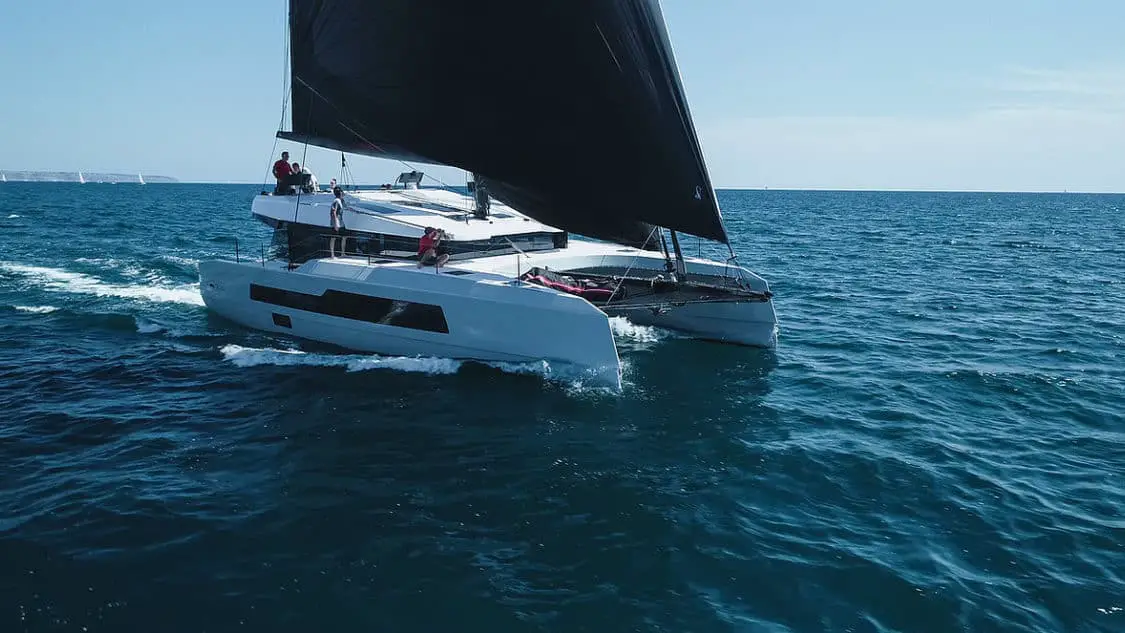
Performance Cruising Catamarans Have Narrow Hulls
Performance catamarans contain two small narrow hulls, which cause them to have less water resistance. Smaller hulls mean the vessels have much smaller bow waves to fight, allowing them to move extremely fast. In addition, the less hull area is underwater, the faster the boat is capable of moving since there’s less drag.
Having said that, it’s important to note that a narrow hull is more prone to burying its bows in rough seas. The wider the hull, the more buoyancy it offers, but only up to a given point. After which, the excessive width becomes unmanageable and performance suffers. The key lies in finding the right balance.
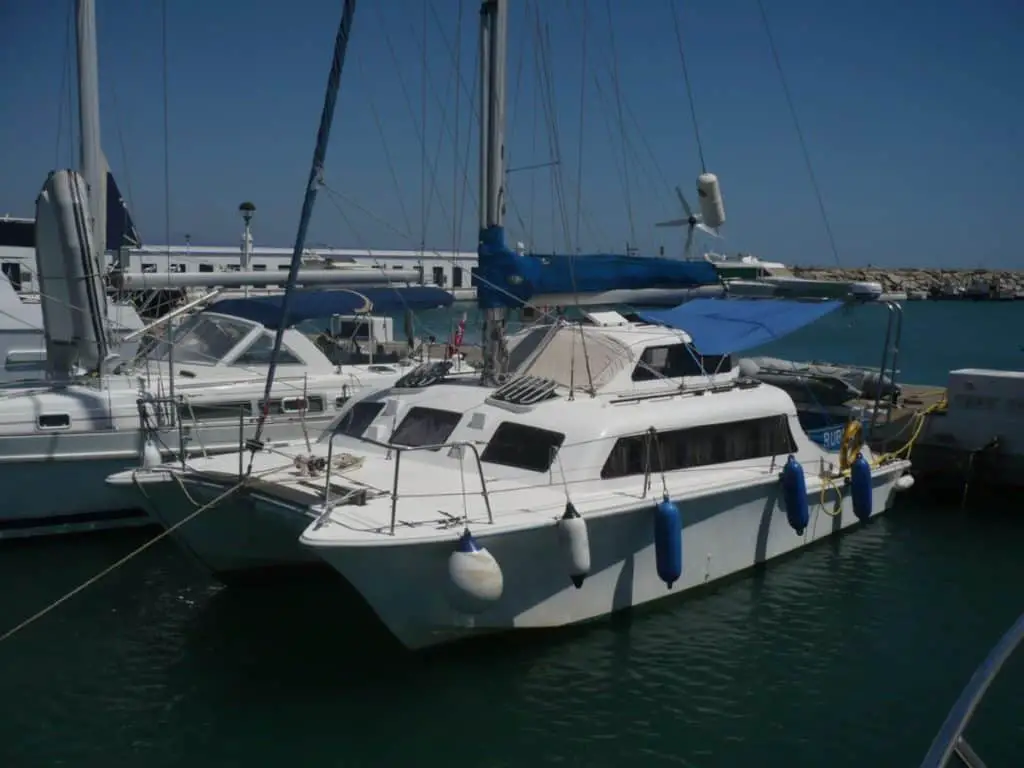
Performance Cruising Catamarans Have Considerable Length
The longer a cruising cat is, the faster it’ll move. While each vessel bears a maximum hull speed, in most cases, the lengthier the boat, the higher the speed it can reach. The length of the hull (length on the waterline) also has a significant impact on the speed performance. Thus, the cat attains maximum speeds when the wavelength is equal to the length on the waterline (hull speed).
Therefore, the longer the length of the hull, the better the performance of a high-speed cruising cat. You can also compare two cruising cats’ speeds based on this measure.
Performance Cruising Catamarans Have Quality Builds
Modern cat manufacturers continue designing more innovative high-performance cruising cats that deliver a new blend of performance and cruising features. They achieve this by using advanced construction materials, better daggerboard designs, and creative weight allocation. They also keep a keener focus on onboard amenities. For instance, asymmetrical daggerboards placed midships in each hull can help achieve proper balance and hull trim.
The overall goal is to design cruising cats that offer high speeds, outstanding performance, and enough offshore comfort.
Here’s an article if you are wondering what daggerboards and centerboards are and why they impact performance so much.
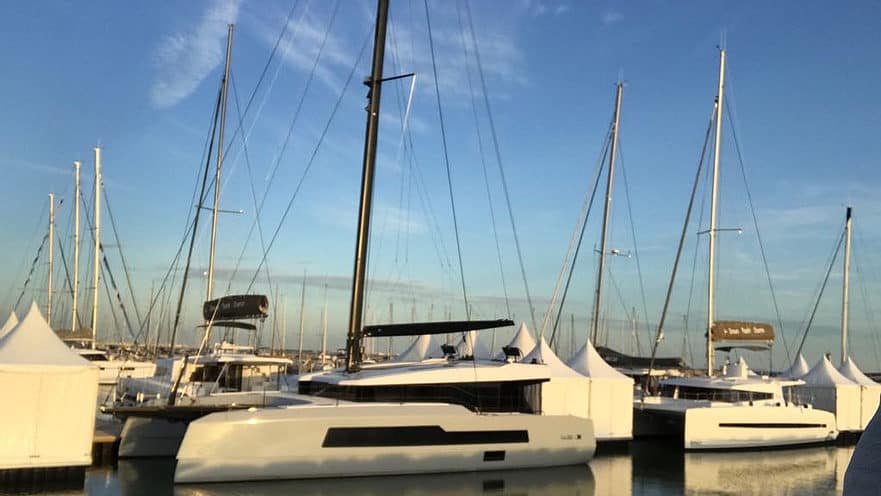
Performance Cruising Catamarans Are Light-weight
The lighter a cruising catamaran, the greater its performance. And some of the most popular high-performance catamarans find an optimal balance between performance and comfort. As a result, modern performance-based cruising cats have embraced the use of carbon composite construction for hulls, daggerboards, and rigging, instead of the somewhat heavier glass fiber materials.
A weighed-down cat produces less speed, which means excess immersion of the hulls renders the boat sluggish . The hull submersion also reduces the bridge deck clearance, promoting uncomfortable hull slamming.
You won’t find much difference in top speed between performance catamarans bearing similar lengths because they all have displacement hulls and mostly sail to hull speed with occasional surfing. This means that under skilled hands, these cats should exhibit roughly the same performance. A cruising cat’s performance is also highly dependent on the state of the sea, wind direction, and speed, amongst many other factors.
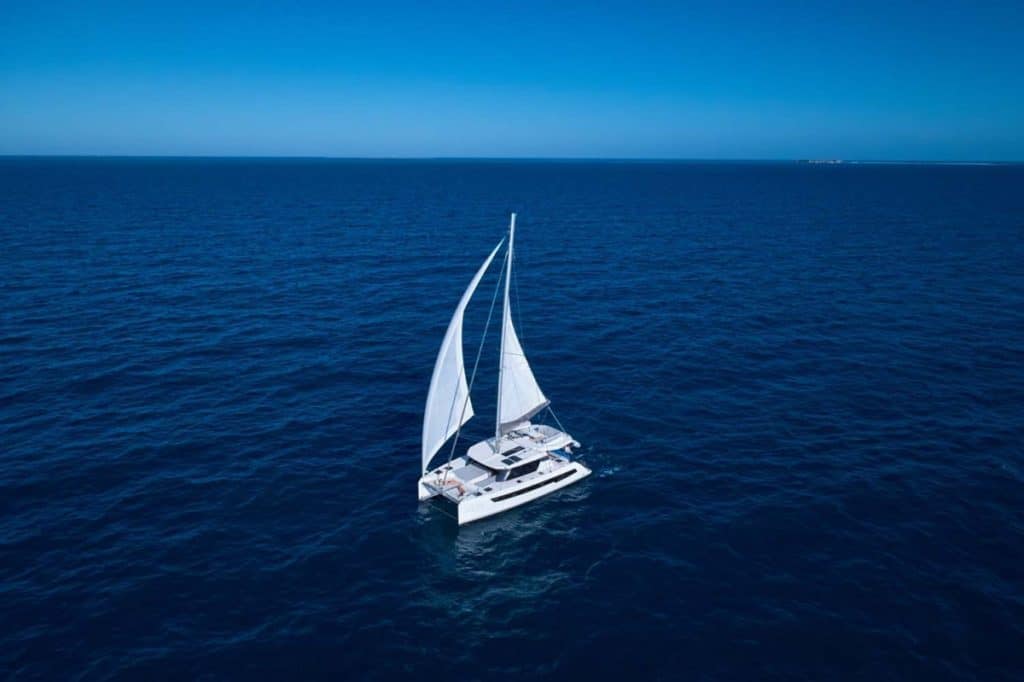
What To Consider When Choosing a Performance Cruising Catamaran
Speed is the number one consideration when choosing a high-speed cruising cat. Yet there are other factors just as important since they contribute to the overall cruising performance, including:
- What you’ll use the vessel for and where. Are you planning on doing coastal cruising or serious offshore cruising? Consider the number of people that you’ll be sailing with and the activities you’ll engage in. This also helps determine the size catamaran you’ll need.
- Comfort. While some racing enthusiasts might prefer spartan accommodation plans, most enjoy relative comfort on the high seas. In any case, modern high-speed cruising cats are designed to provide a certain level of creature comforts. And since most performance cats are custom-made, new boat owners may decide precisely which features to include in their cats.
- Quality. To produce light boats, builders employ the use of fine resins, carbon, epoxies, foam cores, and fiberglass. They build using a combination of vacuum-bagged techniques, foam cores, foam composite bulkheads, and make furniture and cabinetry with cored sandwich construction .
- Livability. One cannot underrate the appeal of sailing in a vessel with no heeling, not to mention the high privacy attained from separate living and sleeping areas. Panoramic views and exceptional deck space for lounging and entertaining are also essential in ensuring maximum cruising comfort. Fortunately, most high-speed cruising cats offer all these features and more.
- Equipment. Sailing upwind is a challenge for cruising cats since they tend to make lots of leeway. To make things easier, high-speed cruising cats come equipped with bigger rigs and either daggerboards or centerboards. However, this also means skilled sailors are required to operate them.
- Cost. Catamarans are generally expensive, but a cat built with longer, leaner hulls and less costly materials can still give an outstanding performance. Such materials include foam cores, epoxy bulkheads, and epoxy resins. Furthermore, it’s not necessary to use only carbon to build a lightweight boat.
Final Thoughts
Performance cruising catamarans are built using exotic, high-tech, lightweight materials to deliver an electrifying sailing experience. And as we’ve seen from the above list, these boats deliver performance plus much more. They’re not only speed cruisers, but they also provide a smooth, comfortable, and enjoyable cruising experience.
So, whichever option you go for – from the luxurious Gunboat 62 to the much more affordable Nautitech 44 – you’re sure to get a boat that suits your needs.
- Wikipedia: Spinnaker
- Wikipedia: High-Performance Sailing
- Yachting World: Fountaine Pajot Elba 45 Review
- Aeroyacht: Catamaran Speed
- Cruiser’s Forum: Nautitech 44…
- Nautitech Catamarans: Nautitech
- Katamarans: Marsaudon Composites ORC50 (TS5) Review
- Outremer USA: New Outremer 4x Performance Catamaran
- Dutoit Yacht Design: Balance 526 Review
- Go Downsize: How Fast Do Catamarans Go?
- Catamaran Guru: The Cruising Catamaran Performance Debate
- The Boat App: The Fastest Cruising Catamarans of 2020
- Sail Magazine: Performance Cruising Cats Set New Standards in Sailing Speed
- Cruisers Forum: Fast Cruising Catamarans – How Fast?
- Lagoon – Inside: The Secrets of a Catamaran’s Performance
- Sail Magazine: 10 Great Cruising Cats
- Cruising World: 40 Best Sailing Catamarans and Trimarans, Cruising Catamarans…
Owner of CatamaranFreedom.com. A minimalist that has lived in a caravan in Sweden, 35ft Monohull in the Bahamas, and right now in his self-built Van. He just started the next adventure, to circumnavigate the world on a Catamaran!
Leave a Reply Cancel reply
Your email address will not be published. Required fields are marked *
Save my name and email in this browser for the next time I comment.
Recent Posts
Must-Have Boat Gear for Catamaran Sailors!
Sailing is probably the most gear-intensive activity I've ever done; there are so many decisions to be made about what gear to buy now, for tomorrow, and what to definitely never buy. The gear on...
6 Best Trailerable Trimarans For Bluewater and Coastal Sailing
Having a boat costs a lot of money, even when you are not using it, marina fees, etc. And once it is in the water most sailors never go very far from their "home marina" and sailing will be somewhat...
672 Wine Club
- Motorcycles
- Car of the Month
- Destinations
- Men’s Fashion
- Watch Collector
- Art & Collectibles
- Vacation Homes
- Celebrity Homes
- New Construction
- Home Design
- Electronics
- Fine Dining
- Cardinale Estate
- Mamsha Palm
- Raffles Hotels & Resorts
- Rocco Forte Hotels
- Treasury Wine Estates
- Tributary Idaho
- Sports & Leisure
- Health & Wellness
- Best of the Best
- The Ultimate Gift Guide
Inside the First AI-Powered Catamaran to Hit the Seas
Rossinavi ai monitors multiple systems, constantly tweaking to make the 140-foot cat super efficient. it even anticipates owner and guest needs., julia zaltzman, julia zaltzman's most recent stories.
- How Jeff Bezos, Bill Gates, and More Tech Billionaires Have Transformed Gigayacht Design
- Why Yacht Owners Are Commissioning Copies of Original Art to Display at Sea
- These Charter Yachts Let You Tag Hammerhead Sharks and Count Spirit Bears for Research
- Share This Article

Rossinavi’s eye-catching Seawolf X is the definition of innovation. The 140-foot aluminum catamaran is the Italian yard’s first multihull. It’s also a hybrid-electric yacht equipped with batteries, electric engines, solar panels, and diesel generators, and is installed with advanced artificial intelligence software to enhance performance as well as the owner’s and guests’ experiences. Robb Report was the first to exclusively tour the yacht following its delivery in August.
The exterior architecture by Fulvio De Simoni Yacht Design—the studio’s second collaboration with Rossinavi following Aurora in 2017—is defined by a low, sleek profile with a smooth curvature of the hull that rises toward the bow. The interior by New York-based Meyer Davis Studio brings natural materials, soft textures and a homely Scandi vibe.
The artificial intelligence system, named Rossinavi AI, hones in on performance and efficiency. It continuously monitors the vessel’s operations, learning from observation and even anticipating guests’ needs. “ [The AI] will be able to self-learn, surely surprising even us in the future,” Federico Rossi, chief operating officer of Rossinavi, told Robb Report.
The AI works in tandem with a series of sensors that are fitted throughout the yacht. These include checking when guests are present in their cabins to prevent unnecessary use of air conditioning and to switch off TVs that have been left on. When they return, the AI recalls the guests’ exact preferences for temperature and powers up, as if it had continued running the entire time.
The interior lighting throughout the yacht also automatically brightens or dims depending on the time of day and exterior sunlight. It even interacts with the crew to encourage lower-impact behaviors. It also highlights interesting landmarks along the cruise.
Here are 10 cool facts about the world’s first hybrid-electric, AI-managed catamaran, now available for charter with Cecil Wright.
Animal Instinct

With its central superstructure hovering above the water, Seawolf X possesses an almost arachnid exterior design. From the bow, it resembles a stylized sci-fi creature. The two hulls are connected not only by a futuristic-looking structure but also an AI network. This combination of technology and naval architecture keeps the boat stable and running at optimum efficiency.

Known as Rossinavi AI, the onboard artificial intelligence system, developed by Videoworks in partnership with the University of Pisa, reduces the yacht’s energy and environmental impact while closely monitoring consumption. Compared to a traditional 500-gross tonne yacht that consumes between 12,000 and 14,500 gallons of diesel to travel approximately 3,500 nautical miles, Seawolf X can do a transatlantic voyage of 3,800 nautical miles on just 4,000 gallons, thanks to AI efficiencies and the cat’s more efficient hull shape. The AI assists with navigation, measuring the strength of currents and wind direction to help keep the yacht on course. It also monitors battery charge, decreasing the yacht’s speed to guarantee reaching safe harbor. Even maintenance is on its checklist, alerting the captain when the hull needs cleaning for more efficient sailing.
BluE Philosophy

In 2022, Rossinavi introduced its BluE Philosophy, which places priority on environmental design. On Seawolf X , it’s evident in the 202 custom solar panels that cover 1,679 square feet. When the yacht is in “hibernation mode” in harbor, the energy collected through the solar panels is enough to power an entire villa. It’s an idea that was inspired by American nuclear-propelled military vessels that can power an entire city’s energy grid if required.
Miami-x-Scandi

Drawing inspiration from Meyer Davis Studio’s work at 1 Hotel South Beach in Miami, Florida, Seawolf X ’s interior features wire-brushed wood paneling, woven raffia wall coverings, and recycled wool rugs. In the two symmetrical watertight hulls, each containing one double cabin and one twin cabin with Pullman beds, Scandi-chic wood tones, and natural textures create a residential feel.
A Feast for the Eyes

The full-beam asymmetric main salon and dining area is designed for relaxation and entertainment. There are large cream-colored sofas on one side, perfect for hosting gatherings or enjoying quiet moments, and a table with sumptuous leather dining seats on the other, for banquets with friends.
Pockets of Interest

Measuring 753 square feet, the full-beam owner’s suite is accessed via a private office. A walk-in closet, ensuite bathroom, and private gym spill into pockets of space created by the hull shape. A skylight above the bed enhances natural light. The owner has direct access to a covered mooring area that can be used as a private terrace, with separate access for the crew.
Sunken Foredeck

The sunken foredeck, shaded from the sun under a hardtop, sits in front of a partially recessed wheelhouse. It is both private and inviting with a glass-encased Jacuzzi, and yet still makes the most of an open-plan layout with sea views.

The enclosed sea-level beach club includes a pool, a sauna, and a custom-built transformer platform that allows guests to step into the sea.
All Hands On Deck

The 1,399-square-foot sundeck offers more relaxing and socializing, with a sunbathing zone, shaded seating area, and bar for refreshments. It also includes a screen for onboard infotainment connected to the Rossinavi AI system.
Powering Up

The catamaran can operate entirely in full electric mode. It can also cross the Atlantic in electric mode for 80 percent of the crossing (with the diesel generator recharging the battery for the other 20 percent) when cruising at 10 knots. Once the yacht has reached its destination, it can fully recharge from shore power in just five hours.
Read More On:
- Artificial Intelligence
More Marine

Pyramids, Sphinxes, and King Tut: Here’s What It’s Like to Take a Cruise Down the Nile

Robb Report Throws a Massive Superyacht Bash in the Red Sea to Celebrate the Launch of Sindalah Island

You Can Now Have a Two-Story Beach Club With a Waterfall on Your Oceanco Superyacht

This Luxe 230-Foot Cruise Ship Will Explore the Arctic Circle With Zero Carbon Emissions

Meet the Wine Club That Thinks Differently.
Receive editor-curated reds from boutique California producers four times a year.
Give the Gift of Luxury
Latest Galleries in Marine

Oceanco’s Simply Custom Interiors in Photos
More from our brands, post malone stars as ugg’s ‘lone cowboy’ for trailgazer spaghetti western campaign and curates a multisensory experience with feel house l.a., caitlin clark madness: golf channel swings big on lpga pro-am, olivia rodrigo to bring ‘guts’ tour to brazil and mexico with support from st. vincent, pompeii will soon limit the number of visitors to its archaeological park, the best yoga mats for any practice, according to instructors.
CHE 35m sailing catamaran

Description CHE 35m sailing catamaran
CHE is unique fully custom built aluminium sailing catamaran, having the length of 35m - she is the second largest catamaran in the world. She really sails and has limitless range, she boasts graceful exterior lines and spacious guest areas inside and outside.
Further yacht management



IMAGES
VIDEO
COMMENTS
Gunboat 68 (+35Kts) Gunboat 68 is a cruising catamaran designed to reach the highest speeds possible. Made by Gunboat, the ship uses Grand-Prix racing boats' designs to develop the speediest cruising catamaran on the market. Gunboat 68 is made entirely from carbon composites, which keeps the ship lightweight and fast.
The Ice Cat 61 is a luxury catamaran. At 61 feet (18.60 meters) long, it is a large catamaran that has been designed with both speed and stability in mind. While its average cruising speed is 12 knots, it can achieve up to 25 knots. The ICE Cat 61 has been designed with carbon and glass fiber - materials that allow the boat to be lighter.
Daniel Wade. Catamarans are known for their speed, and some vessels are fast enough to break world sailing speed records. Catamarans can go between 15 and 30 knots, with the fastest achieving speeds well in excess of 60 knots. Sailing catamarans are sometimes twice as fast as monohulls and cut through the water with greater efficiency.
2) Cruising Catamarans. Another type of sailing catamaran is a cruising catamaran. These often come with complete living accommodations, so they sacrifice speed over their sportier counterparts. They can average between 9 and 10 knots, depending on the conditions. The top speed is typically around 15 knots.
Catamarans can be configured as planing hulls, although most sailing catamarans are set up as either semi-planing or hydrofoil. Due to the high speeds needed to get a boat to planing speed, this is only possible on racing sailboats or motor-powered catamarans such as high-speed ferries.
The Lagoon 450 came in at 141 versus the FP Helia 44 at 144. Interestingly the Leopard 45 came in with better numbers than the Lagoon and the FP as follows: Bruce number - 1.25; Base Speed 10.65; KSP 7.68 and TR 122. The numbers for Antares PDQ44 are very similar to the Helia 44 and Lagoon 450.
There are many designs of catamarans, and they all sail differently. In some conditions, a pure racing catamaran may sail significantly faster than the wind speed. Most cruising catamarans, whether designated as "performance" or not, will max out around 12 to 15 knots. Momentary peak speeds may be significantly higher.
The Fastest Cruising Catamarans Currently on the Market. The world of luxurious and high-performance catamarans is probably mostly dominated by Gunboat and HH Catamarans leading the way. Gunboat's 68ft, 72ft, and 80ft models excel with speeds over 30 knots, thanks to cutting-edge materials and construction techniques.
For anyone less performance orientated in their catamaran cruising, the key for upwind sailing is a strong, flat jib that is not too big. ... A Code 0 can double or even triple the boat speed: in ...
Expert skipper Nikki Henderson reveals what you really need to know before going bluewater catamaran cruising. ... A Code 0 can double or even triple the boat speed: in 6 knots of wind, an Outremer will sail at 2-3 knots with a jib, but 5-6 knots with a Code 0. It's a great sail and worth the investment, but first work out if you will use it ...
The best cruising catamarans offer good load-carrying ability and respectable performance. ... Catana 50 Courtesy of Catana Catamarans. When it comes to speed, light boats are fast ones. And if you wish to save weight, that means exotic modern materials like carbon. Catana now infuses the laminates of their entire production line with carbon ...
After that speed, force required to go faster goes up exponentially. A medium sized cruising cat will under moderate winds 15 to 25 knots go 10 to 15 knots depending on course and wind direction. The big advantage of a catamaran vs monohull is you don't need to pack around a thousand pounds of lead to stay upright.
For most boats, the longer the boat, the higher the maximum hull speed is. Sailing catamarans typically average about 10 knots while pontoon boats average about 16 knots. As for powerboats, they can average anywhere between 30 and 50 mph. Most average sailboats are designed with monohulls and they average from 6 to 9 knots depending on wind ...
1 Sail at higher angles to build up apparent wind speed (AWS) and boat speed. 2 Soak downwind as the apparent wind angle (AWA) surges forward with the acceleration. 3 Drive the boat back slowly ...
Stay two steps ahead. Always aim to stay two or even three steps ahead. Anticipate everything that's likely to happen next. Basically, in any manoeuvre, we're always ready. Allegra is a big ...
Sailing catamarans come in all different shapes and sizes. Some are optimized for living space and comfort, while others are designed with fast cruising speeds being the sole goal of the boat. The Gunboat 68, one of the fastest cruising sailboats currently made, can exceed 30 knots.
The Excess 13 catamaran is a statement in balanced design, harmonising luxury with function, and tradition with modernity. Developed in collaboration with VPLP Design and naval architect Eric Levet from Marc Lombard Yacht Design Group, the Excess 13 captures the essence of what it means to sail—and live—on a modern catamaran.
The Outremer 4x is a stable and comfortable high-speeding cruising catamaran that performs ocean crossings and confronts any weather with remarkable ease. Named the European Boat of the Year in 2017, this 48-foot (14.6 m) bluewater cruiser sails faster than wind speed and attains maximum cruising speeds of 20 knots.. The 4x is an upgrade of the extremely popular Outremer 45, thus retaining ...
The 140-foot aluminum catamaran is the Italian yard's first multihull. ... decreasing the yacht's speed to guarantee reaching safe harbor. ... alerting the captain when the hull needs cleaning ...
Cruising speed (at half load) 13.0 kn: Range: 3000.0 nm: Gross Tonnage: 298.0 GRT: Cabins: 6 : Berths: 12 : Building material: GRP : Interior designer: Alex Isaac . A multi award-winning power catamaran, QUARANTA is 34.1m (111ft) and hailed as the largest carbon hybrid superyacht catamaran for charter in the world. This 34m superyacht catamaran ...
The yacht broker Arcon Yachts offers to buy a motor yacht CHE 35m sailing catamaran. Year of construction - 2010; length - 34.75 m; price - €4,975,000. ... Maximum speed (at half load) 14.0 kn: Cruising speed (at half load) 12.0 kn: Gross Tonnage: 199.0 GRT: Fuel capacity: 18000 l: Water capacity: 6000 l: Cabins: 4 : Berths: 8 : Location: SoF ...
Longreach 1200 - 600HP. Longreach 1400 - 460hp & 500hp, longreach 1400 hi-performance, longreach 1900 expedition, longreach 1900 bluewater, reach further, stay longer. Long Ra
If you have questions about this tour or need help making your booking, we'd be happy to help. Just call the number below and reference the product code: 31513P2. From. $85.00. per adult. Select date and travelers. Monday, November 11, 2024. Sunset Sailing Catamaran Tour from Tamarindo. 230.
Set sail on your destination's top-rated boat tours and cruises. Whether it's an entertaining and informative boat tour or a relaxing sunset dinner cruise, these are the best Moscow cruises around. Looking for something more adventurous? Check out our list of must-do water activities in Moscow. See reviews and photos of boat tours & water sports in Moscow on Tripadvisor.
The crew of a Disney cruise ship assisted in the rescue of four sailors on a sinking catamaran off the coast of Bermuda on November 10, according to the US Coast Guard.Reports said a distress call was received from a family aboard the pleasure vessel, which was taking on water in the open ocean more than 250 miles off the coast of Bermuda on Sunday morning.The Disney Treasure, a newly ...
The crew of a Disney cruise ship assisted in the rescue of four sailors on a sinking catamaran off the coast of Bermuda on November 10, according to the US Coast Guard.Reports said a distress call was received from a family aboard the pleasure vessel, which was taking on water in the open ocean more than 250 miles off the coast of Bermuda on Sunday morning.The Disney Treasure, a newly ...
BANGKOK (AP) — Chinese police say a driver has killed 35 people and injured another 43 severely when he deliberately rammed his car into people exercising at a sports center in the southern ...